Inbox and environment news: Issue 588
June 18-24 2023: Issue 588
Watching Whales Within Safe Limits: Please Give Them A Safe Passage By Sticking To The Rules
June 13, 2023
With the annual whale migration season in full swing along the south coast, the NSW National Parks and Wildlife Service is reminding all boaties and those on the water to respectfully watch these creatures from afar.
NPWS Area Manager Jo Issaverdis said this reminder comes after an incident where a small boat purposely approached a whale off Burrewarra Point, north of Broulee.
'While we are looking into this incident, our key message is one of education and awareness,' Ms Issaverdis said.
'We urge boaties, surfers, swimmers and everyone on the water to please give the whales space, and stay at least 100 meters away in all directions.
'This rule is in place to keep both the whales safe and the community safe.
'Adult humpbacks can weigh up to 35 tonnes and if frightened or threatened, can cause serious damage to vessels, passengers and swimmers.
'We understand why people want to get a closer look at these majestic creatures, but the reality is that interfering with the whale migration and getting too close is risky and unsafe for all.
'There are so many great vantage points from the coast where people can watch one of world’s great migrations, and with more than 35,000 humpbacks expected to pass the coast this season, you're guaranteed to see some,' Ms Issaverdis said.
Under the NSW Biodiversity Conservation Regulation 2017 all watercraft, including boats, surfboards, surf skis and kayaks must stay at least 100 m from a whale, and at least 300 m if a calf is present.
Restrictions also apply to swimmers, snorkellers, divers and those in the water, who must stay at least 30 m from a whale. There are also restrictions for aircraft, including drones.
From May to November each year, humpback whales make the annual migration from Antarctic waters to Queensland to calve, while southern right whales tend to stay in NSW’s protected bays and beaches to nurture their young.
Signs of disturbance
Disturbed whales, dolphins, dugongs and seals react with a sudden change of behaviour, including:
- hastily diving
- vocalising
- changes in breathing patterns
- sudden change in body posture or positioning
- a sudden change in direction
- a change in swimming speed
- aggressive behaviour such as tail splashing, head lunges and charging
- protectively moving between you and their young.
If you see someone intentionally harming, touching, harassing, chasing, trying to restrict the path of a marine mammal, or getting too close, please report the illegal activity to National Parks and Wildlife on 13000PARKS (1300 072 757).
Approach distance
An approach distance is the closest you can lawfully go to a whale, dolphin, dugong or seal to watch it safely and without disturbing or harassing them, so they can live naturally and without interference.
Scientists, including veterinarians, helped to develop the Biodiversity Conservation Regulation 2017, which outlines the approach distances for New South Wales. These are based on The Australian National Guidelines for Whale and Dolphin Watching 2017 and also includes seals.
Remember, if a marine mammal approaches you, slowly move back to at least the minimum approach distance. Never chase it; try to touch it or restrict its path. On a rare occasion, a National Parks and Wildlife Service officer may ask you to move back beyond the minimum approach distance if they see an animal is still distressed and behaving as if it is disturbed.
By observing the following approach distances, you can have a safe and enjoyable time while helping to keep our wildlife wild.
Whales, dolphins dugongs
The approach distance is determined by the activity you are doing, either in the air, or in or on water, the type of animal and if there is a calf present.
The exception is when a whale, dolphin or dugong that is mostly white in colour is present. You must always stay at least 500 metres from them.
Approaching when in the water – swimmers, snorkelers and divers
If you are a swimmer, snorkeler or diver, to observe a marine mammal, you may enter the water at a minimum distance of:
- 100 metres away from a whale
- 50 metres from a dolphin or dugong.
If you are in the water, you must keep at least:
- 30 metres from a whale, dolphin or dugong, including a calf.
For reference, 30 metres in length is approximately the same length as:
- an official basketball court
- 2 public transport buses lined up end to end.
Approaching on the water – boats and surfboards
A vessel is watercraft that can be used as transport, including motorised or non-motorised boats, surfboards, surf skis and kayaks.
If you are on the water in a vessel you are not permitted to approach a marine mammal from behind or wait in front of it.
If a calf is present, you are not permitted to enter the caution zone for closer viewing. The caution zone boundary is 300 metres for whales and 150 metres for dolphins and dugongs.
You must comply with the following approach rules:
A vessel is in the caution zone when it is:
- 300 metres from a whale
- 150 metres from a dolphin or dugong.
A vessel can move no closer than:
- 100 metres to a whale
- 50 metres to a dolphin or dugong.
In the caution zone the skipper must:
- post a lookout if 2 or more people are on board
- not position the vessel ahead of the animal to wait for it
- approach from the side at least 30 degrees to its direction of travel
- move at a constant slow speed with negligible wake – when the waves created by the movement of the prohibited vessel are so small that if there was a boat nearby it would not move
- only 3 vessels are permitted to be in the entire caution zone at any one time – other vessels must wait their turn, regardless of size and not drift closer.
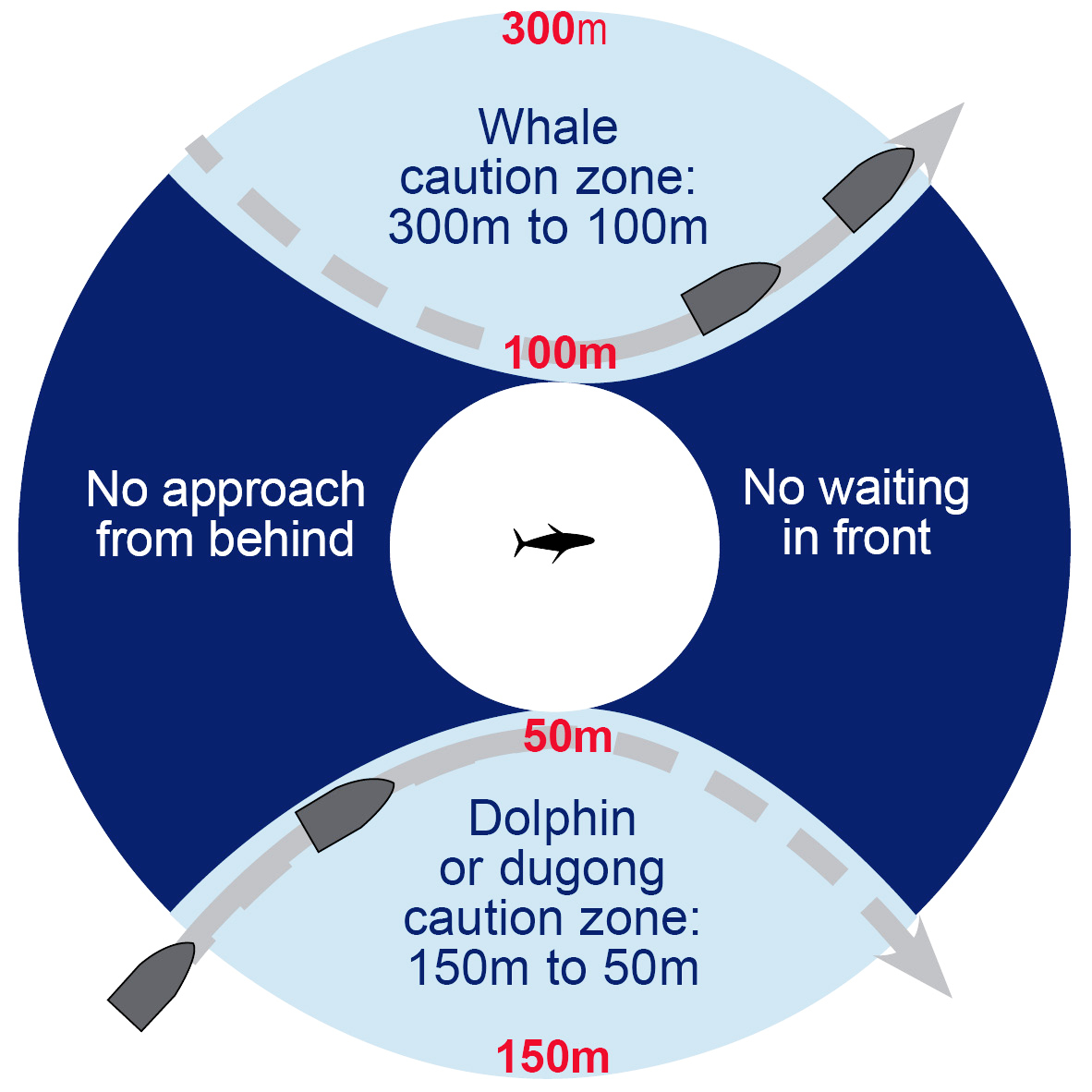
If dolphins are bow-riding, you must maintain course and speed.
If a whale approaches, slow down to minimal wash speed, move away or disengage gears and do not make sudden movements.
Approaching on the water – prohibited vessels
Prohibited vessels include personal motorised watercraft (jet skis), parasail boats, hovercraft, hydrofoils, wing-in-ground effect craft, remotely operated craft or motorised diving aids like underwater scooters.
These vessels are prohibited because they can make fast and erratic movements and not much noise underwater, so there is more chance they may collide with a marine mammal.
If you are approaching a marine mammal using a jet ski or other prohibited vessel you must have negligible wake and stay at least 300 metres from a whale, dolphin or dugong.
Approaching from the air – aircraft including drones
To observe a marine mammal from the air, you must approach it from behind, not hover over it and not land on the water to observe it. The pilot must also comply with Civil Aviation Safety Authority (CASA) requirements.
The approach distances for different types of aircraft are:
- 100 metres for drones (also known as RPAs and UAVs)
- 300 metres for fixed-wing aircraft
- 500 metres for helicopters and gyrocopters.
The approach distance for aircraft is the height above a marine mammal and the horizontal distance away from it.
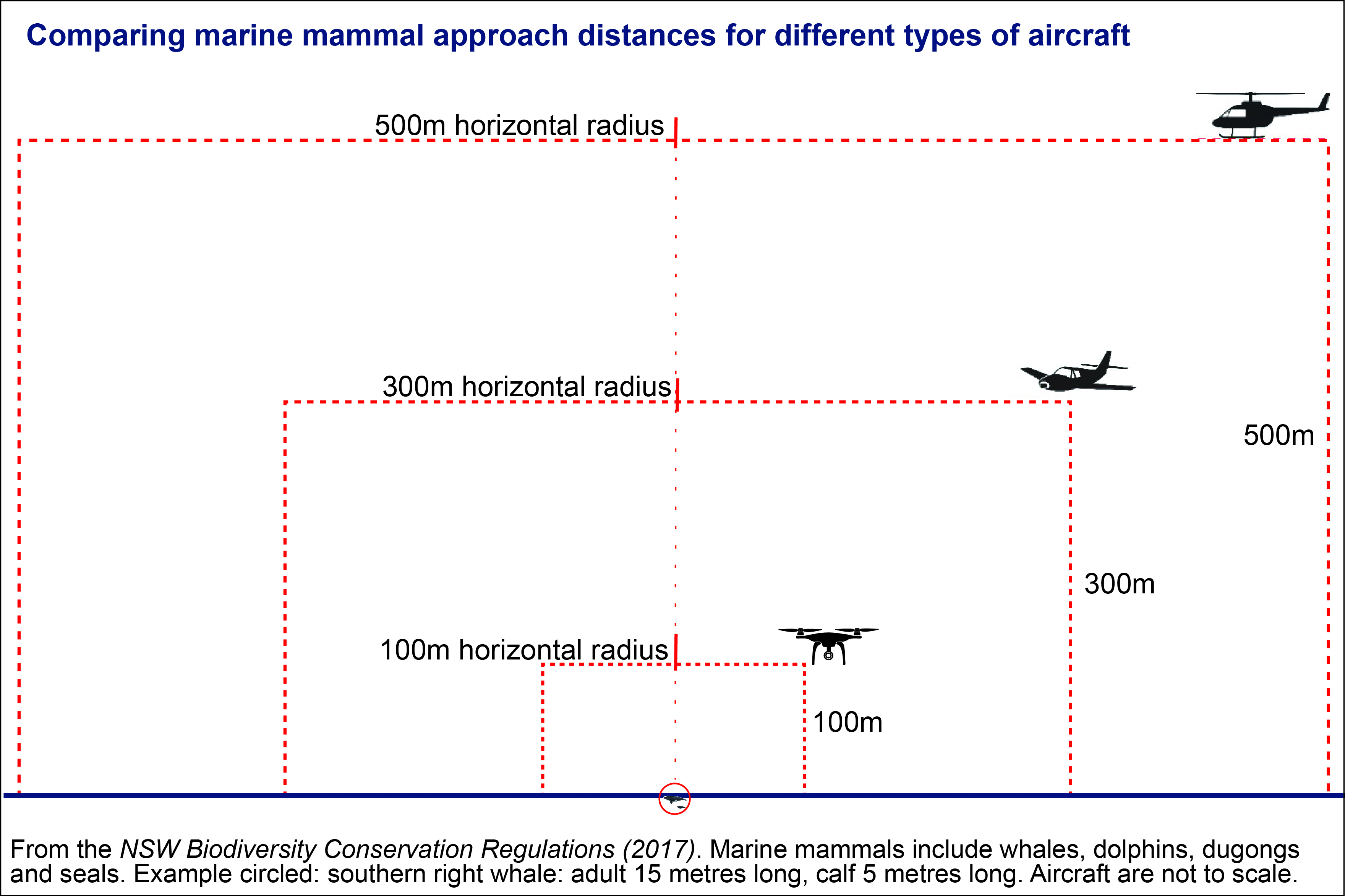
If you go closer than the approach distance, you have entered the no-fly zone. The no-fly zone for aircraft over a marine mammal can be imagined as an approach distance cylinder.
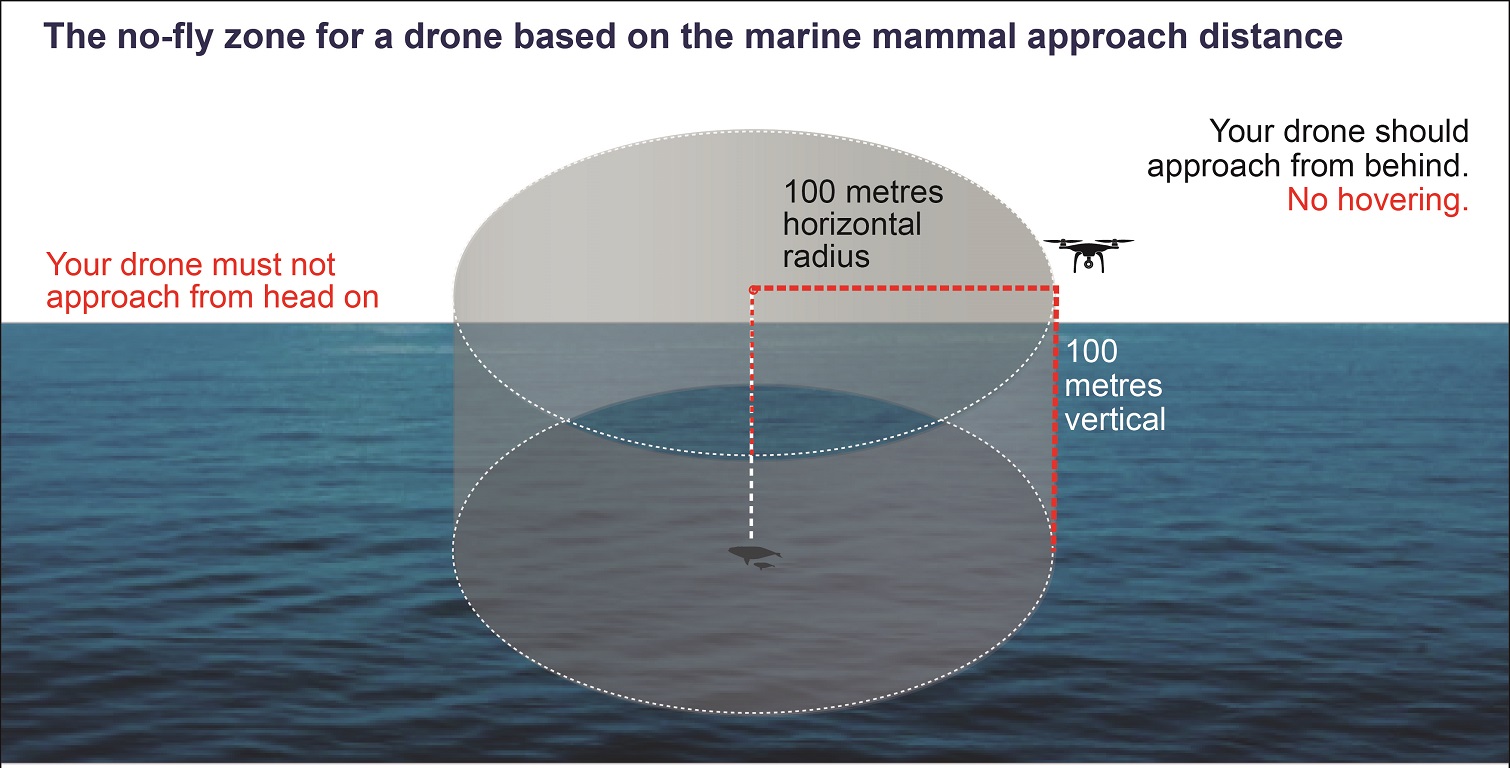
The 'no-fly zone' is shaped like a cylinder and moves with the whale, dolphin, dugong or seal. A drone can fly a minimum of 100 metres vertically over, and 100 metres horizontally around a marine mammal. A drone is not permitted to cut through the no-fly space. The aircraft is not to scale. Based on NSW Biodiversity Conservation Regulations (2017).
A drone pilot needs skill, understanding of the regulations and environmental awareness to lawfully approach a marine mammal. The drone pilot must always be in visual line of sight with the drone, not create any hazards and not cause harm to wildlife.
Listen for wildlife distress calls. If birds are disturbed, the pilot is advised to abandon the flight for 5 minutes, land and consider an alternate launch site or wait until birds of prey have left the area, or nesting birds have resettled, then try again.
Seek permission to launch from the landholder or land manager and follow all instructions. Do not launch from or fly over a national park without permission.
Seals
A seal may look like it is yawning but is actually baring its teeth as a warning sign.
Approach distances for seals are based on where the seal is located and if a pup is present. A seal is considered a pup if it is up to half the length of the adult.
If a seal comes towards you, you must move back to the minimum approach distance.
Approaching a seal when it is in the water
Seals are agile swimmers with strong flippers. When a seal is in the water you must keep at least:
- 10 metres away from the seal
- 80 metres from a seal pup
- 100 metres for a drone.
If you are also in or on the water and a seal approaches you, stay calm and move away slowly. If bitten or scratched, seek immediate medical advice.
Approaching a seal when it is hauled out on land
Seals haul out to rest after foraging at sea.
If a seal feels threatened, it may show aggression by yawning, waving its front flipper or head, or calling out. Seals are very agile and can move fast on land, using all 4 limbs to run. When a seal is hauled out on the land you must keep at least:
- 40 metres away from the seal
- 80 metres from a seal pup
- 100 metres away from the seal for a drone.
Seals can often have injuries that look quite alarming but will heal well without needing veterinary assistance.
If you are concerned call National Parks and Wildlife on 13000 PARKS (1300 072 757), or Organisation for the Rescue and Research of Cetaceans in Australia on 02 9415 3333 for the animal to be checked and monitored.
Vessels watching seals resting on the rocky shore must also keep back 40 metres or 80 metres if a pup is present. Limit the time you spend watching because it can be stressful for them. It is likely you are not the only vessel to approach them that day.
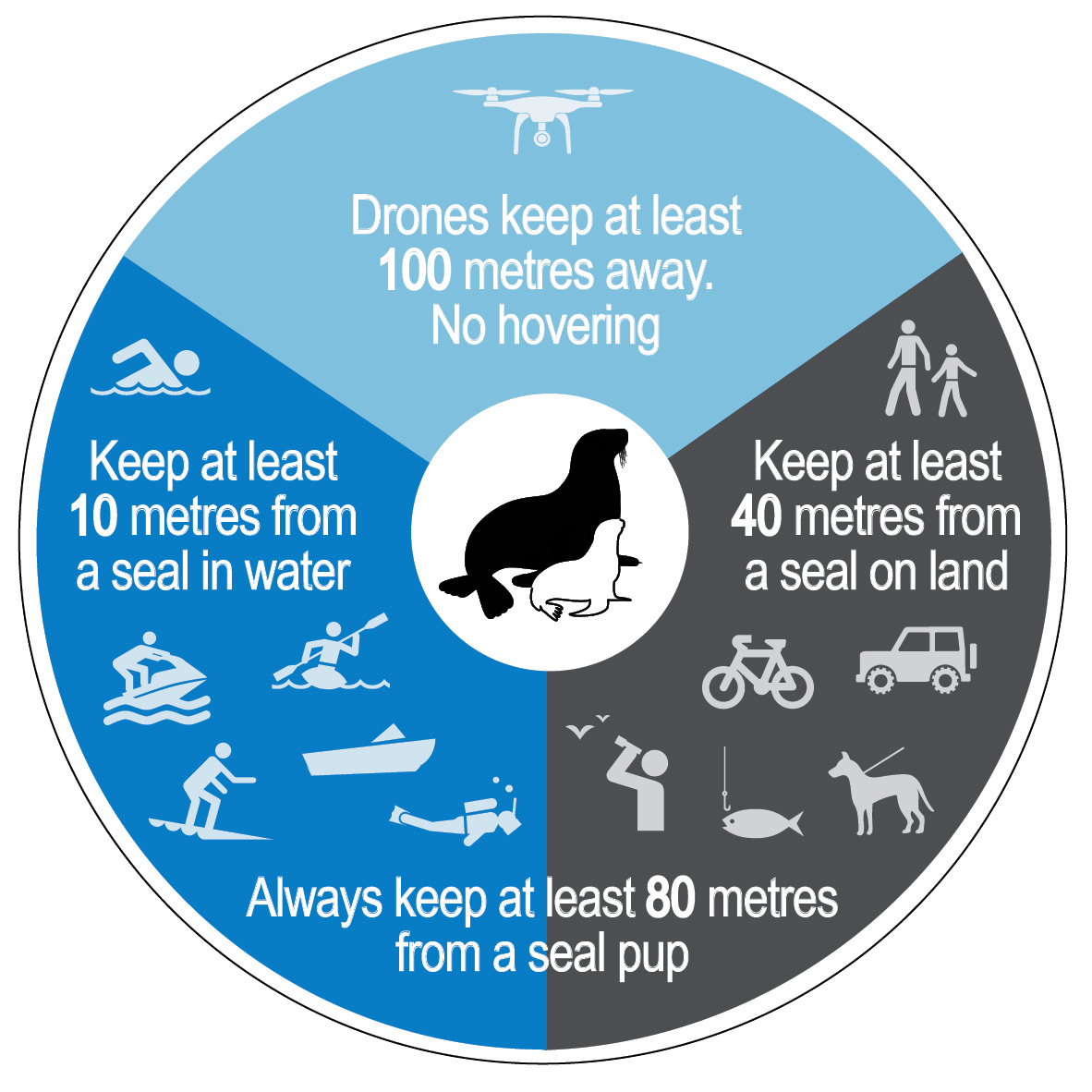
For more information on approach distances, please visit the NSW Environment website.
For information on whale watching vantage points along the South Coast’s National Parks and Reserves, visit the NPWS website.
Keep your dog restrained
With marine mammal populations slowly recovering in New South Wales, there is an increased chance that you will come across one when walking on a break wall or jetty. Keep your dog on a leash to avoid an unexpected encounter. This will reduce stress for the animal and reduce the chance of your dog being bitten. Dogs can transfer diseases to seals and vice versa.
A reminder that it is illegal to take dogs into National Parks.
Entangled whale, dolphin or seal
If you see an entangled animal:
- Watch from a distance, do not approach or enter the water or attempt to disentangle it.
- Immediately report it to:
- National Parks and Wildlife on 13000 PARKS (1300 072 757)
- Organisation for the Rescue and Research of Cetaceans in Australia on 02 9415 3333
Note the time, your location, the whale's direction of travel and speed.
Observe from a safe distance to:
- look for injuries and identifying marks
- take photographs of the entangling material to help rescuers bring the most suitable gear to remove it
- try to keep watch until help arrives.
Images/infographics: DPE/PON
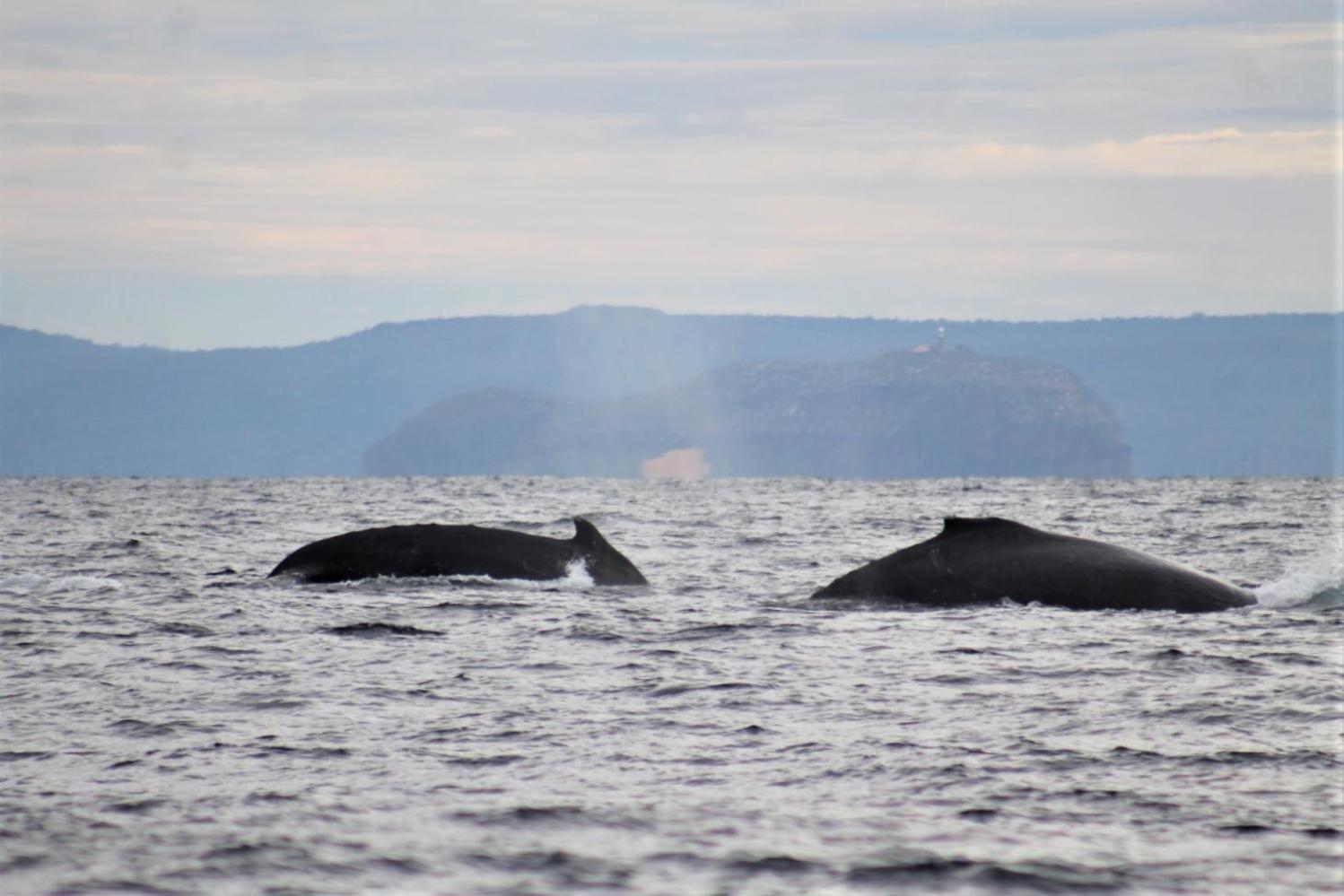
Liquid Amber Seed Pod/Fruits On Roads + Verges At Present: Please Clear These To Prevent Bird Road Deaths - Australian Wildlife Now Eating Fruits - Seeds Of Imported Species
Residents have asked that everyone be aware that the north American liquid amber tree is shedding its seed pod/fruits at present and our native galahs, pigeons and the rainbow lorikeet will descend on these as a flock to eat them. When these trees have been planted on verges the seed pods attract large numbers of these other local residents into roads where they will sit there eating and be susceptible to car strikes. Each year we lose numerous local birds due to this.
To help reduce the mortalities, please sweep the seed pods from the road if you have these outside your place.
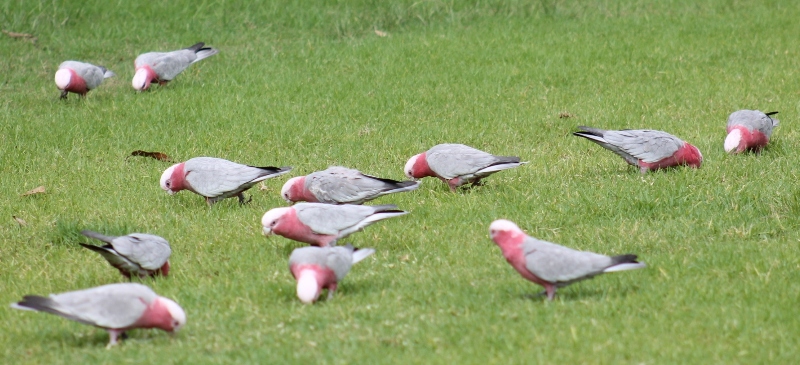
American sweetgum (Liquidambar styraciflua) is a deciduous tree in the genus Liquidambar native to warm temperate areas of eastern North America and tropical montane regions of Mexico and Central America. Sweetgum is one of the main valuable forest trees in the southeastern United States, and is a popular ornamental tree in temperate climates. The distinctive compound fruit is hard, dry, and globose, 25–40 mm (1–1+1⁄2 in) in diameter, composed of numerous (40–60) capsules.[14] Each capsule, containing one to two small seeds, has a pair of terminal spikes (for a total of 80–120 spikes). When the fruit opens and the seeds are released, each capsule is associated with a small hole (40–60 of these) in the compound fruit.
_--_Liquidambar_styraciflua.jpg?timestamp=1686254086507)
American sweetgum tree ball (spiny seed pod). Photo: Jim Evans
It is one of a those imported trees that produces seeds and fruits that Australian native birds have taken to eating.
People with olive trees report these being favoured by local parrots, including former Bayview and Narrabeen resident Ken 'Sava' Lloyd:
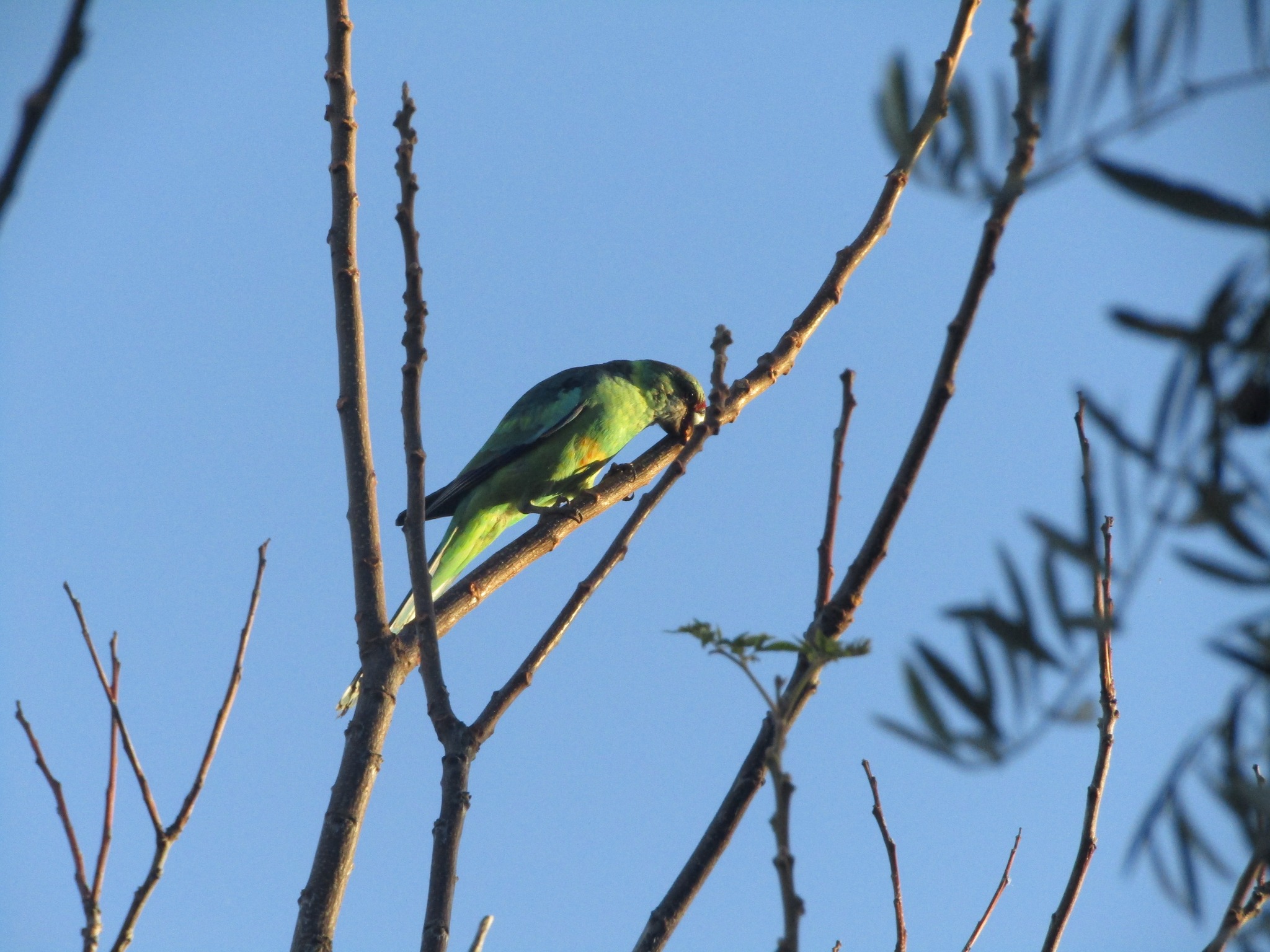
''I Interrupted this Mallee Ringneck Parrot from eating my olives, and she is not happy. All Types of Parrots are here at Gunnedah eating my Olives.'' - Ken Sava Lloyd, June 3, 2023
The Australian ringneck (Barnardius zonarius) is a parrot native to Australia. Except for extreme tropical and highland areas, the species has adapted to all conditions. Treatments of genus Barnardius have previously recognised two species, the Port Lincoln parrot (Barnardius zonarius) and the mallee ringneck (Barnardius barnardi) but due to these readily interbreeding at the contact zone they are usually regarded as a single species B. zonarius with subspecific descriptions. Currently, four subspecies are recognised, each with a distinct range. The Mallee Ringneck Parrot inhabits central and western New South Wales west of Dubbo, the southwestern corner Queensland west of St George, eastern South Australia and northwestern Victoria.
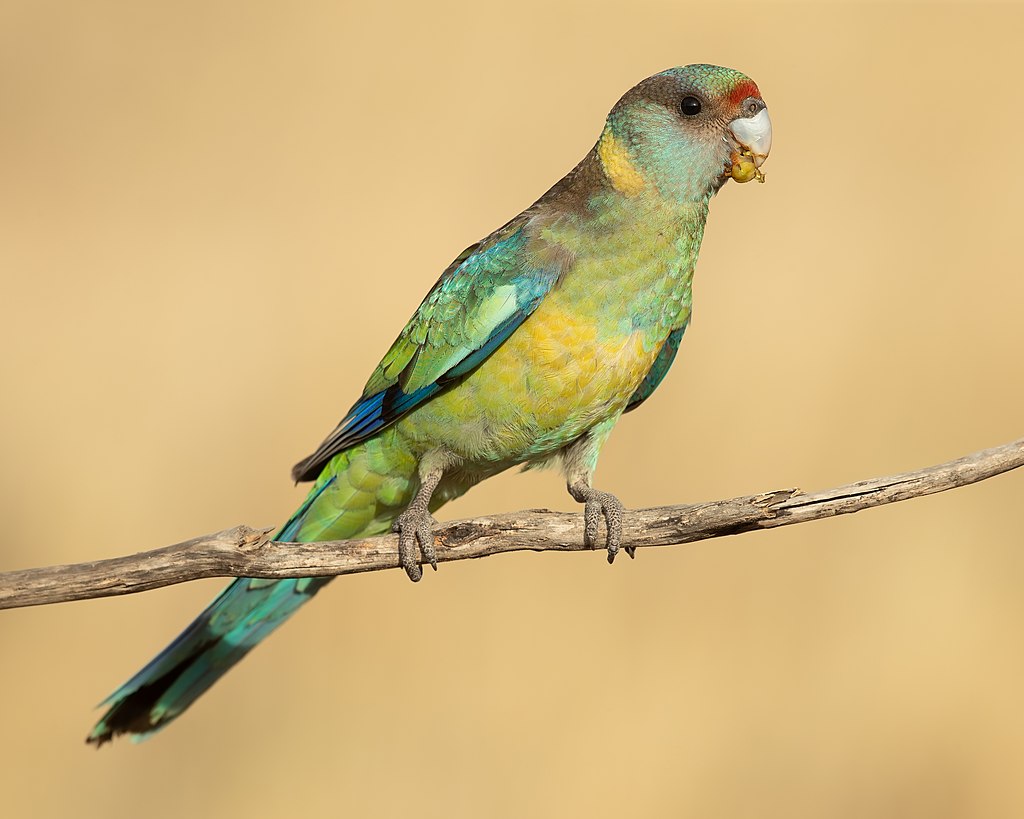
Mallee ringneck (Barnardius zonarius barnardi), Patchewollock Conservation Reserve, Victoria, Australia. Photo: JJ Harrison
The May 2023 round of the Ringtail Posse saw Nicole Romain, Founder Save The Northern Beaches Bushlands (Lizard Rock), choose the Yellow-Tailed Black Cockatoos Calyptorhynchus funereus as her favourite local wildlife species.
Yellow-tailed Black-Cockatoos were once content to feed on the seeds of native shrubs and trees, especially banksias, hakeas and casuarinas, as well as extracting the insect larvae that bore into the branches of wattles. Now, after the establishment of extensive plantations of exotic Monterey Pines, the cockatoos may feed more often by tearing open pine cones to extract the seeds in states further south where their preferred habitat and food trees have been destroyed. The population on South Australia’s Eyre Peninsula is now reliant on the seeds of the Aleppo Pine, a noxious weed, as its preferred habitat, as its Sugar Gum woodlands has become extensively fragmented.
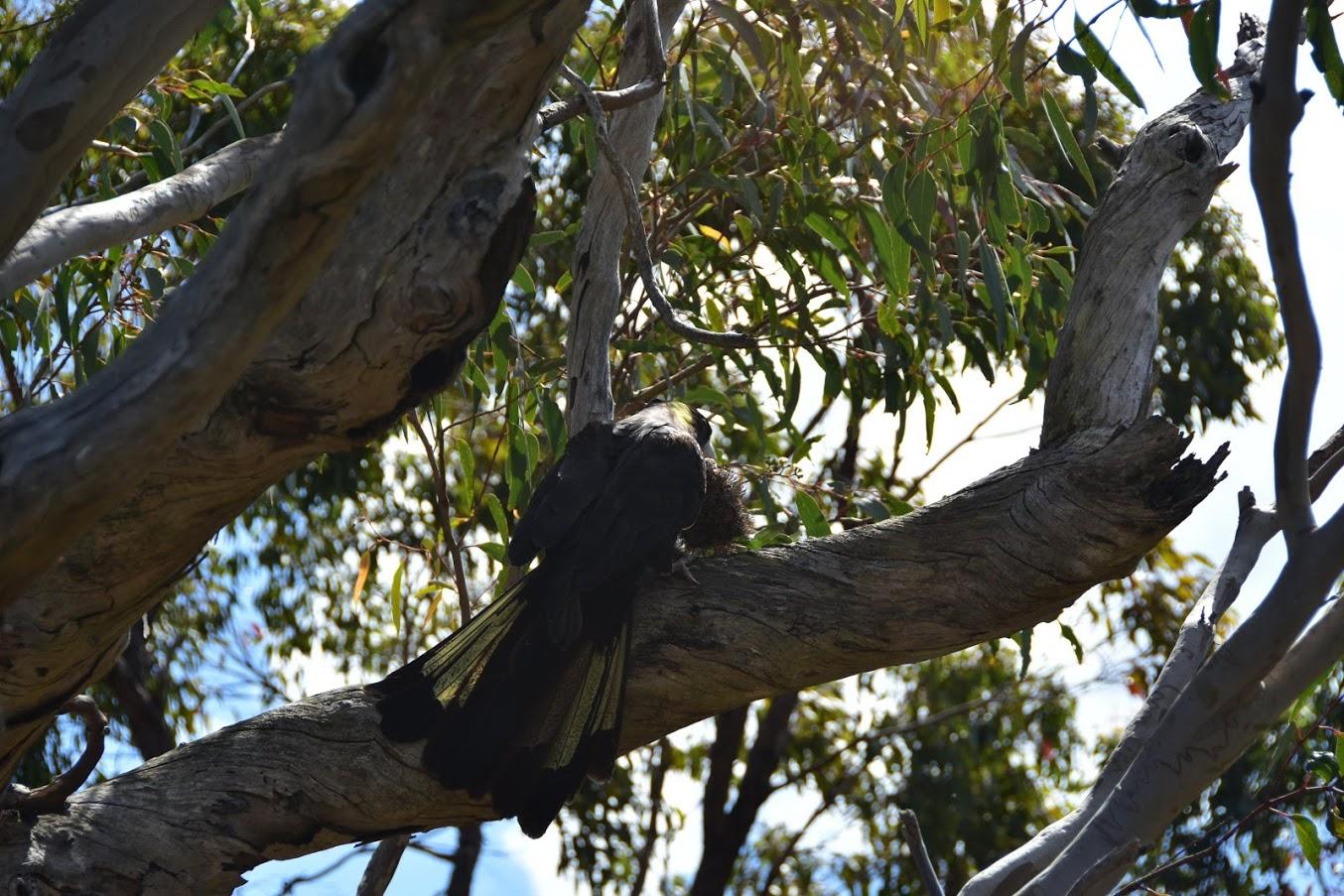
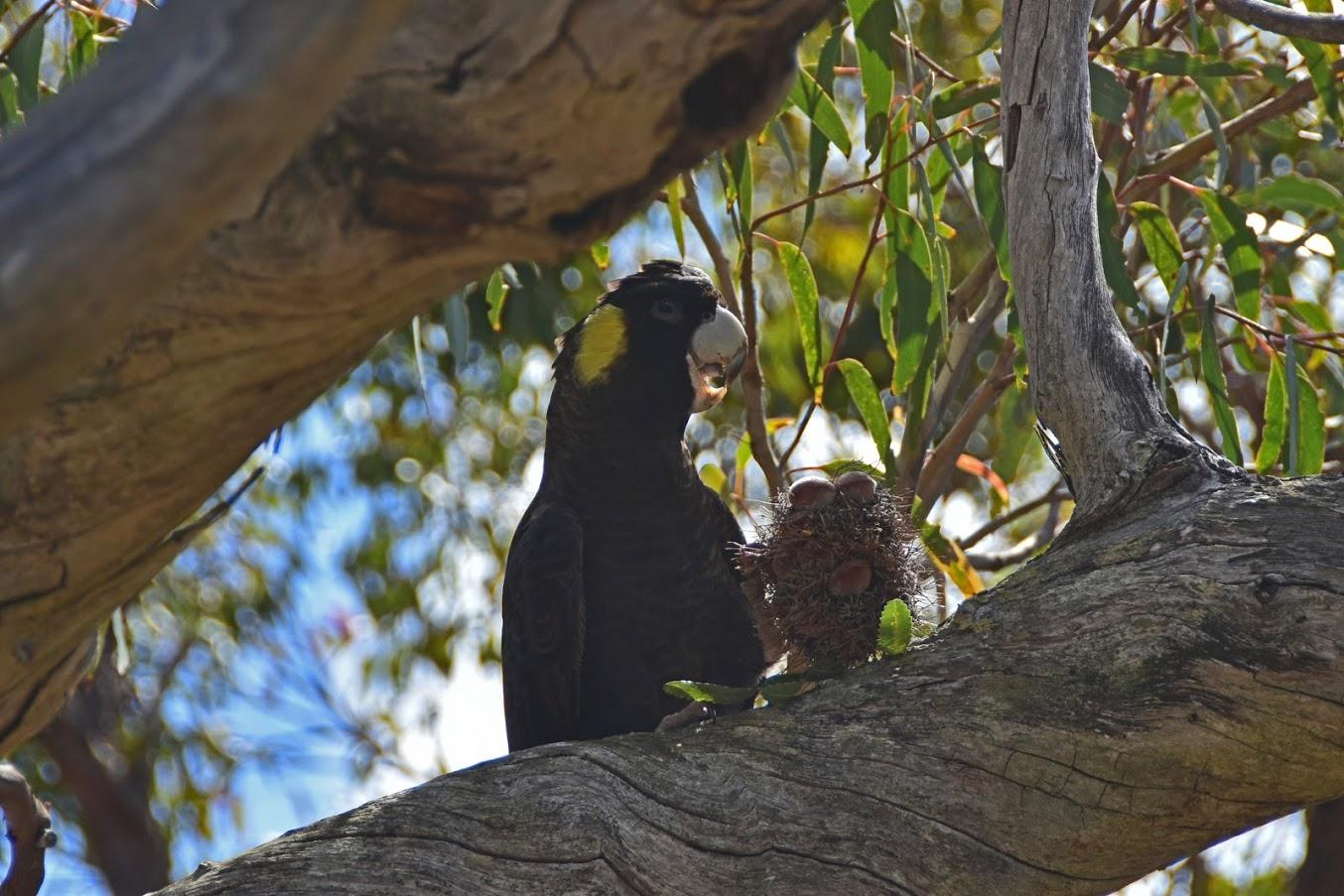
Yellow-tailed black cockatoos are one of two species of black cockatoos found in NSW. The other is the much less common south-eastern glossy black cockatoo, a species in decline, particularly after losing crucial habitat during the severe bushfires of 2019/2020, and listed as vulnerable nationally in August 2022.
The south-eastern glossy black cockatoo is a specialist eater and feeds on she oaks, which is why we will sometimes see them in Pittwater and why we need to stop cutting down their food; the trees.
Glossy Black-cockatoo, Calyptohynchus lathami, at Clareville - photo by Paul Wheeler, this species also visits McKay Reserve, Palm Beach, annually to feed on these trees
Areas Closed For West Head Lookout Upgrades
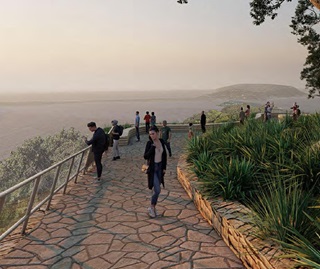 NPWS advise that the following areas are closed from Monday 22 May to Thursday 30 November 2023 while West Head lookout upgrades are underway:
NPWS advise that the following areas are closed from Monday 22 May to Thursday 30 November 2023 while West Head lookout upgrades are underway:
- West Head lookout
- The loop section of West Head Road
- West Head Army track.
Vehicles, cyclists and pedestrians will have access to the Resolute picnic area and public toilets. Access is restricted past this point.
The following walking tracks remain open:
- Red Hands track
- Aboriginal Heritage track
- Resolute track, including access to Resolute Beach and West Head Beach
- Mackeral Beach track
- Koolewong track.
The West Head lookout cannot be accessed from any of these tracks.
Image: Visualisation of upcoming works, looking east from the ramp towards Barrenjoey Head Credit: DPE
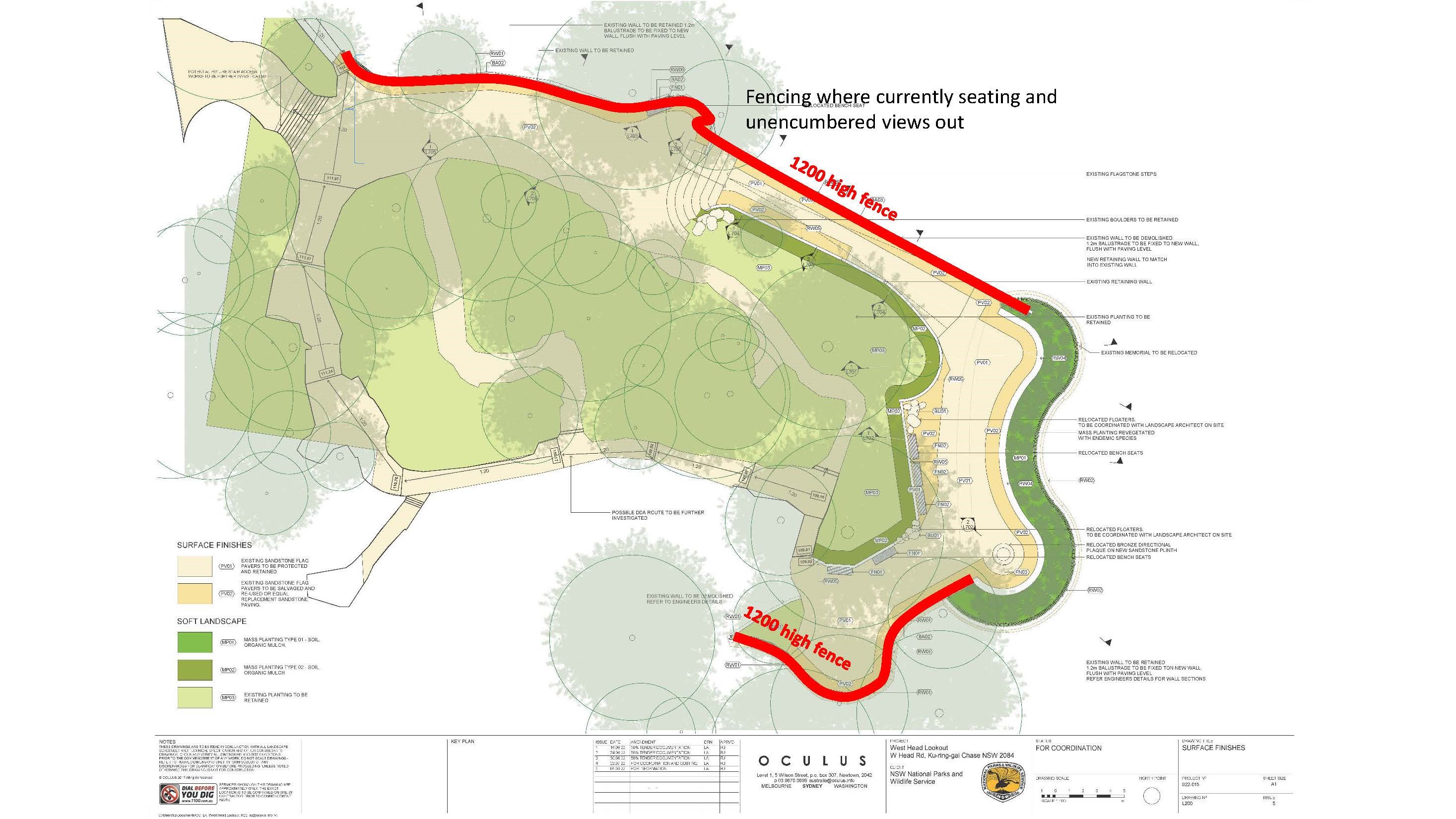
Avalon Dunes Bushcare: July 2023
Join us on Sunday July 2 for another satisfying morning making a difference while being in nature.
We meet on the first Sunday of each month at 8.30am
Facebook page for Avalon Dunes Bushcare where you can keep up to date with progress and find out how to get involved.
Visit: www.facebook.com/AvalonDunesBushcare
Photo: Salt tolerant tree Coast Banksia is in flower now. Unlike most Banksias, it sheds its seeds every summer, not relying on fire to open its seed capsules.
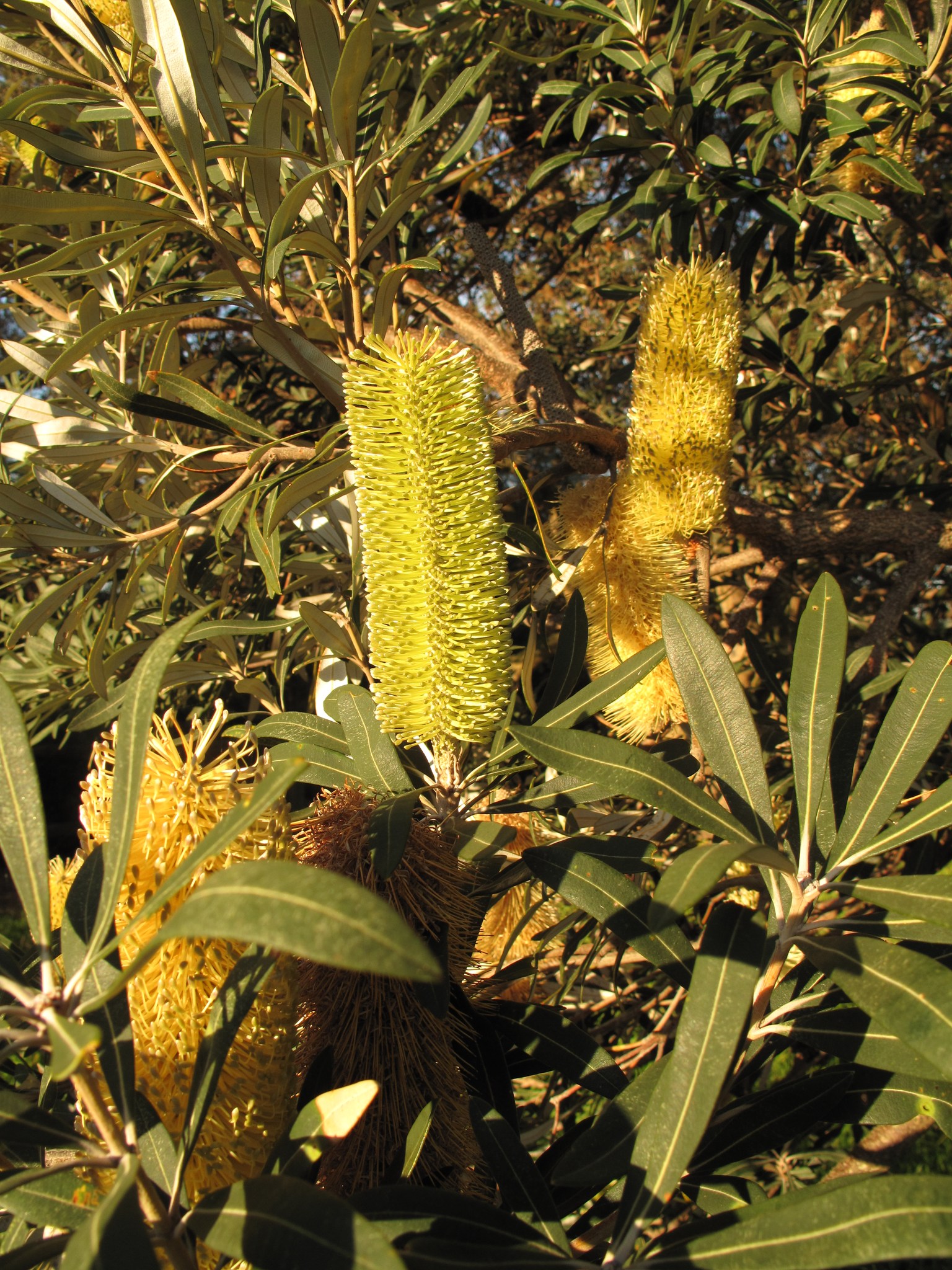
Time Of Burrugin
Cold and frosty; June-July
Echidna seeking mates - Burringoa flowering - Shellfish forbidden
This is the time when the male Burrugin (echidnas) form lines of up to ten as they follow the female through the woodlands in an effort to wear her down and mate with her. It is also the time when the Burringoa (Eucalyptus tereticornis) starts to produce flowers, indicating that it is time to collect the nectar of certain plants for the ceremonies which will begin to take place during the next season. It is also a warning not to eat shellfish again until the Boo'kerrikin (Acacia decurrens, commonly known as black wattle or early green wattle) blooms.
Eucalyptus tereticornis, commonly known as forest red gum, blue gum or red irongum, is a species of tree that is native to eastern Australia and southern New Guinea. It has smooth bark, lance-shaped to curved adult leaves, flower buds in groups of seven, nine or eleven, white flowers and hemispherical fruit.
Eucalyptus tereticornis was first formally described 1795 by James Edward Smith in A Specimen of the Botany of New Holland from specimens collected in 1793 from Port Jackson by First Fleet surgeon and naturalist John White. The specific epithet (tereticornis) is from the Latin words teres (becoming tereti- in the combined form) meaning "terete" and cornu meaning "horn", in reference to the horn-shaped operculum.
Habitat tree: Sclerophyll Forest.
Food tree: Natural stands are an important food tree for koalas and a wide variety of nectar-eating birds, fruit bats and possums.
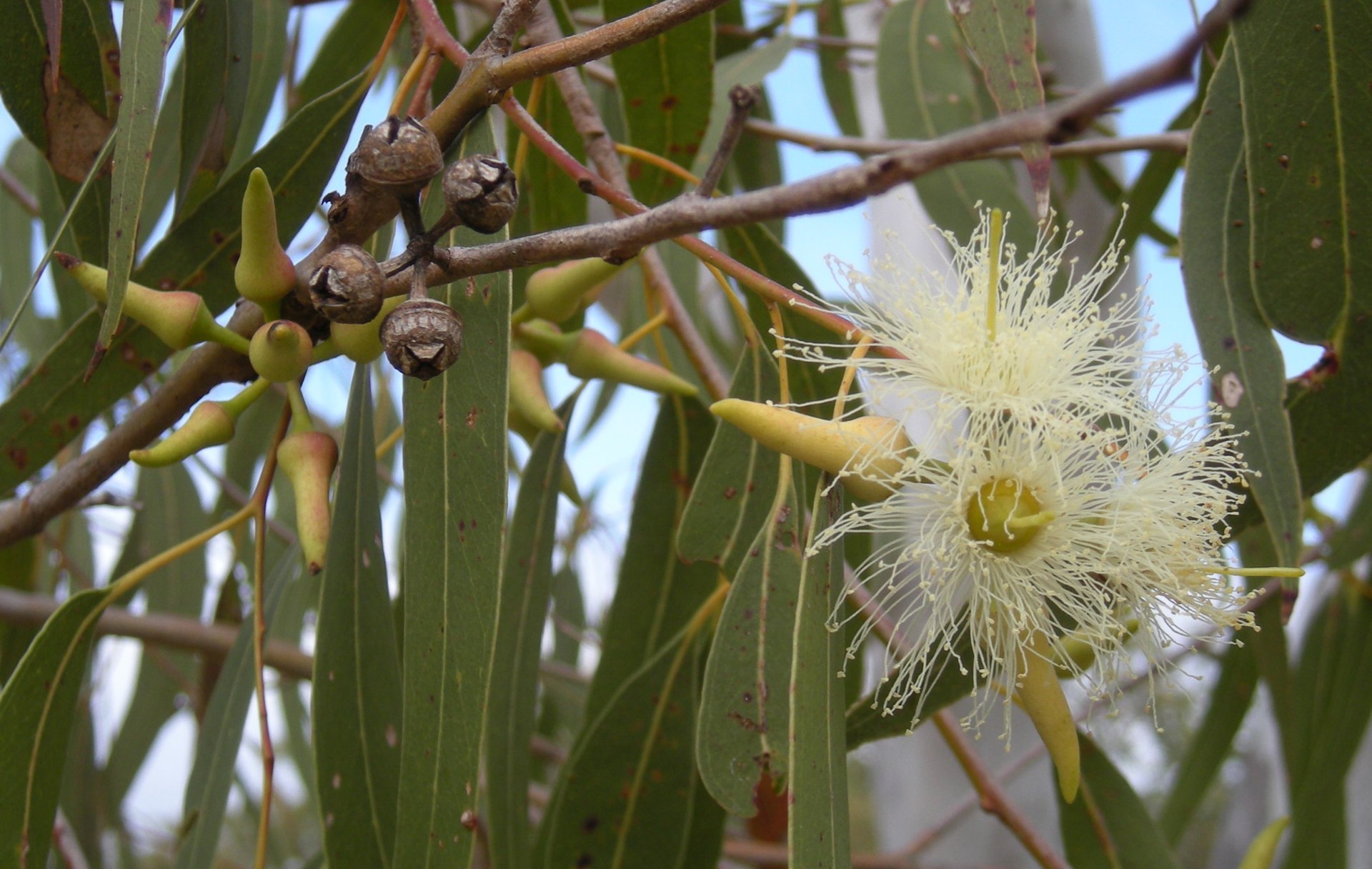
Eucalyptus tereticornis buds, capsules, flowers and foliage, Rockhampton, Queensland. Photo: Ethel Aardvark
Shelly Beach Echidna
Photos by Kevin Murray, taken late May 2023 who said, ''he/she was waddling across the road on the Shelly Beach headland, being harassed not so much by the bemused tourists, but by the Brush Turkeys who are plentiful there.''
Shelly Beach is located in Manly and forms part of Cabbage Tree Bay, a protected marine reserve which lies adjacent to North Head and Fairy Bower.
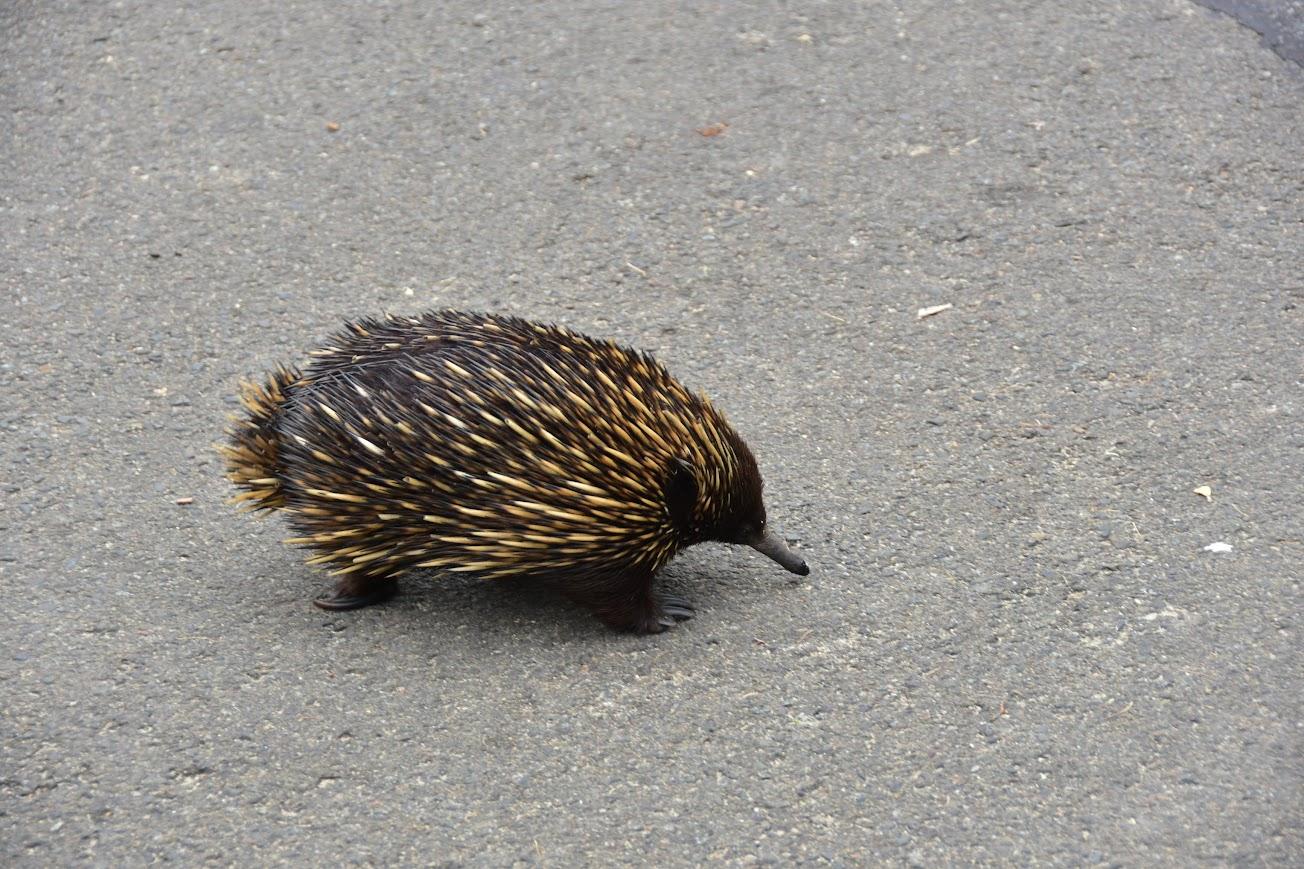
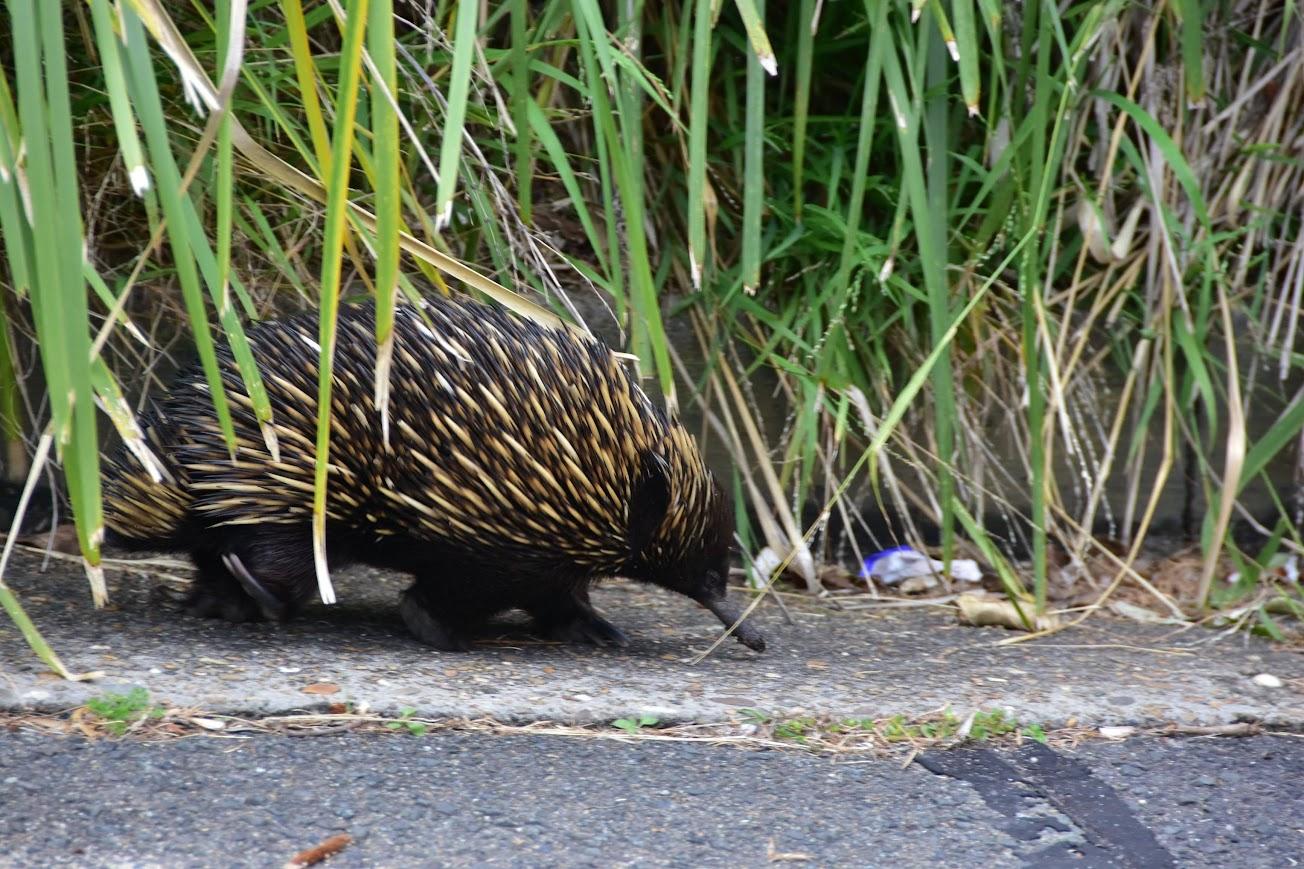
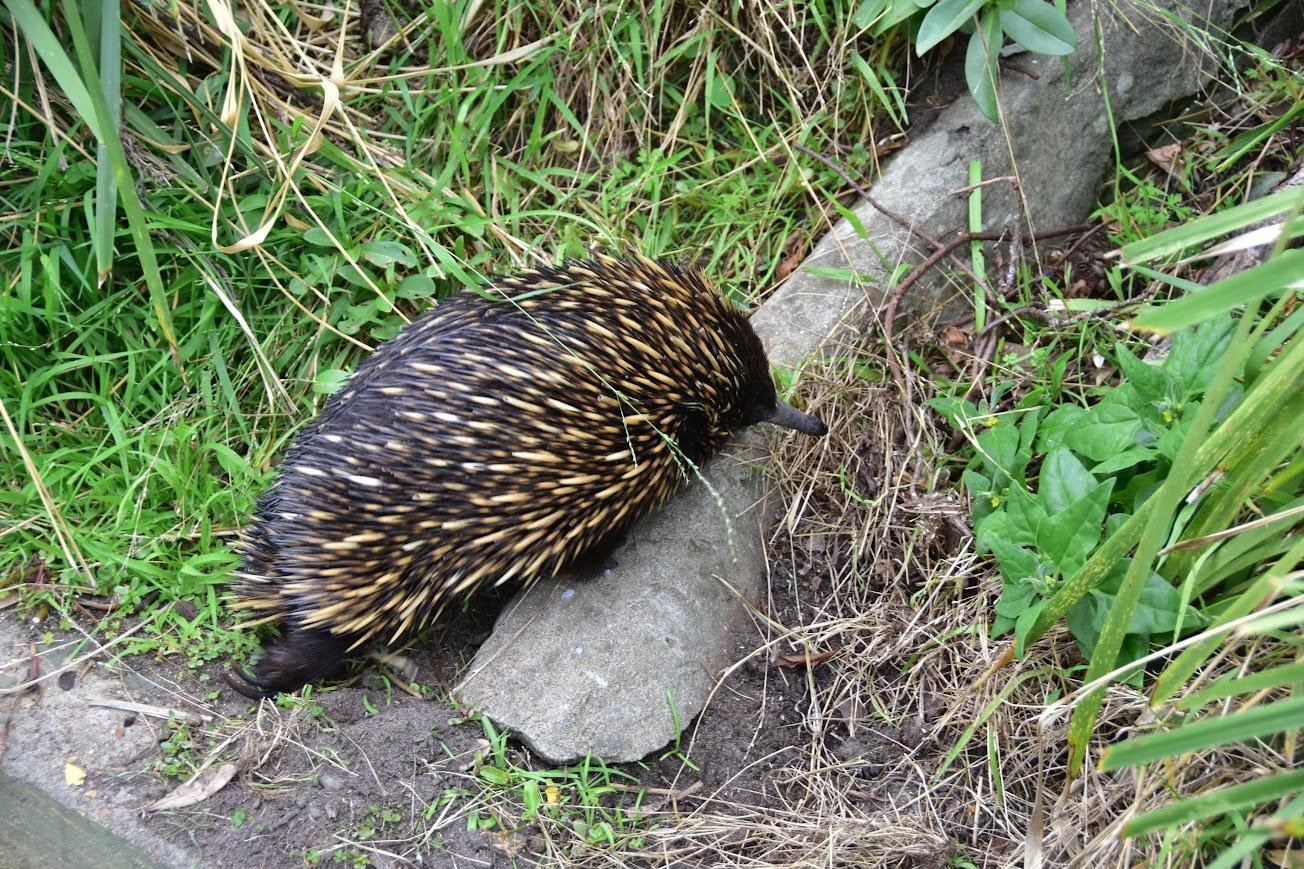
From the D'harawal calendar, BOM
D'harawal
The D'harawal Country and language area extends from the southern shores of Port Jackson (Sydney Harbour) to the northern shores of the Shoalhaven River, and from the eastern shores of the Wollondilly River system to the eastern seaboard.
Winter Solstice In New South Wales: June 22 2023
This year: Thursday, June 22, 2023 12:57 AM. In terms of daylight, this day is 4 hours, 31 minutes shorter than the December solstice. In locations south of the equator, the shortest day of the year is around this date. The earliest sunset is on 12 June or 13 June. The latest sunrise is on 30 June or 1 July.
The December solstice (summer solstice) in Sydney is at 2:27 pm on Friday, December 22, 2023.
The winter solstice is the day of the year that has the least daylight hours of any in the year and usually occurs on 22 June but can occur between 21 and 23 June.
An interesting idiosyncrasy relating to the summer solstice is that it does not feature the day with the earliest sunrise and latest sunset as is commonly expected. Similarly, on the winter solstice, the sunrise is not the latest and the sunset is not the earliest. However, this day does have the least amount of daylight hours.
Because the path of the Earth around the Sun is an ellipse, not a circle, and because the Earth is off-centre on its axis, these combined phenomena can create up to several minutes difference between solar and mean time. Around the date of summer solstice, these effects make the Sun appear to move slightly slower than expected when measured by a watch or clock. As a result, the earliest sunrise occurs before the date of the summer solstice, and the latest sunset happens after the summer solstice. For the same reasons, around the winter solstice, the time of sunrise continues to get later in the days after the solstice. - from/by Geoscience Australia
Protect Mona Vale's Bongin Bongin Bay - Establish An Aquatic Reserve
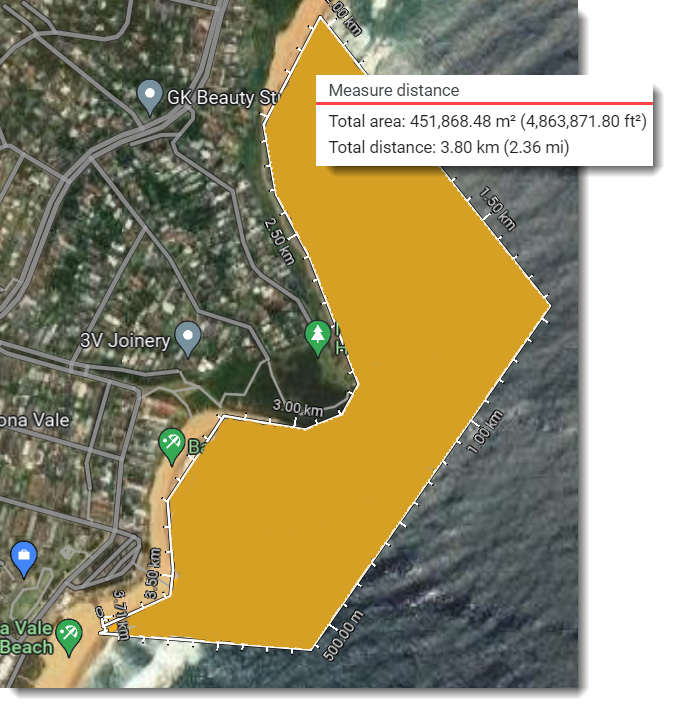

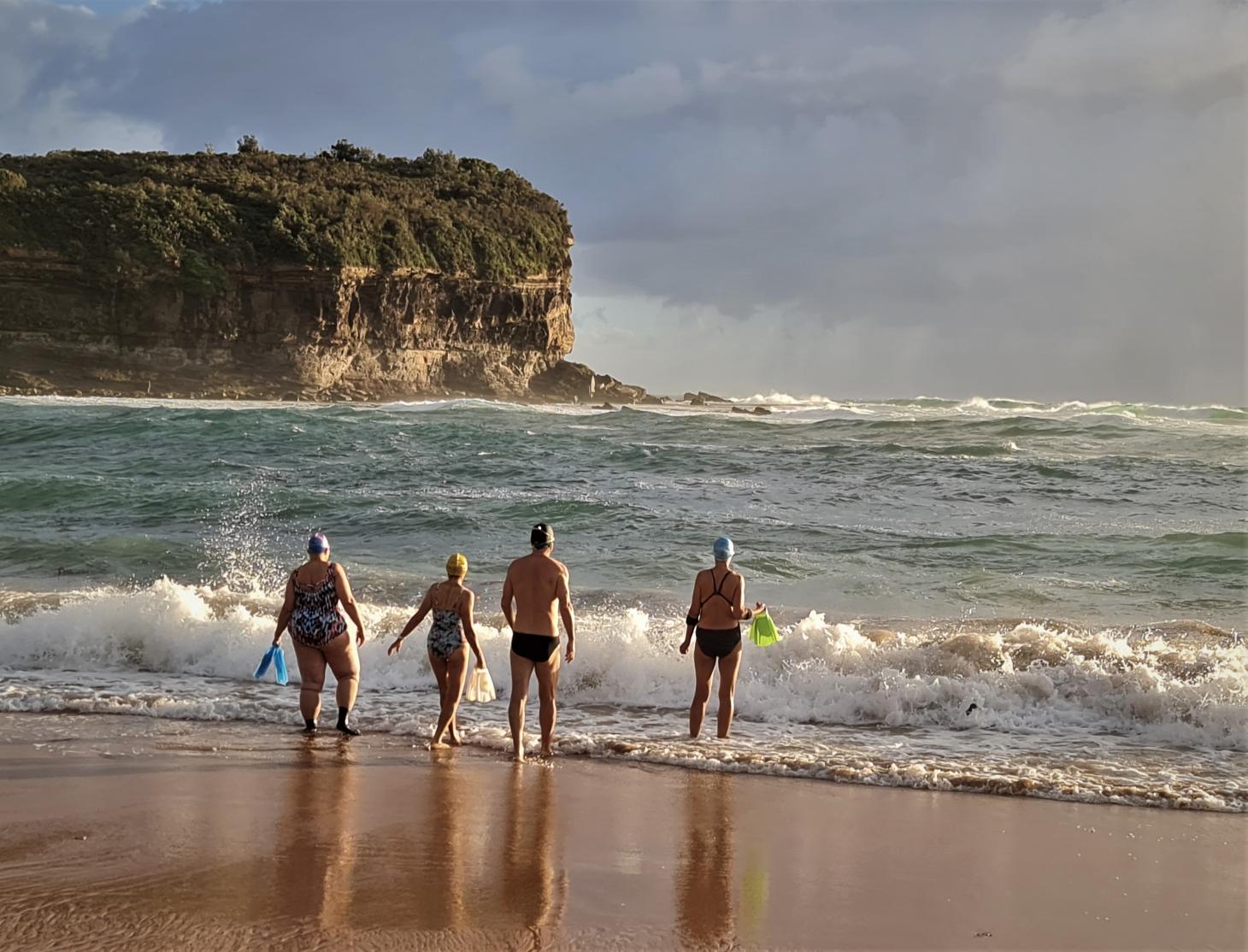
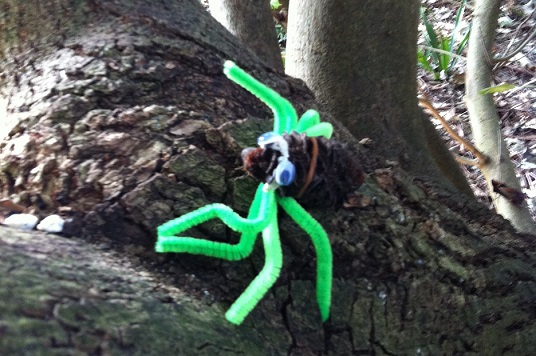 STONY RANGE BOTANIC GARDEN SATURDAY AFTERNOON BUSHCRAFT
STONY RANGE BOTANIC GARDEN SATURDAY AFTERNOON BUSHCRAFT
Northern Beaches Clean Up Crew: June 25 Winnererremy Bay, Mona Vale
Come and join us for our family friendly June clean up, in Winnererremy Bay on the Sunday June 25th at 10am. We meet in the grass area close to 7 Eric Green Drive. We have gloves, bags, and buckets, and grabbers. We're trying to remove as much plastic and rubbish as possible before it enters the water. Some of us can focus on the bush area and sandy/rocky areas, and others can walk along the water and even clean up in the water (at own risk).
We will clean up until around 11.15, and after that, we will sort and count the rubbish so we can contribute to research by entering it into a marine debris database. The sorting and counting is normally finished around noon, and we'll often go for lunch together at our own expense. We understand if you cannot stay for this part, but are grateful if you can. We appreciate any help we can get, no matter how small or big.
No booking required - just show up on the day - we will be there no matter what weather. We're a friendly group of people, and everyone is welcome to this family friendly event. It's a nice community - make some new friends and do a good deed for the planet at the same time. For everyone to feel welcome, please leave political and religious messages at home - this includes t-shirts with political campaign messages. Message us on our social media or send us an email if you are lost.
All welcome - the more the merrier. Please invite your friends too!
All details in our Facebook event or on our website.
Northern Beaches Clean Up Crew Facebook page: www.facebook.com/NorthernBeachesCleanUpCrew
Northern Beaches Clean Up Crew website: www.northernbeachescleanupcrew.com
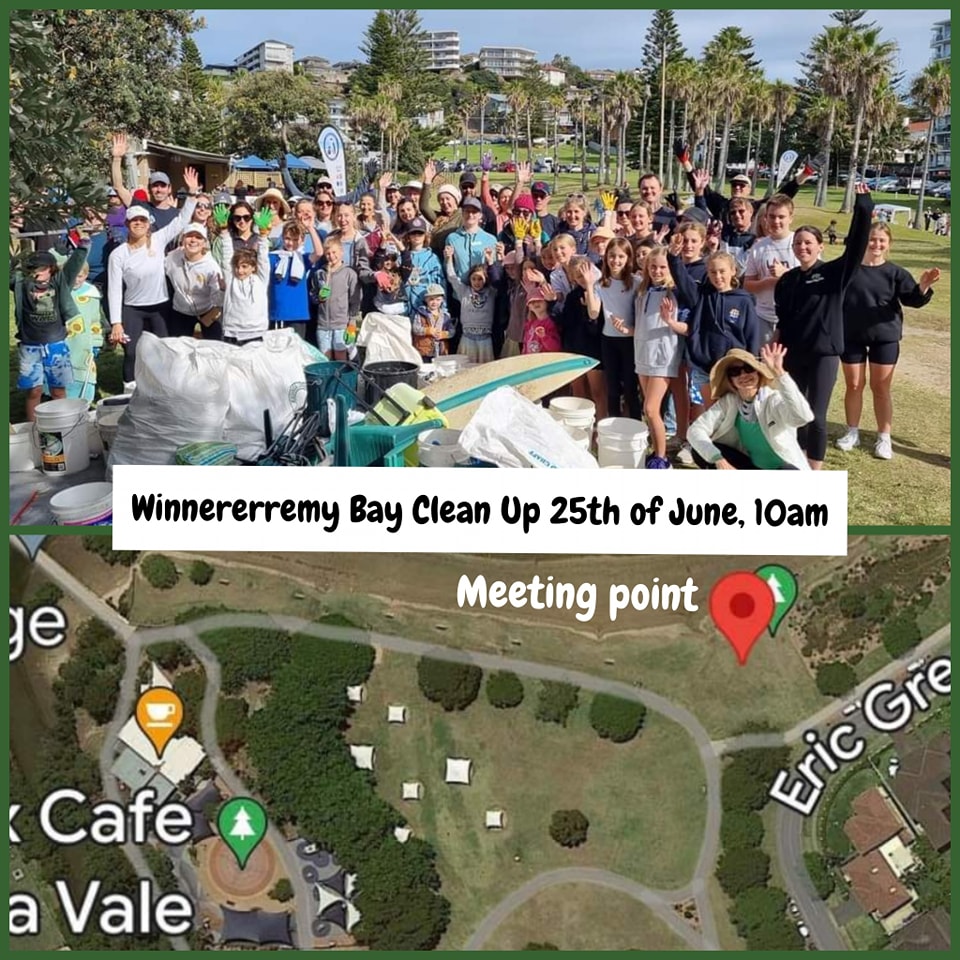
Freshwater Beach And Surrounds Clean Up
Done on Sunday May 28 2023
A huge thank you to everyone and cleaned up Freshwater Beach today. More than 100 people came and we are so happy and grateful to everyone who cares and helps making our beaches and local environment a better and cleaner place for all beings.
We had thousands of Styrofoam balls, about 30 single use coffee cups, nearly 90 plastic bottles, 164 glass bottles, 146 aluminium cans, 11 kilos of cardboard/paper, several surf boards, 127 cigarette butts, 3 broken plastic chairs, thousands of pieces of soft plastic and 22 balls among many of the items that we picked up.
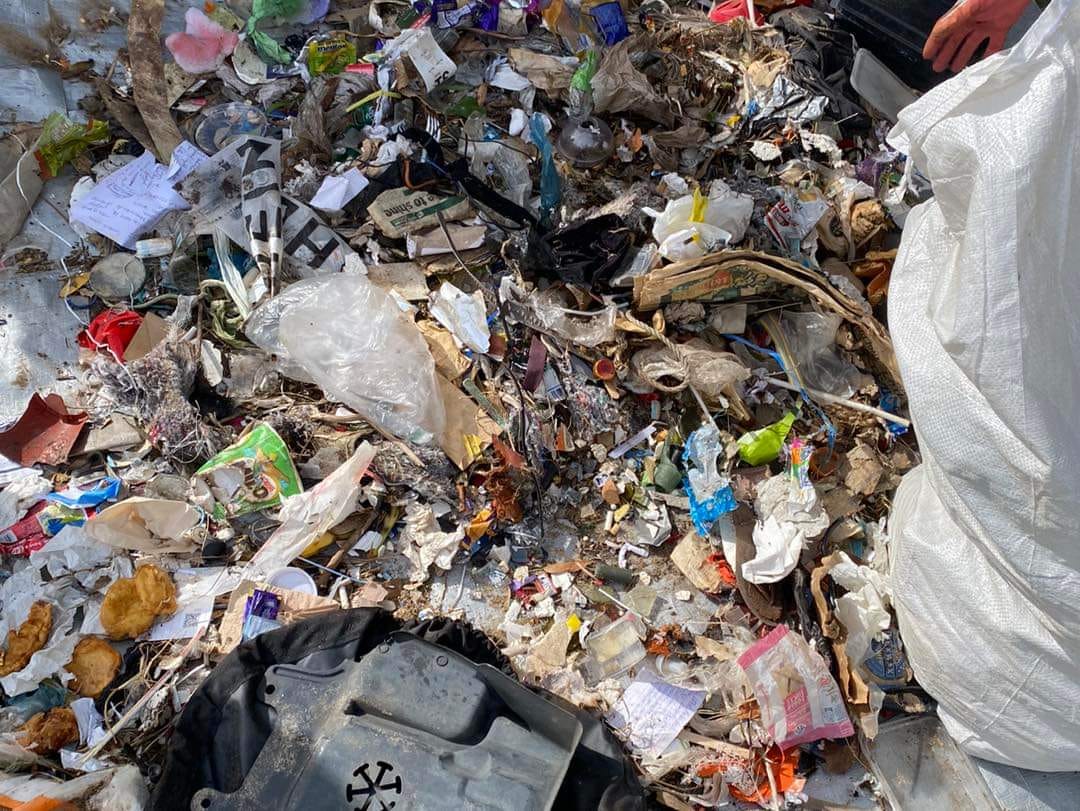
PNHA Guided Nature Walks 2023
Our walks are gentle strolls, enjoying and learning about the bush rather than aiming for destinations. Wear enclosed shoes. We welcome interested children over about 8 years old with carers. All Welcome.
Sunday June 25: Birdwatching and Bushland along Mullet Creek in Ingleside Chase Reserve
Swamp forest and coastal wetlands are rich habitat for fauna such as Swamp Wallaby and Diamond Python. Over 150 bird species have been recorded for the area. Red-Browed Finch is one.
Bring your binoculars and keep your ears pricked for bird calls. The track is mostly level, but with an optional steep climb near the Irrawong waterfall.
Meet: 8.30am near 31 Irrawong Rd North Narrabeen. Ends about 10.30.
So we know you’re coming please book by emailing: pnhainfo@gmail.com and include your phone number so we can contact you if weather is doubtful.
The whole PNHA 2023 Guided Nature Walks Program is available at: http://pnha.org.au/test-walks-and-talks/
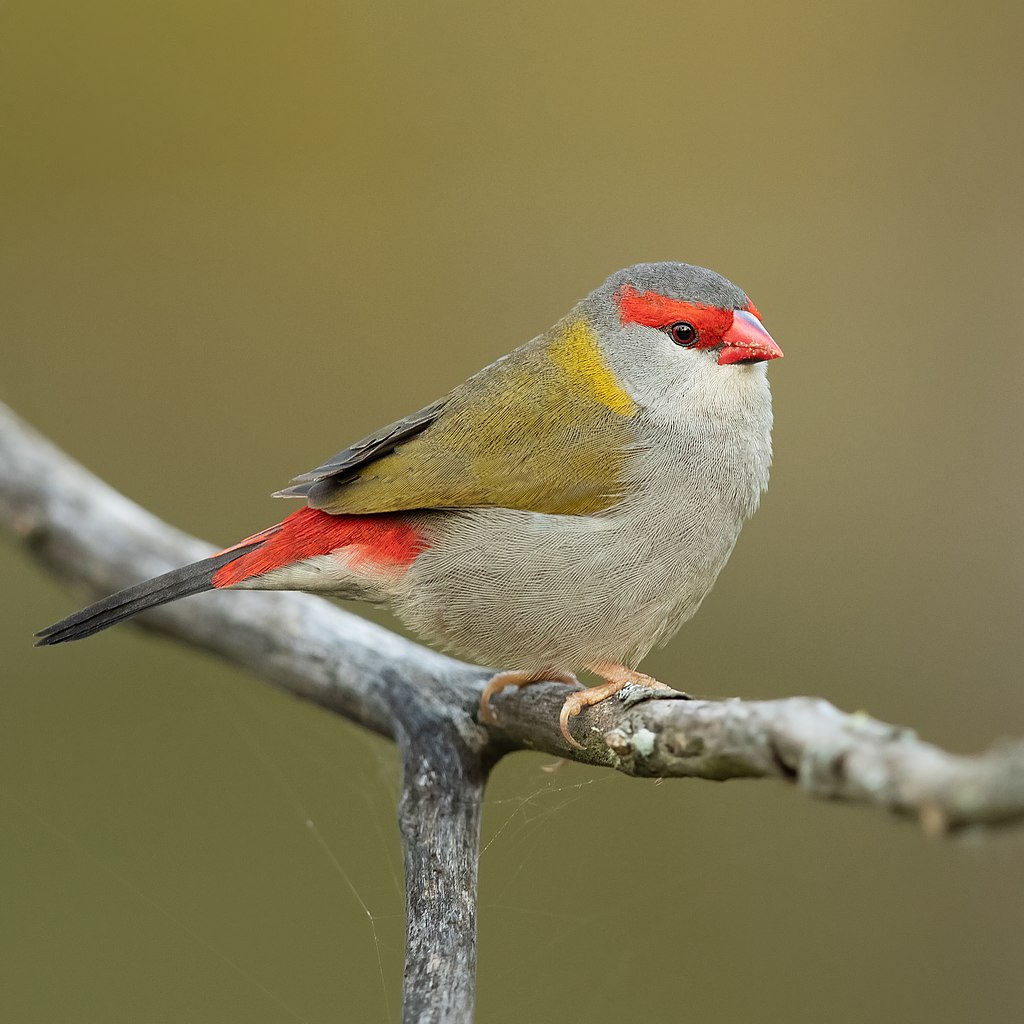
Red-browed finch (Neochmia temporalis). Photo: J J Harrison
Chemical CleanOut: June 2023
Mona Vale Beach Car Park: Sat 24, Sun 25 June 2023 - 9am-3:30pm
Surfview Road, Mona Vale
Only household quantities accepted. Maximum container size of 20kg or 20L per item.
*Up to 100L of paint (in 20L containers) now accepted at all Sydney, Hunter and Illawarra events.
Accepted:
Fluoro globes and tubes, Gas bottles and fire extinguishers, Household cleaners, Batteries, Paint*, Oils, Garden chemicals, Poisons, Smoke detectors.
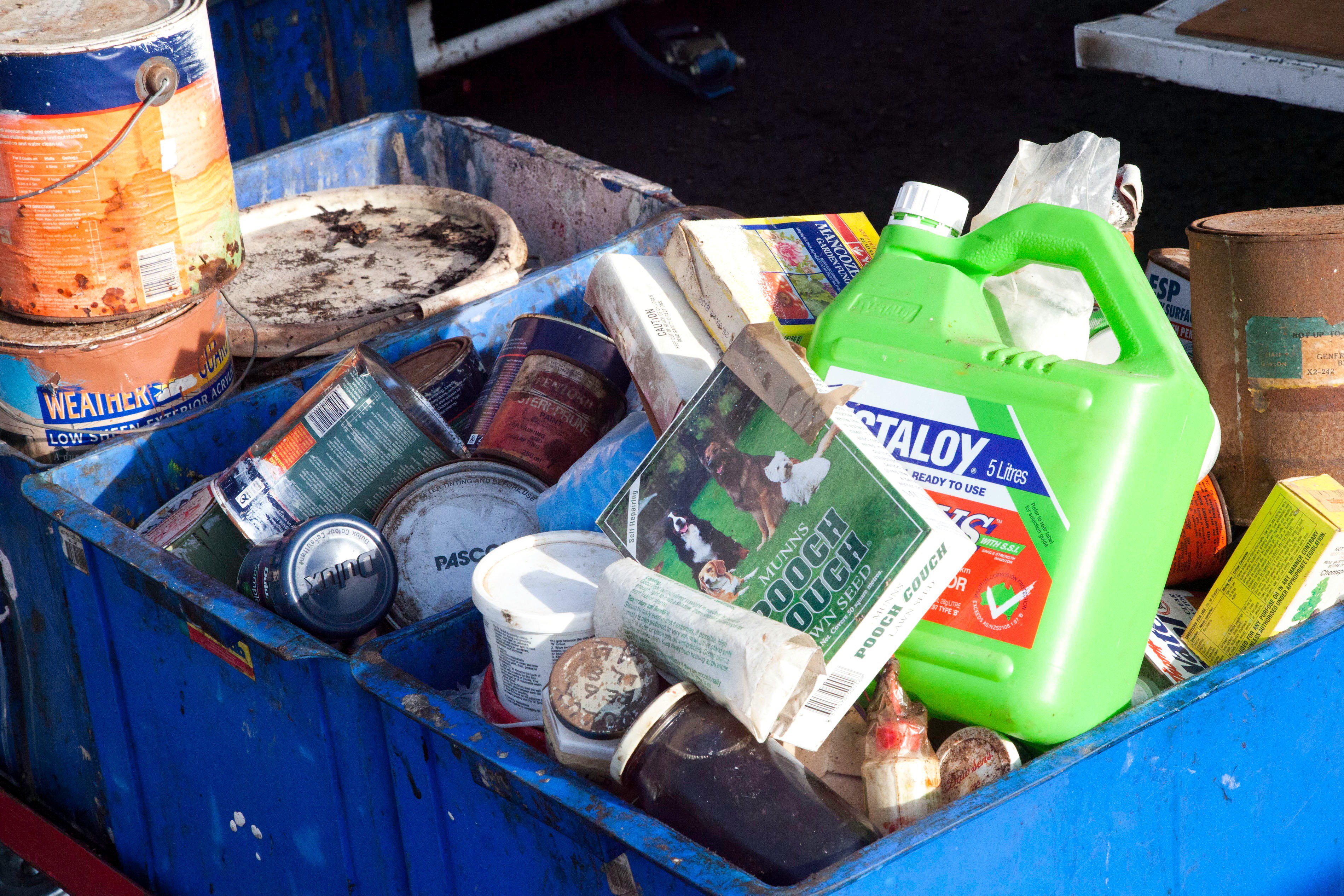
Permaculture NB: June To July 2023 Events
Permaculture Northern Beaches (PNB) is an active local group on Sydney's Northern Beaches working for ecological integrity and assisting you on a pathway to sustainability.
PNB holds monthly permaculture-related public meetings on the last Thursday of each month at the Narrabeen Tramshed Community & Arts Centre, Lakeview Room, 1395A Pittwater Road, Narrabeen. Buses stop directly at the centre and there is also car parking nearby. Doors open at 7:15 pm and meetings take place monthly from February to November.
Everyone is welcome!
We also hold a range of workshops, short courses, film and soup nights, practical garden tours, permabees (working bees), beehive installations, eco-product making sessions and much more.
CELEBRATING WORLD OCEANS DAY
Thursday, June 29, 2023: 7:30pm – 9:00pm
Narrabeen Tramshed Arts and Community Centre, Lakeview Room
1395A Pittwater Road, Narrabeen
Join us in World Oceans’ month to learn more about the Blue planet we live on.
Two great speakers will tell us the wonders and threats facing our oceans.
Australia Marine Conservation Society works on the big issues that risk our ocean wildlife - protecting critical ocean ecosystems with marine reserves around the nation, including Ningaloo and the Great Barrier Reef. As well as issues such as over-fishing and supertrawlers, and protecting threatened and endangered species like the Australian Sea Lion.
Surfrider Foundation is actively working to stop drilling and exploration for oil and gas off our coast (PEP2). The organisation works to protect our oceans, beaches and waves through a powerful activist network.
$5 entry by donation to pay for room hire. Organic teas and coffee are available at the night + swap table - bring plants, seeds, food, books and permaculture items to swap and share.
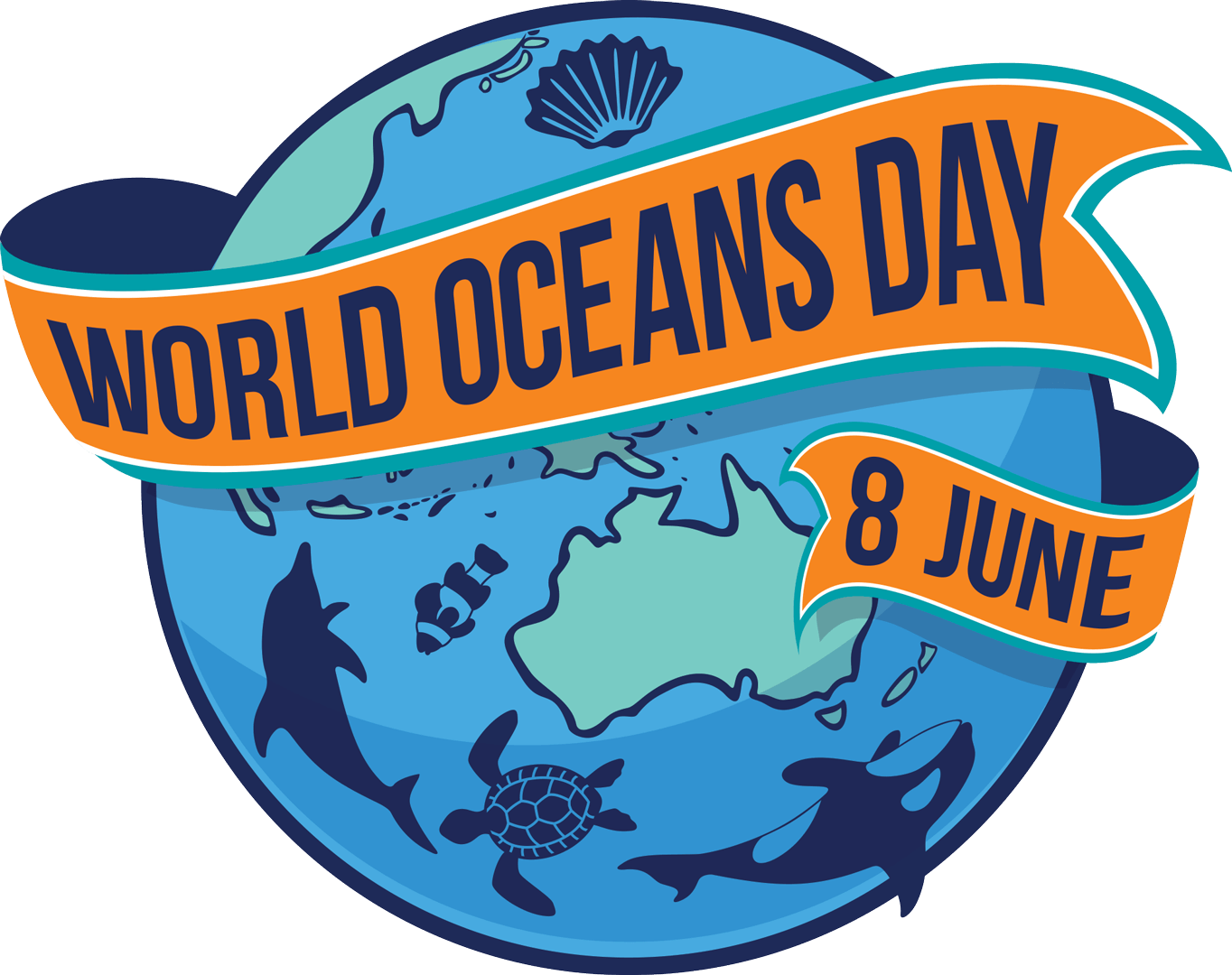
SEED SAVING CIRCLE
Saturday, July 8, 2023: 11:00am – 1:00pm
Balgowlah Community Garden
100 Griffiths Street, Balgowlah
Gather your seeds in winter for the coming spring. Share and swap seeds that are grown organically and locally. These seeds will be the best adapted you can find for the Northern Beaches climate and soils as many have been grown over generations.
Tap into the knowledge and the databank of seeds at Balgowlah Community Garden and PNB + share permaculture knowledge. This is an invaluable resource for the local community. Be part of the change - grow your own seeds and food.
Bring your non-alcoholic drinks and food to share on the day. The seed circle will be outdoors but under cover so dress weather-wise.
PLASTIC FREE JULY
Saturday, July 1, 2023 – Monday, July 31, 2023
Permaculture Northern Beaches is a part of the Plastic Free July challenge - Join Us!
The plastic bottles, bags and takeaway containers that we use for just a few minutes use a material that is designed to last forever. Every bit of plastic ever made still exists!
These plastics:
- Break up, not break down – becoming permanent pollution
- Are mostly made into low-grade products for just one more use or sent to a landfill
- End up in waterways and the ocean – where scientists predict there will be more tons of plastic than tons of fish by 2050
- Transfer to the food chain – carrying pollutants with them
- Increase our eco-footprint – plastic manufacturing consumes 6% of the world’s fossil fuels
Be part of the solution, by taking up these habits:
- Refusing plastic bags and packaging (choose your own alternatives)
- Reducing packaging where possible (opt for refills, remember your reusable shopping bags)
- Refusing plastics that escape as litter (e.g. straws, takeaway cups, utensils, balloons)
- Recycling what cannot be avoided by the use of alternatives.
Register to join 100,000 Australians and a million+ people worldwide stepping up in Plastic Free July www.plasticfreejuly.org
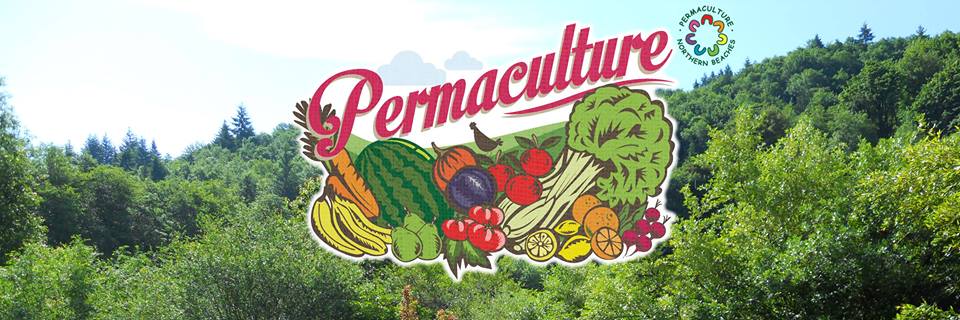
Bushcare In Pittwater
Where we work Which day What time
Avalon
Angophora Reserve 3rd Sunday 8:30 - 11:30am
Avalon Dunes 1st Sunday 8:30 - 11:30am
Avalon Golf Course 2nd Wednesday 3 - 5:30pm
Careel Creek 4th Saturday 8:30 - 11:30am
Toongari Reserve 3rd Saturday 9 - 12noon (8 - 11am in summer)
Bangalley Headland 2nd Sunday 9 to 12noon
Bayview
Winnererremy Bay 4th Sunday 9 to 12noon
Bilgola
North Bilgola Beach 3rd Monday 9 - 12noon
Algona Reserve 1st Saturday 9 - 12noon
Plateau Park 1st Friday 8:30 - 11:30am
Church Point
Browns Bay Reserve 1st Tuesday 9 - 12noon
McCarrs Creek Reserve Contact Bushcare Officer To be confirmed
Clareville
Old Wharf Reserve 3rd Saturday 8 - 11am
Elanora
Kundibah Reserve 4th Sunday 8:30 - 11:30am
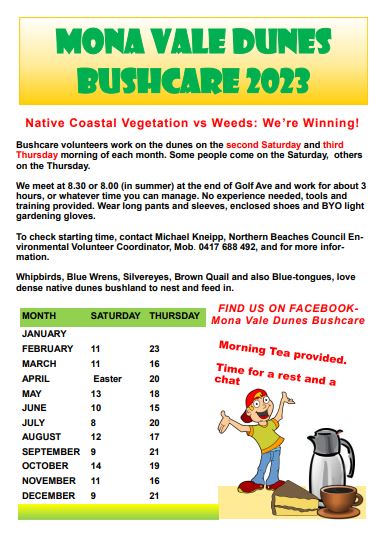 Mona Vale
Mona Vale Mona Vale Beach Basin 1st Saturday 8 - 11am
Mona Vale Dunes 2nd Saturday +3rd Thursday 8:30 - 11:30am
Newport
Bungan Beach 4th Sunday 9 - 12noon
Crescent Reserve 3rd Sunday 9 - 12noon
North Newport Beach 4th Saturday 8:30 - 11:30am
Porter Reserve 2nd Saturday 8 - 11am
North Narrabeen
Irrawong Reserve 2nd Saturday 2 - 5pm
Palm Beach
North Palm Beach Dunes 3rd Saturday 9 - 12noon
Scotland Island
Catherine Park 2nd Sunday 10 - 12:30pm
Elizabeth Park 1st Saturday 9 - 12noon
Pathilda Reserve 3rd Saturday 9 - 12noon
Warriewood
Warriewood Wetlands 1st Sunday 8:30 - 11:30am
Whale Beach
Norma Park 1st Friday 9 - 12noon
Western Foreshores
Coopers Point, Elvina Bay 2nd Sunday 10 - 1pm
Rocky Point, Elvina Bay 1st Monday 9 - 12noon
Friends Of Narrabeen Lagoon Catchment Activities

Gardens And Environment Groups And Organisations In Pittwater
Report Fox Sightings
%20(1).jpg?timestamp=1675893929686)
New Marine Wildlife Rescue Group On The Central Coast
A new wildlife group was launched on the Central Coast on Saturday, December 10, 2022.
Marine Wildlife Rescue Central Coast (MWRCC) had its official launch at The Entrance Boat Shed at 10am.
The group comprises current and former members of ASTR, ORRCA, Sea Shepherd, Greenpeace, WIRES and Wildlife ARC, as well as vets, academics, and people from all walks of life.
Well known marine wildlife advocate and activist Cathy Gilmore is spearheading the organisation.
“We believe that it is time the Central Coast looked after its own marine wildlife, and not be under the control or directed by groups that aren’t based locally,” Gilmore said.
“We have the local knowledge and are set up to respond and help injured animals more quickly.
“This also means that donations and money fundraised will go directly into helping our local marine creatures, and not get tied up elsewhere in the state.”
The organisation plans to have rehabilitation facilities and rescue kits placed in strategic locations around the region.
MWRCC will also be in touch with Indigenous groups to learn the traditional importance of the local marine environment and its inhabitants.
“We want to work with these groups and share knowledge between us,” Gilmore said.
“This is an opportunity to help save and protect our local marine wildlife, so if you have passion and commitment, then you are more than welcome to join us.”
Marine Wildlife Rescue Central Coast has a Facebook page where you may contact members. Visit: https://www.facebook.com/profile.php?id=100076317431064
- Ph: 0478 439 965
- Email: marinewildlifecc@gmail.com
- Instagram: marinewildliferescuecc

Watch Out - Shorebirds About
.JPG.opt1460x973o0,0s1460x973.jpg?timestamp=1663629195339)
Possums In Your Roof?: Do The Right Thing

Aviaries + Possum Release Sites Needed

Rare Bitterns Boom In Barmah-Millewa Forest
June 13, 2023
The endangered Australasian bittern is being heard in near-record numbers in the Barmah-Millewa Forest, giving hope for the species' long-term survival.
Around 30% of the nation's remaining bittern population is estimated to live in reedy wetland habitats in Barmah and Millewa. With only 1,300 individuals estimated to remain, this elusive night-calling, well-camouflaged bird is nationally endangered.
Impacts to wetlands due to changed watering regimes have contributed to their decline.
As part of The Living Murray (TLM) program, the NSW National Parks and Wildlife Service (NPWS) along with Victorian partners, have monitored the Barmah–Millewa Forest bittern population for the past seven years. Monitoring depends on identifying the series of deep growls or booms of males that travel across the wetlands when they're in search of a mate.
NPWS Project Officer Brady Cronin said the number of male bitterns calling this year was among the highest ever recorded.
"Monitoring data has identified changes in the timing of the bittern calling as a result of the 2022–23 flood, one of the largest of the decade, where water levels rose and dropped by around 3 to 4 metres in the Barmah–Millewa Forest," Mr Cronin said.
The NSW Government's Water for the Environment program is playing a critical role in supporting Australasian bittern population recovery within the inland wetland systems.
Senior Environmental Water Management Officer, Paul Childs, said the NSW Department of Planning and Environment's environmental water managers work with river operators to deliver water for the environment annually into sites where bitterns are known to breed.
"These flows are designed and timed to mimic the natural flow regime and provide ideal conditions for a range of other waterbirds and wetland-dependent plants and animals too."
Recent research conducted by Dr Elizabeth Znidersic and her team from the Gulbali Institute at Charles Sturt University has provided insight into the secretive life of the Australasian bittern by deploying sound recorders throughout the forest.
"The research shows that male Australasian bitterns started their breeding calls before the peak of the flood, stopped during the peak month, then resumed calling after flood waters slightly receded, and nesting habitat became available again." said Dr Znidersic.
To ensure bittern chicks successfully fledged so late in the season, additional water for the environment was delivered into the wetlands.
"This outcome highlights the importance of long-term monitoring that helps to inform the adaptive management of environmental water and site-based management activities such as predator control, which are essential components for building Australasian bittern populations" Mr Childs said.
The NPWS and Parks Victoria bittern project is funded by the Murray–Darling Basin Authority TLM program and the Victorian Government Sustainability Fund Community Action for Biodiversity (Icon Species) project.
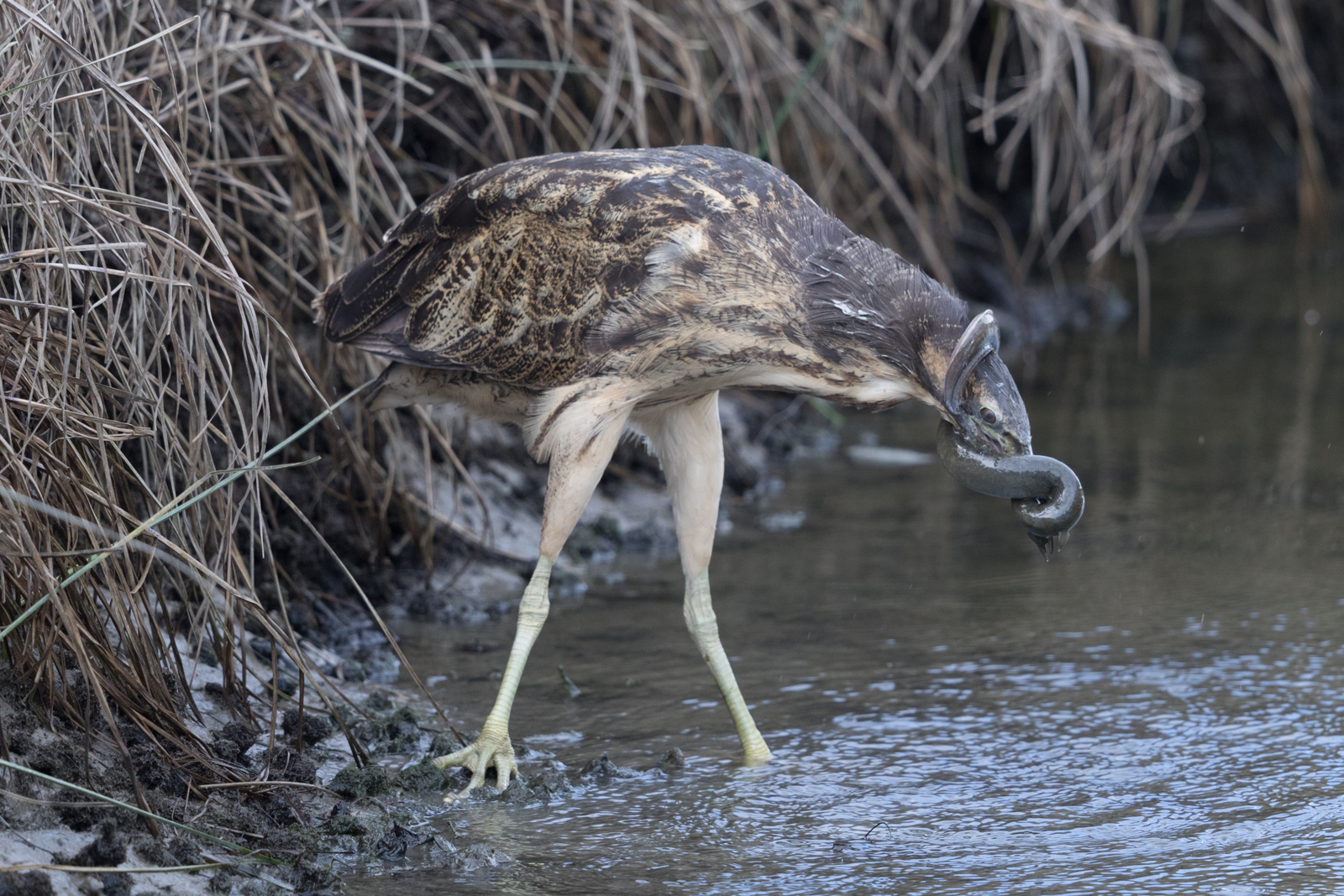
Australasian bittern, Botaurus poiciloptilus, wrestling with an eel. Photo: Imogen Warren
Community Ideas To Deliver The Murray-Darling Basin Plan
May 29, 2023
The Australian Government is inviting communities to share their views about how to best deliver the Murray-Darling Basin Plan.
The Government is committed to delivering the Plan in full, including 450 GL to enhance environmental outcomes. But we know communities and industry have previously felt left out of the conversation.
Delivering the plan includes achieving all water recovery targets. It means putting our rivers on a healthier and more sustainable path, while continuing to support Basin communities who help feed our nation.
The Government is working with Basin states and territories to do this.
Individuals and groups are welcome to make a submission that considers questions including:
- What ideas or concepts can help fully implement the Murray–Darling Basin Plan?
- Will these ideas recover water and deliver environmental outcomes?
- Are there ideas that will make a particular difference to your community?
- What are the challenges or risks to implementing these ideas?
To have your say, and find out more about the Plan, visit the consultation webpage: https://consult.dcceew.gov.au/ideas-to-deliver-the-basin-plan
The consultation closes July 3rd 2023
Minister for the Environment and Water Tanya Plibersek stated;
“We know that climate change has made the implementation of the Plan more important than ever.
“The Albanese Labor Government is committed to delivering the Murray–Darling Basin Plan in full. I’m pleased that all Basin states and territories are also committed to doing this.
“After years of delay and sabotage by the Liberals and Nationals, we want to get this right.
“I’ve said all options are on the table to deliver the Plan. I welcome innovative and practical ideas for how we can deliver a sustainable Basin for the communities, farmers, businesses and First Nations groups who rely on it.”
Many urban waterways were once waste dumps. Restoration efforts have made great strides – but there’s more to do to bring nature back
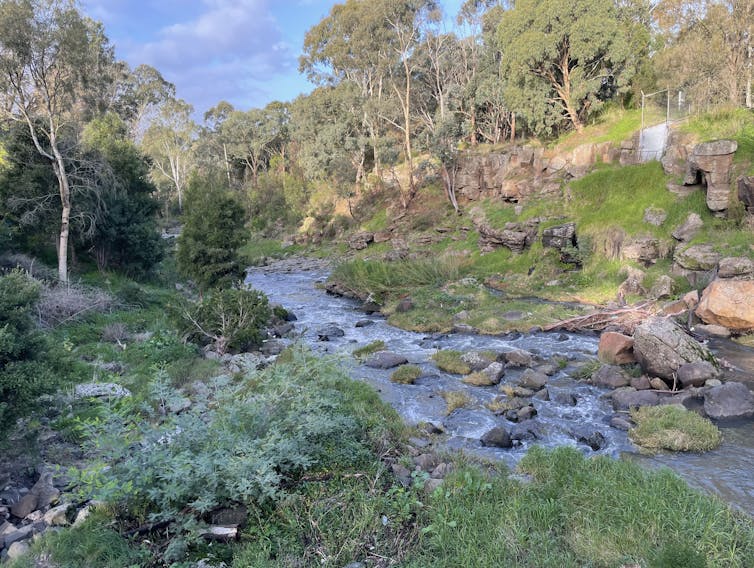
In the 19th century, many of Australia’s urban creeks and rivers were in poor shape. Melbourne’s major river, the Maribyrnong, was full of waste from abattoirs, tanneries and factories.
I live near Darebin Creek in Melbourne’s north, which was next to a tip and often polluted until cleanup efforts began in the 70s. Now many creatures have returned.
But while many waterways have been cleaned up, others have languished. As late as 2011, Sydney’s notoriously polluted Cooks River was so full of industrial waste and sewage it was dubbed an “open sewer”. Now, it’s starting to improve.
Here’s what the restoration of Darebin Creek shows us about the successes and challenges of bringing life back to our urban waterways.
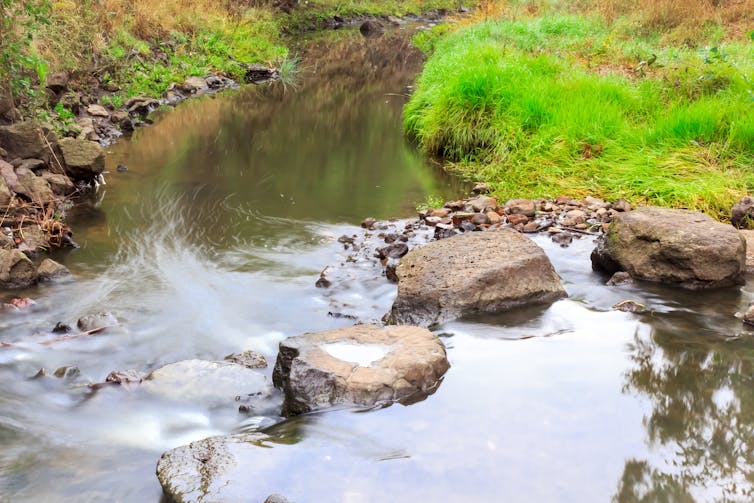
Rivers Or Rubbish Dumps?
Many of us, like Mole from Wind in the Willows, find ourselves “intoxicated with the sparkle, the ripple, the scents and the sounds…” of our waterways.
But we don’t always treat them very well. European settlement had a big effect on creeks and rivers, we’ve often used them as convenient waste dumps. Pump industrial waste, chemicals or sewage into them and watch it float away. Once we might have thought “problem solved”. Now we know differently. Treating rivers as dumps can (unsurprisingly) damage or even wipe out the life in it.
In Victoria, their fate started to improve when the state government passed the Environment Protection Act in 1970 (since superseded by the the Environment Protection Amendment Act 2018). Since then, community groups, government agencies, and Melbourne Water have started the repair job.
Now, we’re starting to see the benefits. My local waterway, Darebin Creek, is typical of many urban creeks and I love spending time here. Running in the morning, I pass ducks, swans, and moorhens. Kookaburras laugh in the trees, insects buzz in the morning light. It’s beautiful.
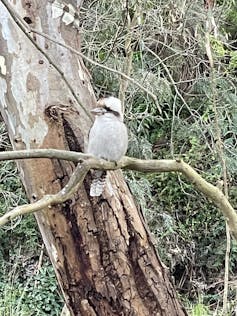
In the creek itself live frogs, invertebrates and fish. Endangered species like the growling grass frog and matted flax-lily can now be found.
There are even platypus sightings, which means there’s food there for them like insect larvae and yabbies.
What is now the expansive Darebin Parklands was once was used as a farm, then a quarry, then a tip earmarked for a freeway, and the creek was little more than a stormwater drain. Even today, leachate from the old tip seeps out.
The creek’s transformation – especially in its southern reaches – is due in large part to one determined woman, Sue Course, who was rightly recognised for her work in the 2021 Australia Day honours.
In the 1970s, Sue and her husband Laurie formed a residents’ group and lobbied successfully for the land to be given to the public. The group spent decades removing weeds and rubbish and planting trees.

Many urban waterways in Victoria are now in reasonable health, providing habitat for more than 1,800 species of native plants and 600 species of native animals. But not all. Rivers such as the Ovens and the Murray, and even the Yarra in places, are in poorer condition with low flows and high sediment and salt levels major issues.
Improvements are often connected to community efforts to revegetate, as well as watching for chemicals or other pollutants pumped into the stream. These efforts have to be ongoing. As recently as 2016, eels and other fish died in Darebin Creek due to insecticide being washed into the water.
And the wildlife of the creek has not fully recovered, as the local council points out. The remarkable plains-wanderer once roamed the creekline, but the last sighting was in 1972.
How Do We Fully Restore Our City Waterways?
Native species reliant on our city waterways still face threats. These include:
catchment pollution. A catchment is an area of land where water collects when it rains and then flows to a low point (such as a stream). Pollution in a creek or river’s catchment upstream can affect the whole waterway. A recent study on pesticides found the major source was residential use, meaning the chemicals were washed into the wetlands. A similar project used GPS to track plastic bottles down Melbourne’s creeks. They found bottles could travel many kilometres downstream, or get stuck and break down locally.
organic micropollutants. The way we live means we use a large range of chemicals, including cosmetics, pharmaceuticals, pesticides, fertilisers, and artificial sweeteners. A detailed study of the Yarra, Sydney and Brisbane River estuaries found traces of these chemicals in the water, including drugs, medication, personal care products, pesticides, and even food additives. Even though they are present in very low concentrations they can still be a worry. A recent study from Monash University showed that concentrations of pharmaceuticals in rivers, though far below the therapeutic dose can still affect fish behaviour.
stormwater. When rain runs off hard surfaces like roofs, driveways, and roads, it runs into storm drains and creeks, carrying debris, bacteria, soil, oil, grease, pesticides and other pollutants with it. In 2016 it was estimated that 95% of litter on Victorian beaches was transported there from suburban areas through stormwater drains.

nutrients. Fertiliser runoff from farms and wastewater spills in urban areas can bring too many nutrients like nitrogen and phosphorus into waterways. Overloads of nutrients can trigger sudden plant and algae growth. These block light and reduce oxygen levels, leading to the death of fish and other aquatic animals. Some algae and cyanoabacteria (that also grow in these conditions) produce toxins that can make us sick too.
invasive species. Many invasive species have been introduced into Australian waters including the infamous carp and mosquito fish. These prey on or outcompete native species, damage habitat, and carry diseases and parasites. Careful management to reduce their impact will likely be needed for some time.
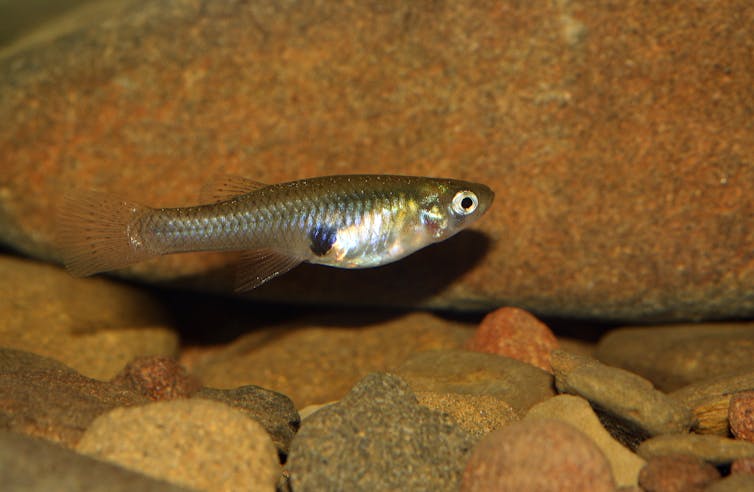
How Can We Help Bring Life Back?
If there’s a lesson in the restoration work done so far, it’s that we can’t expect life just to bounce back. Making our waterways healthy again takes effort, ranging from making sure rubbish doesn’t escape into them through to joining your local waterway organisation – or starting one.
Join a local Waterwatch program to monitor river health, or join the national waterbug blitz to learn more about invertebrate life. You can even get involved in efforts to restore riparian vegetation as natural flood dampening measures.
Above all, let’s appreciate our urban creeks and rivers for what they are – and for what they can become, so the next generation will have the same chance to enjoy them as we have.![]()
Oliver A.H. Jones, Professor, RMIT University
This article is republished from The Conversation under a Creative Commons license. Read the original article.
Can next week’s special meeting in Chile break the deadlock over East Antarctica’s marine park proposal?
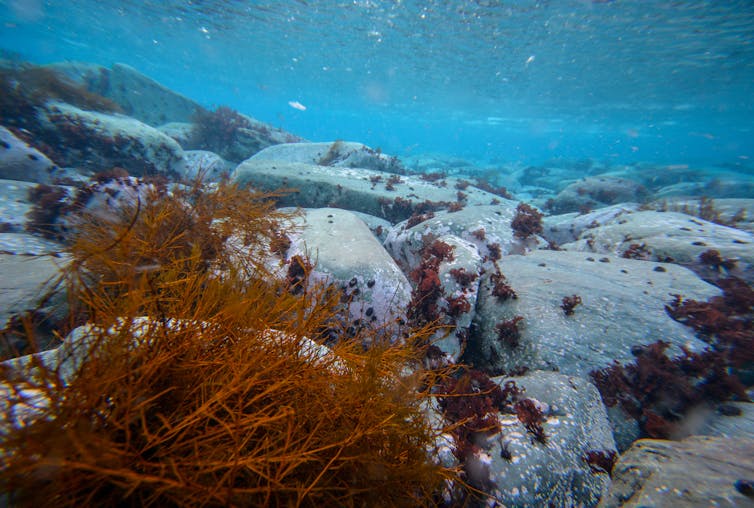
Amid the challenges of climate change, resource extraction and pollution, the survival of species and ecosystems depends on setting aside protected areas. But plans to establish marine protected areas in East Antarctica have stalled.
Next week, the 27-member Commission for the Conservation of Antarctic Marine Living Resources will gather at a special meeting in Santiago, Chile, to try to break the deadlock. There’s much at stake, given the seemingly implacable opposition from China and Russia. China appears more concerned about fishing for krill than conservation, while Russia’s objections are less clear.
The need for Antarctic marine protected areas was first discussed in response to the 2002 United Nations World Summit on Sustainable Development. The formal plan was adopted three years later, in 2005. While China had not yet joined the commission at that time, it was a member when the commission reaffirmed this commitment in 2011.
These areas were meant to protect a representative suite of Antarctic marine environments, such as unique seafloor communities, deepwater canyons, and highly productive coastal and oceanic food webs. They were to be developed, assessed and agreed on the basis of the best available science.
Slow Progress On Antarctica’s Marine Parks
So far, two marine protected areas have been agreed by the commission: South Orkney Islands Southern Shelf in 2009; and the Ross Sea Region in 2016. Since then, the commission has been unable to agree on any further proposals, including the East Antarctic Region marine protected area. This was first proposed by Australia in 2011. It’s the oldest of those proposed but not yet agreed. The commission has also been unable to adopt the research and monitoring plans or the reviews of the existing marine protected areas.
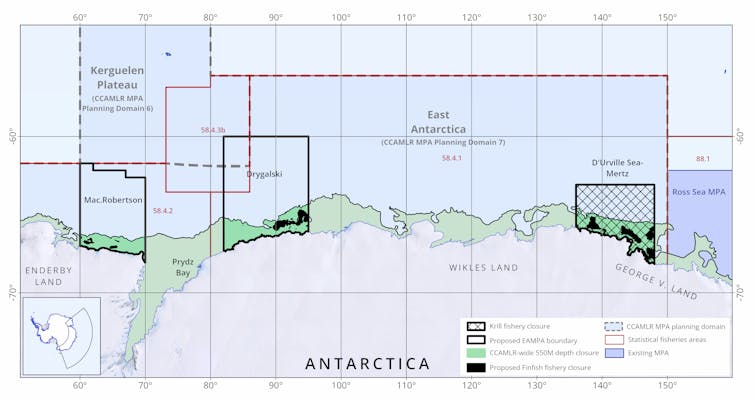
This year, the United Nations agreed to a treaty on the conservation and sustainable use of marine biological diversity in areas beyond national jurisdiction. This treaty will be up for adoption at a final conference session on June 19-20, 2023.
This treaty sets a global target of 30% of the global oceans to be in marine protected areas by 2030. This will be the likely yardstick against which the Commission’s future performance will be measured. So far, the commission’s marine protected area achievement is just 4.7% of the area of Southern Ocean that it is responsible for.
Of the 27 member countries of the commission, 21 have formally committed their support for the East Antarctic Region marine protected area. Only China and Russia have repeatedly opposed this and other proposals. They are now challenging the commission’s consensus agreement to establish the marine protected area network in Antarctica.
The Shrinking East Antarctic Region Marine Protected Area
The proposed East Antarctic Region marine protected area initially consisted of seven distinct areas designed to protect the diversity of environments in the region. Since then, Australia and its partners, now numbering 17, have granted many compromises in the quest for consensus. The number of distinct areas has been reduced to three and fishing is allowed unless explicitly excluded.
To specifically accommodate China’s concerns about future krill fishing, Australia sacrificed the unique and special Prydz Bay region. That’s despite the fact China’s krill fishing aspirations could be more than adequately met from the rest of the region. Nonetheless, Russia and China continue to withhold consensus on this proposal.
Increasingly, the rhetoric opposing marine protected areas is centred around an argument that invokes a “balance” between “conservation” (in this case, the establishment of marine protected areas), and “rational use” (in this case the right to fish). On both legal and practical grounds, the conservation versus rational use argument centres on the very core of the international agreement that covers the oceans of the region, the Convention on the Conservation of Antarctic Marine Living Resources.
The convention was agreed in 1980 to protect all Antarctic species from potential over exploitation. Its objective was – and remains – clearly centred on conservation in the region. Fishing is allowed, as long as the species and ecosystems of the region are conserved. The convention states that its objective “is the conservation of Antarctic marine living resources”. It identifies those resources as “populations of fin fish, molluscs, crustaceans and all other species of living organisms, including birds” and clarifies that “conservation” includes “rational use”, if such rational use can be conducted with minimal impact on the ecosystem.
In recent years, Russia and China have both argued that there is too much emphasis on conservation. They state that there needs to be a re-balancing between fishing and conservation. In constructing this argument, they are engaging in a wilful reinterpretation of the convention – and ignoring the significant time dedicated by the commission to fisheries management.
A Reliance On Consensus
The commission, like the rest of the Antarctic Treaty System, makes decisions on the basis of consensus. This means that some decisions may take quite some time to be agreed, but the strength of consensus is that all parties are then committed to the final result.
Consensus is built on trust and good faith. But consensus will be undermined when agreement is withheld in bad faith, or used as a means to achieve other objectives. The actions of one or a few that withhold consensus, or who negotiate in bad faith, could, if not confronted, undermine all decision-making in the commission, including decisions on sustainable fisheries.
Now Is Not The Time For Endless Compromise
We must not continue compromising for an apparent “quick win”. The East Antarctic Region marine protected area has been evaluated by the commission’s scientific committee, and the commission has repeatedly reached the point where only Russia and China withhold agreement. It is this behaviour that needs to be explicitly challenged, not the marine protected area proposal itself.
These nations need to explain their specific concerns, and in the spirit of consensus, provide workable alternatives that meet their obligations under the conventions and accommodate the aspirations of all members.
Australia has held many discussions with China and Russia over the years to help resolve their issues. With China, these discussions have been thorough and cordial, and it is clear this nation has a deep and comprehensive understanding of the marine protected area proposal. Several bilateral meetings have also been held with Russia; however, it remains unclear what their specific objections are, particularly as they are no longer fishing.
There are no obstacles to China agreeing to the East Antarctic Region marine protected area proposal now. They have agreed to two large Antarctic marine protected areas in the past. The East Antarctic marine protected area poses no substantive obstacle to China’s aspirations in the region, including their stated desire to harvest krill.
There is much at stake at this upcoming special meeting, including the reputation of the Commission for the Conservation of Antarctic Marine Living Resources. The protection of the Antarctic requires that a way forward on marine protected areas be found.![]()
Lynda Goldsworthy, Research Associate, University of Tasmania; Marcus Haward, Professor, and Tony Press, Adjunct Professor, Institute for Marine and Antarctic Studies, University of Tasmania
This article is republished from The Conversation under a Creative Commons license. Read the original article.
Antarctic tipping points: the irreversible changes to come if we fail to keep warming below 2℃
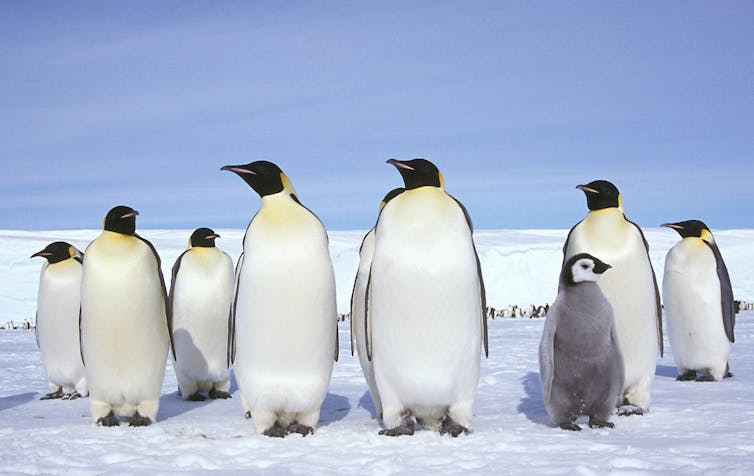
The slow-down of the Southern Ocean circulation, a dramatic drop in the extent of sea ice and unprecedented heatwaves are all raising concerns that Antarctica may be approaching tipping points.
The world has now warmed by 1.2℃ above pre-industrial levels (defined as the average temperature between 1805 and 1900) and has experienced 20cm of global sea-level rise.
Significantly higher sea-level rise and more frequent extreme climate events will happen if we overshoot the Paris Agreement target to keep warming well below 2℃. Currently, we are on track to average global warming of 3-4℃ by 2100.
While the recent Antarctic extremes are not necessarily tipping points, ongoing warming will accelerate ice loss and ocean warming, pushing Antarctica towards thresholds which, once crossed, would lead to irreversible changes – with global long-term, multi-generational repercussions and major consequences for people and the environment.
The Earth system is designed to reach equilibrium (come into balance) in response to climate heating, but the last time atmospheric levels of carbon dioxide (CO₂) were as high as they are today (423ppm) was three million years ago.
It took a millennium for the world’s climate to adjust to this. When it did, Earth’s surface was 2℃ warmer and global sea-levels were 20m higher due to Antarctic ice-sheet melting. Back then, even our earliest human ancestors were yet to evolve.
The evolution of humankind could only begin after CO₂ levels dropped below 300ppm, about 2.7 million years ago. Since then, Earth’s average temperature has fluctuated between 10℃ during ice ages and 14℃ during warmer inter-glacial periods.
During the past 10,000 years of our present inter-glacial period, Earth’s greenhouse gas thermostat has been set at 300ppm of CO₂, maintaining a pleasant average temperature of 14℃. A goldilocks climate – not too hot, not too cold – but just right for human civilisation to flourish.
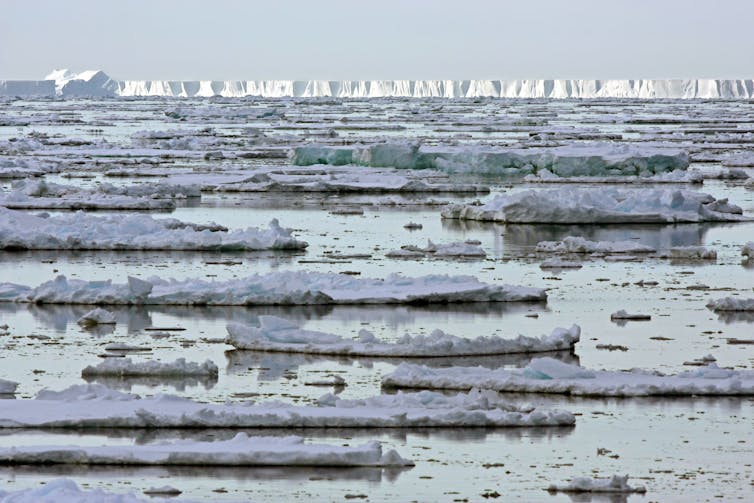
The Earth System Is Interconnected
Current global heating is taking the Earth system across a threshold humans have never experienced, into a climate where Antarctica’s ice shelves and marine ice sheets can no longer exist and one billion people, currently living near the coast, will be drowned by rising seas.
This will be a world where wildfires, heatwaves, atmospheric rivers, extreme rainfalls and droughts – such as those we have seen globally last summer – become commonplace.
The Earth system (oceans, atmosphere, cryosphere, ecosystems etc) is interconnected. This allows energy flow, enabling physical and ecological systems to remain in balance, or to regain balance. But connections can also mean dependencies, leading to reactions, amplifying feedbacks and consequences. Changes have roll-on effects, much like toppling dominoes.
Feedback loops – cyclical chain reactions that repeat again and again – can make the effects of climate change stronger or weaker, sometimes stabilising the system, but more often amplifying a response with adverse impacts.
Change is also not always linear. It can be abrupt and irreversible on human timescales if a threshold or tipping point is crossed.
Here, we outline one sequence of changes and consequences, including feedback loops and thresholds, using the example of global heating melting Antarctica’s ice sheets and the resulting sea-level rise.

We take a 50-year view into the future, as this is relevant for today’s policy makers but also sets in place much longer multi-generational consequences. While we focus on this example, there are many other Antarctic tipping points, including the effects of freshwater from ice-sheet melt on marine ecosystems and the effects of Antarctic change on Aotearoa’s temperature and rainfall patterns.
Antarctica In A Warming World
Unless we change our current emissions trajectory, this is what to expect.
By 2070, the climate over Antarctica (Te Tiri o te Moana) will warm by more than 3℃ above pre-industrial temperatures. The Southern Ocean (Te Moana-tāpokopoko-a-Tāwhaki) will be 2℃ warmer.
As a consequence, more than 45% of summer sea ice will be lost, causing the surface ocean and atmosphere over Antarctica to warm even faster as dark ocean replaces white sea ice, absorbing more solar radiation and re-emitting it as heat. This allows warm, moist air in atmospheric rivers from the tropics to penetrate further south.
This accelerated warming of the Antarctic climate is a phenomenon known as polar amplification. This is already happening in the Arctic, which is warming two to three times faster than the global average of 1.2℃, with dramatic consequences for the permanent loss of sea ice and melting of Greenland’s ice sheet.
Antarctic Tipping Points
The warmed waters melt the ice shelves, which are floating tongues of ice that stabilise the Antarctic ice sheet, slowing down the flow of ice into the ocean.
Ice shelves can pass a tipping point when local ocean temperature thresholds are crossed, causing them to thin and float in places where they were once held in place by contact with the seabed. Melting at the surface also weakens ice shelves. In some cases, water on the surface fills up cracks in the ice and can then cause large areas to disintegrate catastrophically.
By 2070, heat in the ocean and atmosphere will have caused many ice shelves to break up into icebergs that will melt and release a quarter of their volume into the ocean as freshwater. By 2100, 50% of ice shelves will be gone. By 2150, all will have melted.
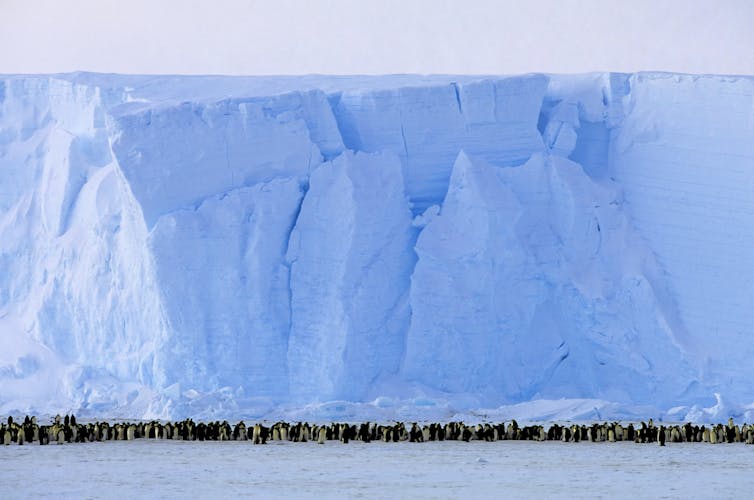
Without ice shelves holding back the ice sheet, glaciers will discharge at an even faster rate under gravity into the ocean. Large parts of the East Antarctic ice sheet and almost the entire West Antarctic ice sheet sit on rock in deep depressions below sea level.
They are vulnerable to an irreversible process called marine ice sheet instability (MISI). As the edges of the ice retreat into the deep basins, driven by the ongoing encroachment of warm ocean waters, the loss of ice becomes self-sustaining at an accelerating rate until it is all gone.
Another positive feedback, called marine ice cliff instability (MICI), means cliffs at the margins of the retreating ice sheet become unstable and topple over, exposing even taller cliffs that collapse under their own weight continuously like dominoes.
If global heating is not held below 2℃, ice-sheet models show global sea-levels will rise at at an accelerating rate up to 3m per century. Future generations will be committed to unstoppable retreat of the Greenland and marine sections of the Antarctic ice sheets, causing as much as 24m of global sea-level rise.
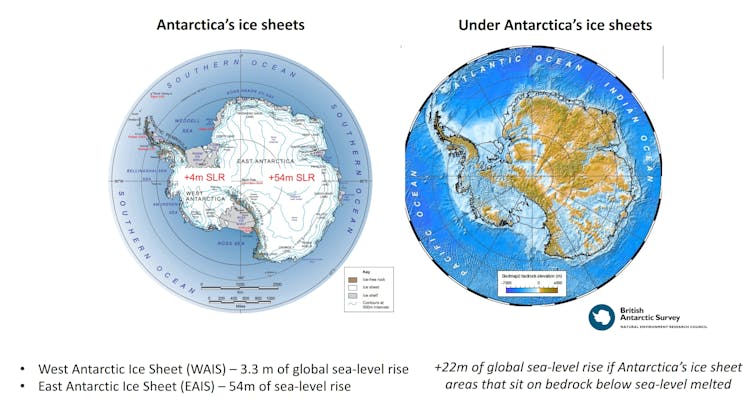
These changes highlight the urgency for immediate and deep cuts to emissions. Antarctica has to remain a stable ice-covered continent to avoid the worst impacts of rising seas.
Programmes around the world, including the Antarctic Science Platform, are prioritising research about future changes to the Antarctic ice sheet. Even if the news is not great, there is still time to act.
Mel Climo, Sandy Morrison and Nancy Bertler from the Antarctic Science Platform are acknowledged for their input and support.![]()
Timothy Naish, Professor in Earth Sciences, Te Herenga Waka — Victoria University of Wellington
This article is republished from The Conversation under a Creative Commons license. Read the original article.
The case for compost: why recycling food waste is so much better than sending it to landfill
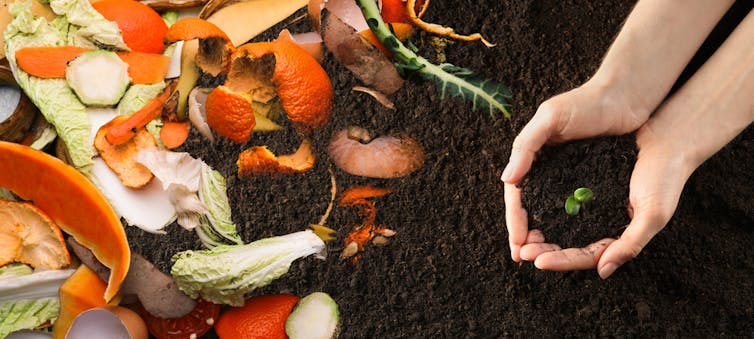
Most food and garden waste in Australia comes from homes. Australian households waste 3.1 million tonnes of food each year. That’s more than five kilograms each household per week.
Over half of all household waste is food organics and garden organics, also known as “FOGO”. These scraps and clippings take up space in landfill and, when they rot, emit dangerous greenhouse gases.
The federal government’s National Waste Policy Action Plan aims to increase the organic waste recycling rate from 47% to 80% by 2030 and halve the amount sent to landfill. This won’t happen on its own - we need investment and action.
Food and garden waste can be captured and turned into compost. Composting is no longer just the domain of the home gardener or eco-warrior. It’s happening at commercial scale, through services such as council collection from homes.
A federal government fund is building new composting facilities and supporting other food and garden organics recycling projects. The South Australian government has invested in council trials of weekly green bin collection and fortnightly rubbish collection.
But more must be done. Recycling food waste into high-quality compost is a win-win solution, for people and the planet. Here, we explain why.
Compost Is A Winner For The Climate
When food rots in landfill, in the absence of oxygen, the process releases a potent greenhouse gas called methane.
Composting is different because the microbes can breathe. In the presence of oxygen, they transform waste into valuable organic matter without producing methane. They recycle organic carbon and nutrients into compost, which can be used to improve soil health and productivity.
This process also captures and stores carbon in the soil, rather than releasing it as carbon dioxide (CO₂) to the atmosphere.
In Australia, organics recycling (including food and garden organics, biosolids and tree wastes) saves an estimated 3.8 million tonnes of CO₂ from entering the atmosphere each year. That’s equivalent to planting 5.7 million trees or taking 877,000 cars off the road.
Soils can profit from compost because globally an estimated 116 billion tonnes of organic carbon has been lost from agricultural soils. This has contributed to rising CO₂ levels in the atmosphere.
Promisingly, compost can restore soil organic carbon while also boosting health and fertility. Compost improves soil structure and water retention. It’s also a source of essential nutrients that reduces the demand for costly fertilisers.
The opportunity presented by soils to draw down atmospheric CO₂ levels was brought to global awareness in the 2015 global Paris Agreement, via the “4-per-mille” initiative.
Translated from French, it means increasing the organic carbon stored in global soils by 0.04% each year (4 per 1000) would neutralise increases in atmospheric CO₂. In other words, CO₂ would remain constant rather than continue to increase. That would make a substantial contribution to mitigating climate change.
Farming With Precision
Our research has investigated how compost can benefit global agriculture.
We found that in most cases where compost is applied as a generic product to agricultural land, the benefits are not fully realised. But if suitable composts and application methods were aligned with target crops and growth environments, crop yields can be increased and organic carbon in soils replenished.
We call this a “precision compost strategy”. Using a data-driven approach, we estimate global application of this strategy has potential to increase the production of major cereal crops by 96.3 million tonnes annually. This is 4% of current global production and twice Australia’s annual cereal harvest.
Of great relevance for Australia’s farms, precision compost has the strongest effects in dry and warm climates, boosting yield by up to 40%. We now need to develop this strategy for the specific needs of farms.
Compost has the potential to restore 19.5 billion tonnes carbon in cropland topsoil, equivalent to 26.5% of current topsoil soil organic carbon stocks in the top 20 cm.
Give FOGO A Go-Go
The amount of food and garden waste in Australia is growing at a rate six times faster than Australia’s population and 2.5 times faster than GDP.
But less than a third of Australian households have access to food waste collection services. A national rollout has been pushed back from 2023 to the end of this decade so there is time to overcome some roadblocks. This includes uptake by community and high quality composting.
This waste stream offers a huge opportunity for landfill diversion and compost production. The cost benefit alone is compelling: councils can save up to A$4.2 million a year on landfill levies by diverting 30,000 tonnes of waste (based on A$74 to 140 per tonne of waste, with levies increasing).
Preventing food in the home from being wasted should be top priority. But for unavoidable food waste, turning it into high-quality compost makes perfect sense.
us![]()
Susanne Schmidt, Professor - School of Agriculture and Food Science, The University of Queensland and Nicole Robinson, Research Fellow, School of Agriculture and Food Sciences, The University of Queensland
This article is republished from The Conversation under a Creative Commons license. Read the original article.
Imagine the outcry if factories killed as many people as wood heaters

Imagine a fleet of ageing factories operating in neighbourhoods across Australia.
On most days the smoke from their stacks is hardly noticed. But on cold days when the smog settles in the densely populated valleys and towns, doctors notice unusually high numbers of people suffering from a range of problems, especially asthma.
Air-quality researchers are called in to study the problem in more detail. They confirm that neighbourhoods with these old factories have higher concentrations of fine particles, which are toxic air pollutants.
Invisible to the naked eye, particles are inhaled deep into the lungs, enter the bloodstream and cause a range of harms throughout the body. This air pollution is linked to higher rates of heart and lung diseases, strokes, dementia and some cancers. It also increases the risk of adverse pregnancy outcomes and poorer learning outcomes in children.
The researchers calculate that each year pollution from the factories causes 269 premature deaths in Sydney, 69 in Tasmania and 14 in Armidale, New South Wales.
While the factories are supposed to be built, maintained and operated to certain standards, the regulations are rarely if ever enforced. There isn’t even a central register to tell authorities how many of these factories exist, how old they are, and where they are located.
As news of this research is made public, how would the affected communities react? What might they demand of government?
Would it matter if they knew we were not talking about factories, but wood heaters?

Heaters Produce Much Of Our Air Pollution
Every sentence of this story is true if you replace the word “factory” with “wood heater”.
Less than 10% of households own a wood heater, but burning wood for heating is the largest source of air pollution in many Australian cities and towns. While vehicle manufacturers and industry have greatly reduced emissions following tightened government regulations, domestic heating technology has not kept pace.
Today you would have to drive a diesel truck 500 kilometres to emit as much air pollution as a wood heater does in a single day. And that figure is for a wood heater that meets the current regulatory standards in Australia. Most do not.
Furthermore, wood heater pollution can be many times more severe when owners leave logs to smoulder overnight, burn poorly seasoned wood, or close down the air intake immediately after loading more wood.
Of course, particulate pollution is not all that wood heaters emit. When firewood is sourced from land clearing and illegal wood hooking, wood heaters add to net carbon dioxide and methane emissions in much the same as burning coal does because the carbon is no longer locked away in forests.
The best estimates are that less than a quarter of firewood is sourced from sustainable plantation suppliers. Even from those sources, the carbon emissions take many years to be sequestered into growing trees.
One study estimated that, if we stopped burning wood and clearing forest for heating, Australia would reduce its annual greenhouse gas emissions by 8.7 million tonnes. That’s about one-fifth of Australia’s car emissions.
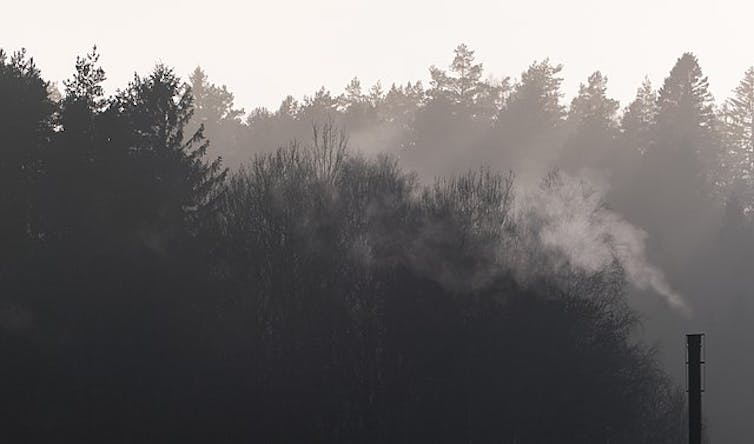
The Benefits Of Electrification
Inevitably, as Australia moves towards a zero-carbon future, the electrification of domestic heating will bring widespread health and economic benefits. It will prevent hundreds of premature deaths each year.
Hospitals will benefit from a reprieve in the cooler months, enabling doctors and nurses to better cope with seasonal pneumonia and COVID-19 outbreaks. And even those outbreaks will be less severe with reduced air pollution.
Besides being healthier, Australians will enjoy much lower heating costs as a result of using technologies such as reverse-cycle air conditioners (heat pumps). Remarkably, heat pumps are up to 600% efficient. That means, for every unit of energy they consume, they generate up to six units of heating energy.
Making The Switch
As people learn about the impacts of wood heaters on their neighbours, friends and relatives — on pregnant women, young children and the elderly — many will make the switch.
Governments need to ensure safe and affordable heating technology is available to everyone regardless of their income.
Already, governments in the Australian Capital Territory, Tasmania and New Zealand have programs that reimburse households for the cost of replacing their wood heaters.
Buy-back schemes, home efficiency subsidies, regulation and enforcement, including property market regulation (ensuring wood heaters are removed prior to sale), and restrictions on new installations all have a role to play.
We are conducting economic modelling to determine the most cost-effective policy settings for maximising the benefits of policies to manage the problem of wood heaters.
Fire and smoke will remain important experiences for Australians. They can be savoured primarily outside the city, under bright stars, in open deserts and rugged coastlines, in beach shacks and farm cottages, and as part of Indigenous cultural practices.
One day we will look back in amazement that we once tolerated wood heaters in our cities, right next to schools, homes and hospitals. We’ll regard them in much the same way that we think of polluting factories today.![]()
Bill Dodd, Knowledge Broker, Centre for Safe Air (NHMRC CRE), University of Tasmania; Bin Jalaludin, Conjoint Professor, School of Population Health, UNSW Sydney, and Fay Johnston, Professor, Menzies Institute for Medical Research, University of Tasmania
This article is republished from The Conversation under a Creative Commons license. Read the original article.
Help, bees have colonised the walls of my house! Why are they there and what should I do?
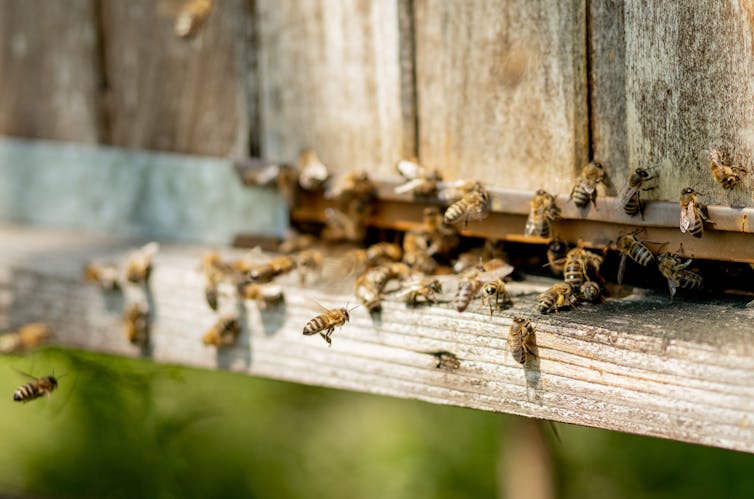
Have you spotted a swarm of flying insects emerging from a wall? Or noticed a buzzing noise coming from inside the house?
If this sounds familiar, a colony of European honeybees (Apis mellifera) may be making their home in your walls.
Why does this happen, and what should you do?
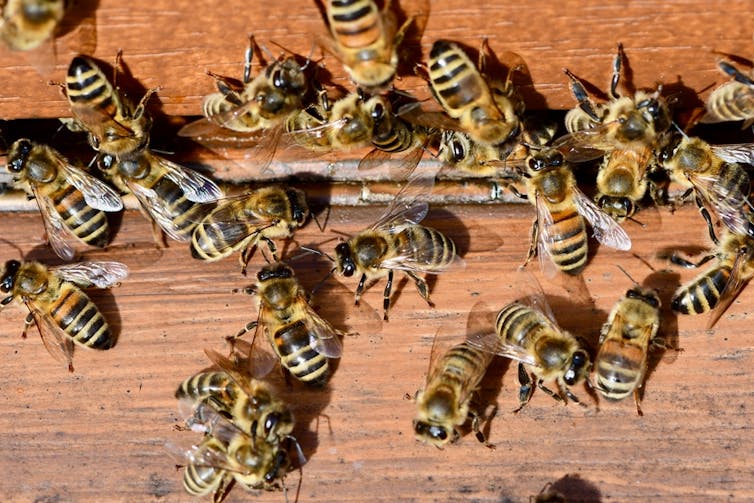
Are They Honeybees?
First, work out who these house guests really are. Honeybees are often the culprits, but European wasps (Vespula germanica) also occasionally build their nests inside human-made structures. Their nests have a papery appearance and are made from chewed-up plant fibres.
European wasps are a more dramatic yellow and black, and have narrower waists. Honeybees have less slender waists, appear furrier, and are a duller orange-brown colour.
If they are inside homes or high-traffic areas, both honeybees and European wasps will usually need to be removed by a professional.
Depending on where you live, other social bees such as stingless bees and bumblebees may occasionally build colonies in human-built structures, but they rarely cause any serious problems.
Solitary native bees such as carpenter bees, blue banded bees and teddy bear bees do not live in colonies. However, they sometimes build their individual nests close to one another. These insects are rarely aggressive and can often be left alone.
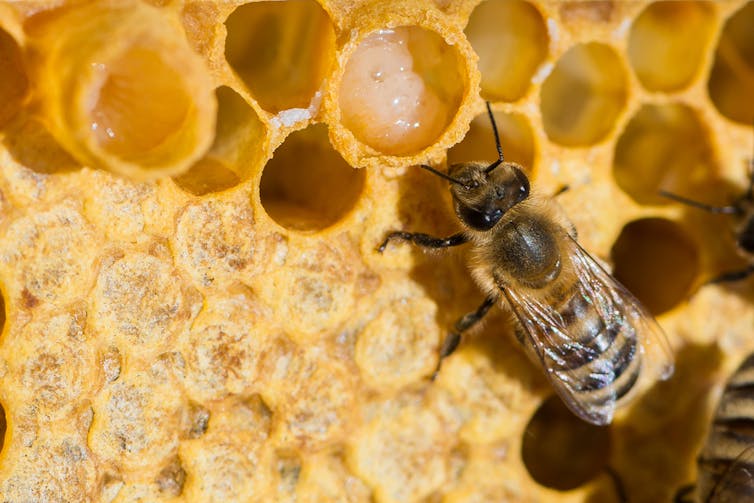
How Did They Get There?
When a honeybee colony outgrows its current dwelling, the bees embark on a quest to find a new home.
In preparation, the queen bee lays eggs in special cells known as “queen cells”. The larvae in these cells are fed with royal jelly, which helps them develop into new queens.
Once the new queens emerge, the old queen leaves the hive accompanied by a substantial number of worker bees.
Now homeless, the house-hunting bees gather together in a tight cluster called a “swarm ball” on a nearby object. From this temporary base of operations, the bees send out scouts to find potential nesting sites.
When a scout discovers a suitable location, she returns to the swarm ball and performs an extraordinary routine known as a “waggle dance”.
Astonishingly, this dance communicates the location of the potential new home to other scouts, who then venture out to inspect the advertised site. If they agree with its suitability, they return to the hive and do their own waggle dance.
Once enough scouts agree on the suitability of the new home, the entire swarm soars through the air to their new home.
Unfortunately, the bees occasionally choose to settle in human-made structures. Once inside, they produce wax to build the hexagonal cells that make up the nest. Some cells are used as nurseries for larvae, while others are used to store pollen and honey.
The most obvious sign is usually a steady stream of bees flying in and out of the hive, usually from a small hole or gap in the wall.
You might also hear a buzzing sound.
What Will The Honeybees Do To My House?
The honey and wax produced by bees can melt when the colony dies or during hot weather. This leads to stains and damage to walls, while the lingering honey may draw in rodents. The growing weight of a colony can also cause structural damage over time.
While honeybees are generally not aggressive, they will sting in self-defence, particularly near their colony.
Moving slowly and avoiding swatting can lower the chance of getting stung.
Dealing With Honeybees In The Home
If honeybees have taken up residence in your home, ask a professional, such as a beekeeper, to remove them.
Do not attempt to remove the bees yourself; this could be dangerous. Spraying insecticides or repellents into your walls may not kill all the bees and could trigger aggression.
Even if the insecticide does kill the colony, the dead bees, wax and honey will decay and melt, creating a bigger mess and attracting pests.
Not all beekeepers are equipped to remove bees from homes. Look for beekeepers who advertise “bee removal” or “bee rescue” services.
You can also try contacting amateur beekeeping associations, which may maintain a list of experienced bee removers. If there are no appropriate beekeepers in your area, or the colony is not easy to access, you may need to contact a pest controller.
Sometimes, colonies can be removed alive and relocated but this is not always possible. Your options will depend on the size of the colony, whether or not the beekeeper can access the colony, their level of experience and how long the colony has been there.
If you live in certain regions of New South Wales, it’s very important you report honeybee swarms or wild colonies to the Department of Primary Industries.
Wild colonies may harbour invasive Varroa mites, which are a deadly honeybee parasite. Varroa mites are currently subject to an eradication program. Varroa mite is only in NSW at the moment.
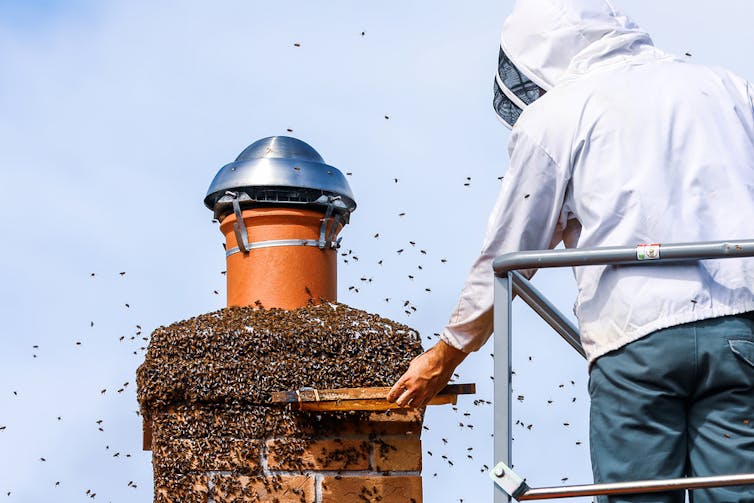
Prevention Is Key
Try to prevent bees getting in your house in the first place. Seal cracks or holes in exterior walls and put fly screen mesh over outdoor vents.
Beekeepers can prevent swarms happening in the first place by making sure they manage their hives appropriately. Joining a local beekeeping club is an excellent way to learn about bee care.
While honeybees are important pollinators and honey producers, they can also be a nuisance in your home.![]()
Tanya Latty, Associate professor, University of Sydney and Nadine Chapman, Postdoctoral Research Associate, University of Sydney
This article is republished from The Conversation under a Creative Commons license. Read the original article.
Bad break-up in warm waters: why marine sponges suffer with rising temperatures
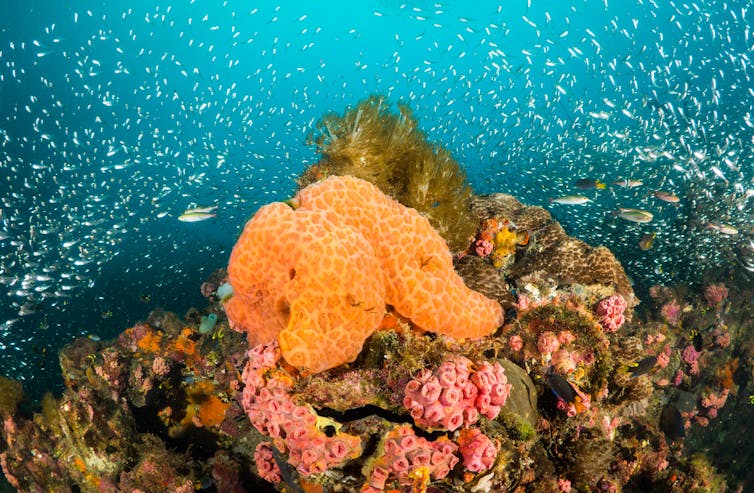
Marine sponges have started dying in vast numbers in coastal areas around the globe. Just this year, thousands of sponges turned white and died in New Zealand and in the Mediterranean Sea. This has been happening when the water gets too warm, but the underlying cause has remained a mystery. Until now.
We know these sponges play a crucial role in recycling key elements such as carbon, nitrogen, sulphur and phosphorus. In doing so, they keep nutrient cycles ticking over, to the benefit of all life on Earth.
This happens mainly through their very close association, or “symbiosis”, with diverse and abundant microbes. These microbes live in the sponge tissue as “life partners”. Sponges benefit from these tight relationships, as the microbes produce energy, recycle nutrients and provide beneficial molecules for the host.
In our new research, we found the cause of death is likely to be the sudden loss of a key microbe at high temperatures. This might rapidly poison the sponge, because this specific microbe is usually required to remove ammonia, a toxic metabolic waste product, from the sponge’s tissues. Without this crucial process, the sponge dies.
Experimenting With Temperature
Marine sponges are animals of many shapes, colours and sizes found in every ocean, where they serve as food and provide shelter to many other organisms.
They spend their lives attached to the seafloor, where they feed by filtering thousands of litres of seawater every day, capturing, and later digesting, microscopic food.
Our study examined the tropical sponge Stylissa flabelliformis, exposed to either today’s average summer temperature (28.5℃) or the average temperature predicted for 2100 (31.5℃).
After eight weeks in the warmer water, the sponges were dying. There was no trace of the microbe that usually removes toxic ammonia in the sponge tissue. The microbial gene carrying the detoxifying function was completely absent from the sponge tissue, too. This confirmed no other microbe was fulfilling this role, and the detoxification of the tissue was simply not possible.
In contrast, the sponges kept at 28.5℃ were healthy. And the microbes in the sponge tissue were the ones we usually find when all is well.
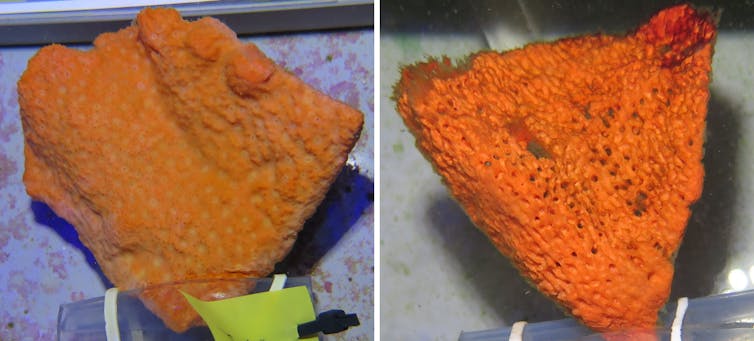
Are We Spoiling An Evolutionary Success Story?
Sponges are some of the most ancient animals on the planet. They are found from the tropics to the poles in shallow and deep waters.
The sponge-microbe symbiosis has long been credited for this ecological success story. Depending on the sponge species, thousands of different microbial species reside in the sponge tissue.
In addition to supplying energy to the host, these microbes provide the sponge host with vital molecules the sponge itself cannot produce, such as essential vitamins, or compounds that deter predators. They also act as recyclers, transforming certain chemicals to reduce their toxicity or to make them digestible by the sponge. And they even produce molecules that can potentially benefit humans, such as anti-cancer drugs and antimicrobial agents.
The symbiosis between sponges and their microbial partners has allowed sponges to conquer large portions of the oceans’ seafloor. But human activities might put a serious dent in this epic success story. Last year, a marine heatwave induced tissue damage and bleaching in several sponge species in New Zealand. In the Mediterranean, all the sponges off the coast of Marseille died as a result of temperature extremes during Europe’s last summer.
While the underlying cause of these mass die-offs in warmer waters is not yet known, researchers have suggested the answer might lie in the breakdown of the symbiosis between the host and its microbes. Our research supports this hypothesis. These sponges may actually face a problem similar to bleached corals: increased temperature destroys the symbiosis, potentially causing a chemical imbalance within the sponge, with deadly consequences.
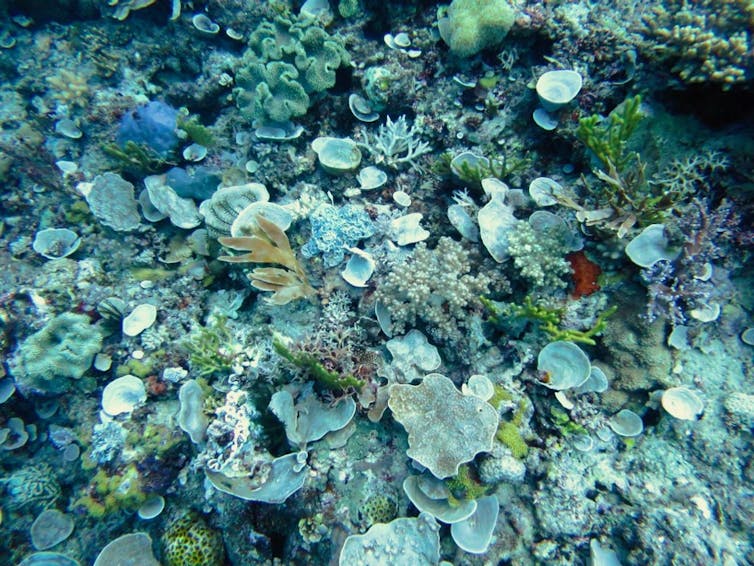
No Strings Attached? No Way!
Most of the time, a strong symbiosis has an overwhelmingly positive effect on the host, but the risk of having such deep ties is dependency. With S. flabelliformis, it seems the sponge could not survive the loss of the only microbe that detoxifies ammonia and the “breakup” caused by increased temperatures.
Notably, this abundant species on the Great Barrier Reef and the West Indo-Pacific is not the only tropical sponge to experience changes in its microbes when it is unhealthy. This also happens in sponges living in temperate waters.
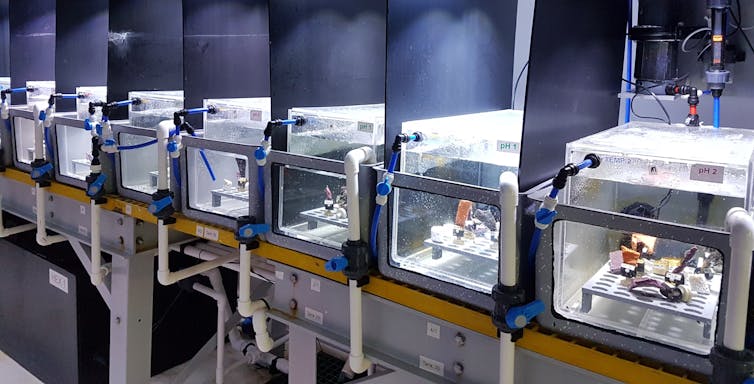
Sponges And Their Microbial Partners Are In Trouble
Importantly, the 3℃ temperature rise to which we subjected our sponges does not represent a science-fiction scenario, but today’s extremes, already seen in nature. It is consistent with the marine heatwave that hit the Australian East coast between November 2015 and February 2016.
These extreme events are predicted to become more frequent and more severe as our climate continues to change. And such high temperatures could become averages by 2100 if we do not become carbon neutral globally as soon as possible.
This is worrying news for sponges, for the ecosystems they support and, by extension, for us. Sponges are extremely diverse with about 8,500 species currently described around the globe, host to microbes that could help humanity fight diseases and antibiotic resistance.
It is not intuitive to think highly of unassuming animals and their microbial partners when contemplating big issues such as climate change and the collapse of Earth’s biodiversity. But for the sake of our oceans, and ultimately, ourselves, we need to quickly make this collective effort and protect them accordingly.![]()
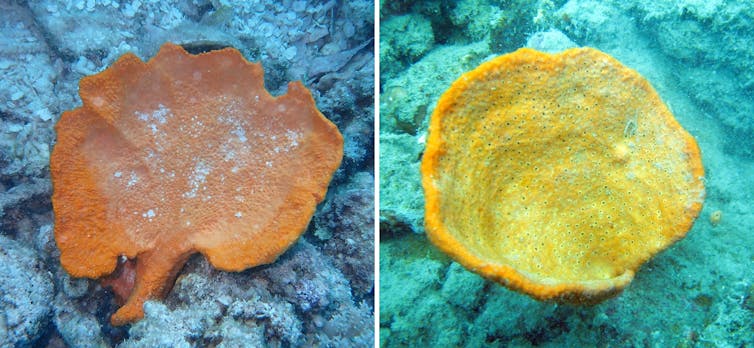
Emmanuelle Botté, Research Officer, UNSW Sydney; Heidi M. Luter, Research Scientist, Australian Institute of Marine Science, and James Bell, Professor of Marine Biology, Te Herenga Waka — Victoria University of Wellington
This article is republished from The Conversation under a Creative Commons license. Read the original article.
Many First Nations communities swelter without power. Why isn’t there solar on every rooftop?
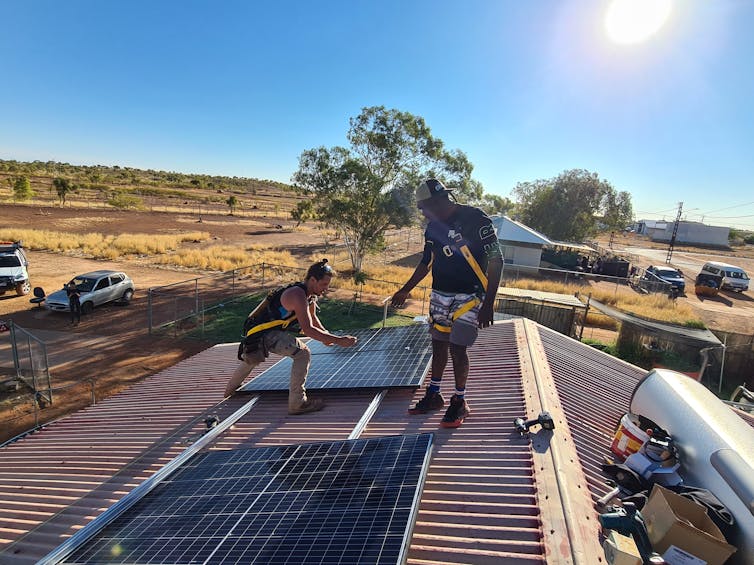
Over 3.4 million Australian houses now have rooftop solar, often subsidised by government incentives.
But in remote First Nations communities in the Northern Territory, you don’t see solar on any rooftops. That’s a real problem. This part of Australia is dangerously hot in summer. And many people don’t have enough power to run vital appliances like the fridge and air conditioner.
Solar would be an ideal solution. Tennant Creek has over 300 days per year of sunshine with some of the clearest skies in the world, for instance.
Only recently, co-author and Warumungu elder Frank Jupurrurla took part in the first NT rooftop solar trial, supported by Original Power and installed rooftop solar on his house.
As our new research found, this pilot worked well, supplying a third of the house’s power and ending the problem of power disconnecting. Previously, the power would go out once a month on average. After solar, it never went off.
So why isn’t this widely available? The main problems are red tape, such as getting approval for work on public housing, securing feed in tariffs and metering requirements. As Mr Jupurrurla’s experience demonstrates, they can all be overcome – but not easily.
As Frank Jupurrurla says:
We call the sun Kilyirr […] Right now he’s shining on my panels, he’s giving me power, and he looks after us. So that Kilyirr, he gonna be there forever.
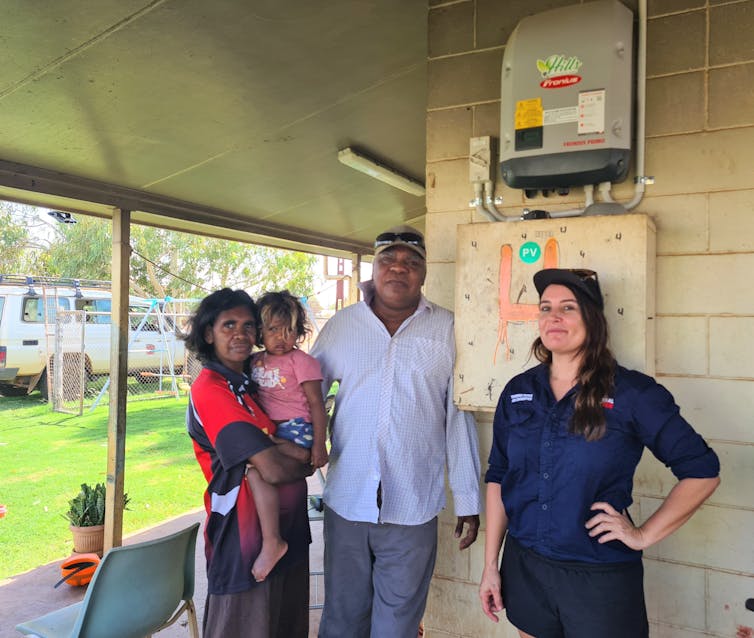
How Do Remote Communities Get Power At Present?
Prepaid electricity is used in many remote First Nations households across Australia, and in almost all town camps. In this model, people “top up” the meter with credit. When credit runs out, the electricity disconnects until more credit is purchased. The electricity here is often produced by diesel generators.
Despite the risk of sudden disconnection, this model is often preferred by many communities as it gives residents fewer surprise bills. The downside is it often leads to an unenviable choice – power or food.
For residents of Tennant Creek’s town camps, it is not uncommon to run out of credit on a hot day. The hotter the day, the higher the chance people will lose power. That’s because hotter weather forces air conditioners and fridges to work harder.
When the power goes off, food inside fridges starts to spoil. Essential medical devices such as oxygen concentrators stop operating. Medications can become inactive or even toxic.
Air conditioners stop working and temperatures rise. On very hot days, the inside of a house gets well over 40℃. Children and adults can’t sleep. Going to school gets harder. Not only are these conditions unsafe, they can drive social disharmony.
As Frank Jupurrurla says:
We struggle every day. Our people, they’re not healthy. Lots of people in this town are on renal [dialysis]. Solar should be talked about in parliament and put on the table.
Did The Trial Help?
A 6.6 kilowatt solar array was installed on Mr Jupurrurla’s house and switched on in November 2021. The house kept its grid connection and no battery was installed. Household residents received a crash course from the installers, First Nations organisation Original Power, on making the most of the solar for example by running the washing machine during daylight hours.
The result? Solar generates a third of the total power use in any given month. But more importantly, through reducing energy costs, disconnections stopped entirely. This removed a huge source of stress and made the home safer and more enjoyable, according to the family.
As Mr Jupurrurla says: “We used to put a lot of power cards in nearly every day, second day. Now we got money all the time since we’ve got solar.”
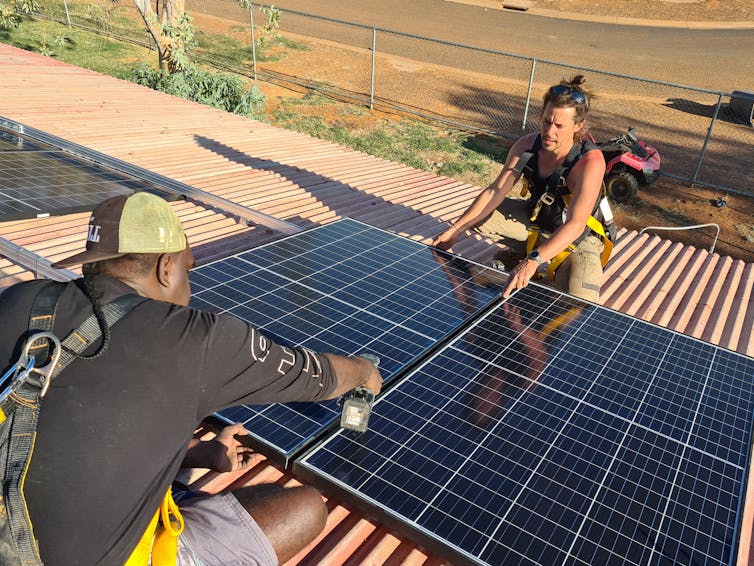
Solar Is A Great Solution – But Only If It’s Made Easy
It sounds simple: install a 6.6kW array and see what difference it made. After all, people in the cities can do this routinely.
But it’s harder far from the cities, and harder still when different government departments have to sign off. As Mr Jupurrurla describes:
The barriers was from the day we started. Before that, we’d argue with [Department of] Housing, and they said we have to check inside and check if the house is strong enough. Once we had the panels on, then it took us a while to [turn] it on. It was pretty frustrating. It took Power and Water more than three months just to switch the switch on. It was so hard. I rang the housing minister but nothing happened. So one day I just went out there to the box and switched it on myself
Installing solar here meant overcoming regulatory barriers such as securing feed-in tariffs for excess power produced, ensuring the public housing is high-quality enough to host solar, and the question of ownership of the panels.
The NT housing department required an engineer’s sign off on the roof’s structural integrity, as this can’t be assumed for remote public housing.
As Mr Jupurrurla’s experience demonstrates, these barriers can be overcome – but not easily.
What’s Stopping A Wider Rollout?
Our trial shows solar can work well for remote communities. The timing is good, as the ongoing roll-out of smart prepay meters means most remote First Nations houses in the NT are able to handle solar.
For this to gain momentum, the NT government must find ways to overcome these barriers. The Territory government has responsibilities as both the landlord for housing and as the monopoly energy provider.
A key first step would be to smooth the path with clear paperwork and incentives for prepay households to install solar.
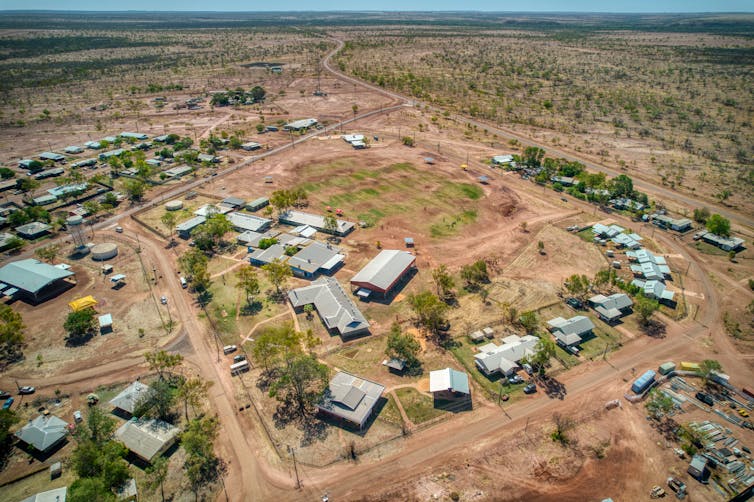
Just as in the cities, encouraging solar will require financial incentives to offset the upfront cost, with culturally appropriate resources available in First Nations languages to explain the process.
Feed-in tariffs have long driven demand for solar for many homeowners. Ensuring remote communities are eligible will be vital.
Australian households are world leaders in taking up solar. But for too long, the ability to generate your own power from the sun has been off limits to many of the people who would benefit the most.
This year is an excellent time to correct this, as the federal government works towards a co-designed First Nations Clean Energy Strategy and the NT government’s plans for better power solutions in remote communities.
As Frank Jupurrurla says:
I’d like to see government fund […] panels on homes. Especially in the Community Living Areas [Town Camps] in places like Alice Springs, Tenant Creek, and Katherine.
Simon Quilty, Senior Staff Specialist, Alice Springs Hospital. Purple House Medical Advisor. Honorary ANU., Australian National University; Brad Riley, Research Fellow, Australian National University; Lee White, Fellow, Australian National University, and Norman Frank Jupurrurla, Warumungu Elder and Director of the Julalikari Council Aboriginal Corporation, Tennant Creek, Indigenous Knowledge
This article is republished from The Conversation under a Creative Commons license. Read the original article.
Regional Australian Cities: Not A Simple Housing Solution For Metropolitan Growth Pressures
June 13, 2023
By Ben Knight UNSW
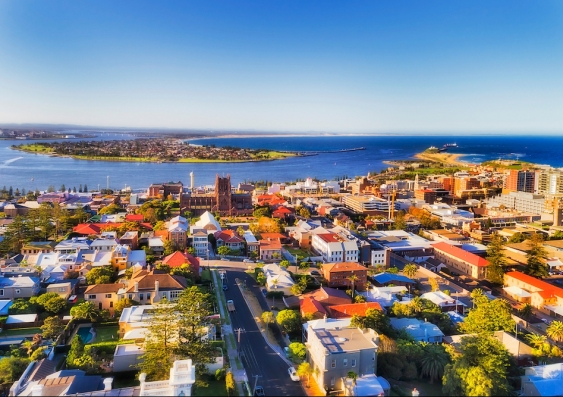 As the cost of living continues to soar, some metropolitan dwellers are considering leaving the city in search of a more affordable and comfortable regional lifestyle. But while many regional areas have the potential to accommodate more people, we shouldn’t expect a change of scenery to be the right move for everyone.
As the cost of living continues to soar, some metropolitan dwellers are considering leaving the city in search of a more affordable and comfortable regional lifestyle. But while many regional areas have the potential to accommodate more people, we shouldn’t expect a change of scenery to be the right move for everyone.
Dr Laura Crommelin, Senior Lecturer in City Planning at the School of Built Environment, UNSW Arts, Design & Architecture, says it would be unrealistic to rely on smaller regional cities to solve the housing problems of major metropolitan areas.
“Our major cities continue to offer a broader range of employment opportunities, which means they will continue to attract new residents. So, it’s unlikely smaller regional areas can substantially ease pressures for major cities, at least in the short-term,” Dr Crommelin says.
“And in any case, we’re seeing that rapid growth without proper planning can replicate some of the problems we face in urban areas in regional areas, such as housing affordability.
“So we risk losing features of regional life that are often what attract people to move in the first place.”
Housing demand in the regions
While some remote areas of inland Australia have stagnated or even experienced population decline, others are already struggling to deal with increased migration from the pandemic and the rise of remote work. Some coastal regions, in particular, have experienced a significant influx of sea-changers in recent years motivated by cheaper, more spacious housing on offer by the beach.
“Some who are priced out of the city housing markets may be able to afford a more spacious, standalone dwelling in a regional area,” Dr Crommelin says. “Those regional areas within striking distance of the city are increasingly popular with those who still might commute once or twice a week to the city for work, but spend most of their time living by the coast.”
Rapid growth can also have similar effects on regional rental markets. Demand for affordable rental properties is already exceptionally high in some regions. Shortages can drive up asking prices and threaten to push residents into rental stress or out of their towns entirely. Similarly, the rise of short-term letting platforms like Airbnb may also take potential housing supply out of the market, particularly at peak times of year.
“Housing affordability is a significant issue now in regional areas that are growing quickly,” Dr Crommelin says. “If people moving out from the big cities can come in with higher paying salaries and push prices up, it can create resentment.”
An Australian Housing and Urban Research Institute (AHURI) study led by Dr Crommelin published last year found regional residents are also concerned about growth diminishing the lifestyle appeal of their cities while stretching essential services further.
“There is a concern that rapid growth outpaces investment and places more pressure on existing services – particularly health and education,” Dr Crommelin says. “It’s something policymakers need to anticipate and get ahead of so that infrastructure development can support growth, not just follow it.”
Managing growth in regional Australia
Rather than perceiving the regions as a solution to metropolitan population pressures, Dr Crommelin says policymakers should instead consider how population growth can help regional Australia.
“Proactive, strategic planning informed by local knowledge can ensure population growth benefits regional cities and their residents first through improved local services, infrastructure and amenity.”
A primary focus should be improving regional labour markets to attract and retain more population, particularly in fields where worker shortages exist. This would not only include creating more high-quality employment opportunities, but better supporting long-term career paths in non-metropolitan areas.
“Reduced employment and career development options are considered a downside of relocating. There’s certainly a role for regional universities and campuses to help create local graduates, but how best to help them build a fulfilling career in non-metropolitan Australia is something we’re interested in looking into further,“ Dr Crommelin says.
Long-term management strategies should also recognise the diversity and needs of different regions. For example, there may be a greater need in some to build medium and lower-density housing stock to cater to demand from families. Others may require better transport services to connect them with major cities or building facilities to host more entertainment and sporting events.
“Most importantly, growth needs careful management to ensure if regional Australia areas scale up, they maintain the overarching sense of community that make these areas appealing in the first place,” Dr Crommelin says.
A new AHURI project involving Dr Crommelin, Disruption in regional housing: Policy responses for more resilient markets, will look closely at the actions governments can take to ensure Australia’s regional housing markets can best respond to challenges now and in the future.
Oceans absorb 30% of our emissions, driven by a huge carbon pump. Tiny marine animals are key to working out its climate impacts
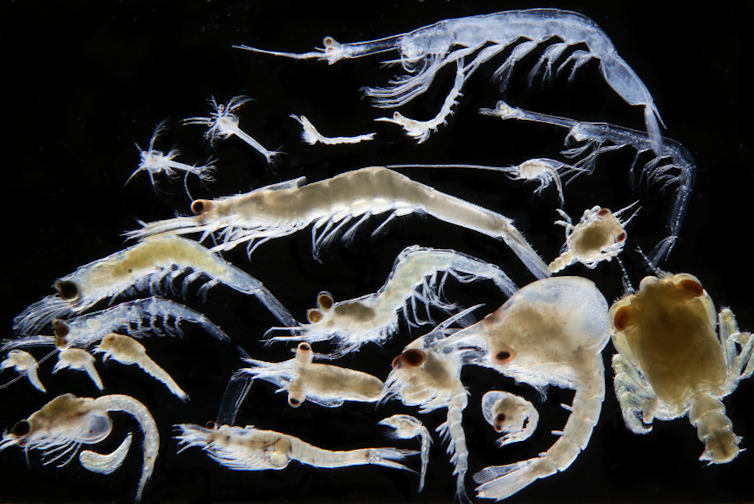
The ocean holds 60 times more carbon than the atmosphere and absorbs almost 30% of carbon dioxide (CO₂) emissions from human activities. This means the ocean is key to understanding the global carbon cycle and thus our future climate.
The Intergovernmental Panel on Climate Change (IPCC) uses earth system models to project climate change. These projections inform critical political, social and technological decisions. However, if we can’t accurately model the marine carbon cycle then we cannot truly understand how Earth’s climate will respond to different emission scenarios.
In research published today, we show that zooplankton, tiny animals near the base of the ocean food chain, are likely to be the biggest source of uncertainty in how we model the marine carbon cycle. Getting their impact on the cycle right could add an extra 2 billion tonnes to current models’ assumptions about annual carbon uptake by the ocean. That’s more carbon than the entire global transportation sector emits.
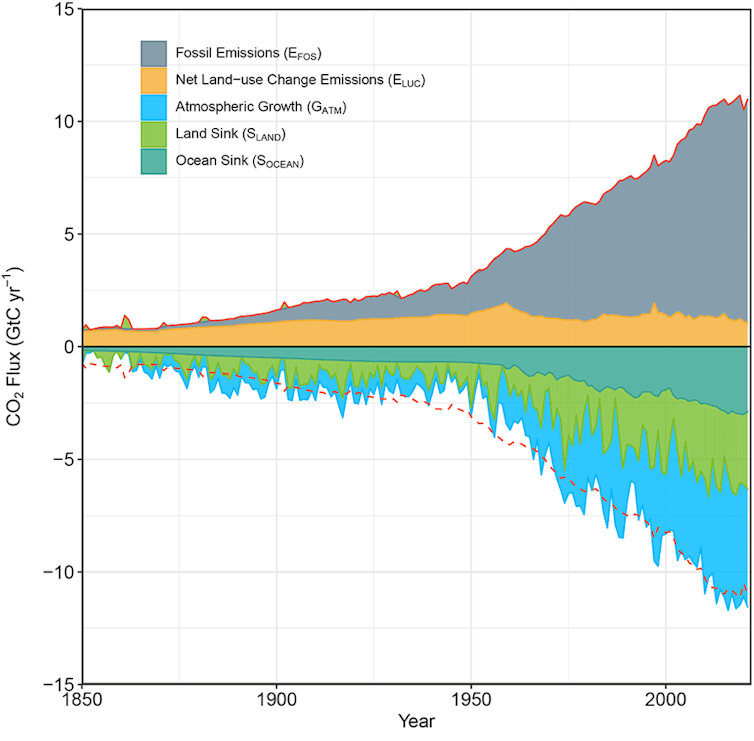
Marine Carbon Cycling Is A $3 Trillion Thermostat
Roughly 10 billion tonnes of carbon are being released into the atmosphere each year. But the ocean quickly absorbs about 3 billion tonnes of these emissions, leaving our climate cooler and more hospitable. If we price carbon at the rate the IPCC believes is needed to limit warming to 1.5℃, this adds up to over A$3 trillion worth of emission reductions accomplished naturally by the ocean every year.
However, we know the size of the ocean carbon sink has changed in the past, and even small changes can lead to big changes in the atmosphere’s temperature. Thus, we understand the ocean acts as a thermostat for our climate. But what controls the dial?
Extensive geological evidence suggests microscopic marine life could be in control. Phytoplankton photosynthesise and consume as much CO₂ as all land plants.
When phytoplankton die, they sink and trap much of their carbon deep in the ocean. It can remain there for centuries to millennia, locked away safely out of contact with the atmosphere.
Any changes to the strength of this biological carbon pump will be felt in the atmosphere and will change our climate. Some have even proposed enhancing this biological pump by artificially fertilising the ocean with iron to stimulate phytoplankton. It’s possible this could sequester as much as an extra 20% of our annual CO₂ emissions.
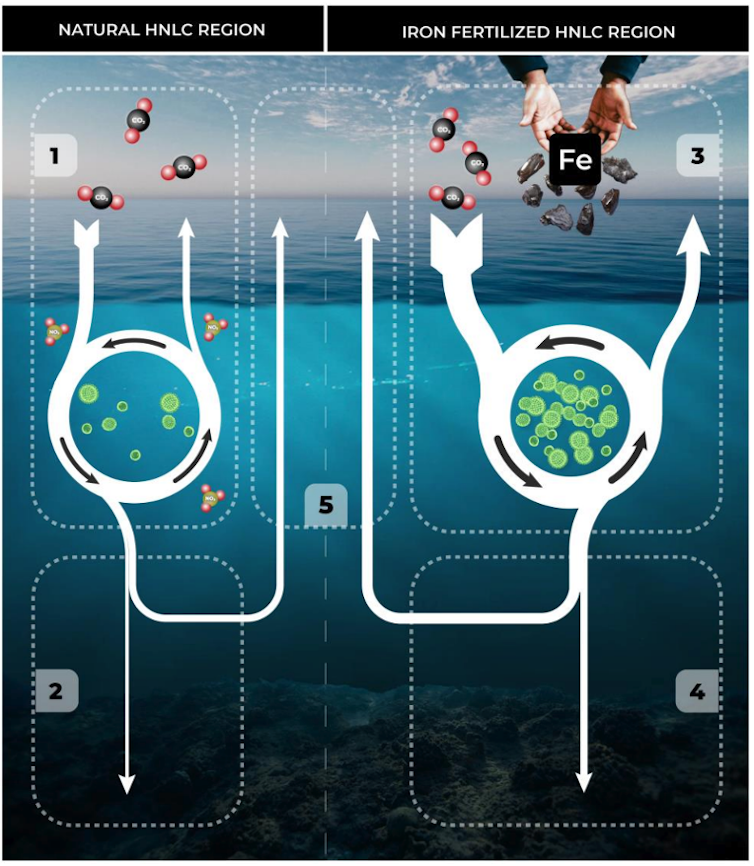
Right For The Wrong Reasons
Despite its importance for the global climate and food production, there are large gaps in our understanding of how the marine carbon cycle is expected to change. Most earth system models differ in how the cycle’s major components will respond to a changing climate. Models simply can’t agree on what will happen to:
net primary production – the carbon consumed by phytoplankton resulting in growth of marine plants at the base of the food web
secondary production – zooplankton growth, which is an indicator for fisheries, since fish eat zooplankton
export production – the biological pump of carbon transferred to the deep sea.
To diagnose what might be going wrong, we compared the marine carbon cycle in 11 IPCC earth system models. We found the largest source of uncertainty is how fast zooplankton consume their phytoplankton prey, known as grazing pressure.
Models differ hugely in their assumptions about this grazing pressure. Even if zooplankton were exposed to the exact same amount of phytoplankton, the highest assumed grazing rate would be almost 100 times as fast as the slowest rate.
This is because some models effectively assume the ocean is filled entirely with slow-grazing shrimp. Others assume it is teeming exclusively with microscopic, but rapidly grazing ciliates. In reality, neither is true.
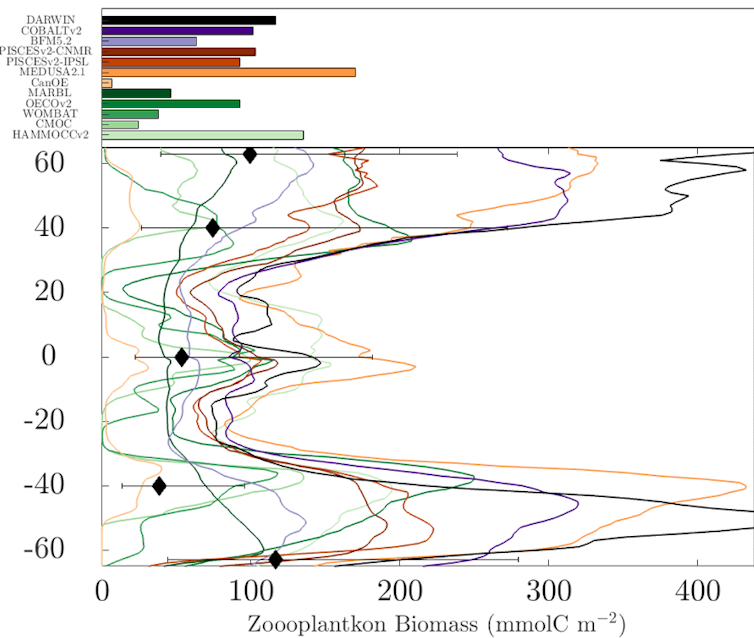
Models must make up for such large differences in zooplankton grazing by making additional assumptions about how fast phytoplankton grow and how quickly zooplankton die. Together, these differences can be balanced in a way that allows most models to simulate the present-day amount of carbon consumed by phytoplankton and transferred to the deep sea.
However, that is only because we can observe what those values should be. We can then tune models until we ensure they get the right answer.
Yet, even though our best models can admirably recreate the present-day ocean, they do so for different reasons and with dramatically different assumptions about the role of zooplankton. This means these models are built with fundamentally different machinery. When used to test future emissions scenarios, they will project fundamentally different outcomes.
We cannot know which projections are correct unless we know the true role of zooplankton.
Tiny Plankton With A Big Impact
We ran a sensitivity experiment to show how small changes in zooplankton grazing can dramatically alter marine carbon cycling. We considered two sets of experiments, one control and one in which we increased both zooplankton grazing rates and phytoplankton growth rates, such that both were tuned to the exact same total carbon consumption by phytoplankton.
This increase in how fast zooplankton can graze was only a fraction of the difference between assumed grazing rates seen across IPCC models. Despite this, we found even this small increase led to a huge difference in the percentage of carbon consumed by phytoplankton that was eventually exported to depth and transferred up the food chain.
Ocean carbon storage increased by 2 billion tonnes per year. Zooplankton carbon consumption increased by 5 billion tonnes.
From a climate perspective, that is double the maximum theoretical potential of iron fertilisation. From a fisheries perspective, that leads to a 50% increase in the size of the global zooplankton population on which many fish feed. This matters for global food supply as the ocean feeds 10% of the global population.
This work shows we must improve both our understanding and modelling of zooplankton. With limited resources and an immense ocean, we will never have enough observations to build perfect models. However, new technologies for measuring zooplankton are making it easier to make autonomous, high-resolution measurements of many important variables.
We must make a concerted effort to leverage these new technologies to better understand the role of zooplankton in the marine carbon cycle. We will then be able to reduce uncertainties about future climate states, advance our ability to assess marine-based CO₂ removal, and improve global fisheries projections.![]()
Tyler Rohr, Lecturer in Southern Ocean Biogeochemical Modelling, IMAS, University of Tasmania; Anthony Richardson, Professor, The University of Queensland, and Elizabeth Shadwick, Team Leader, Oceans & Atmosphere, CSIRO
This article is republished from The Conversation under a Creative Commons license. Read the original article.
Are tree-changers bad at managing their rural properties? A new study wades into the weeds to find the answer
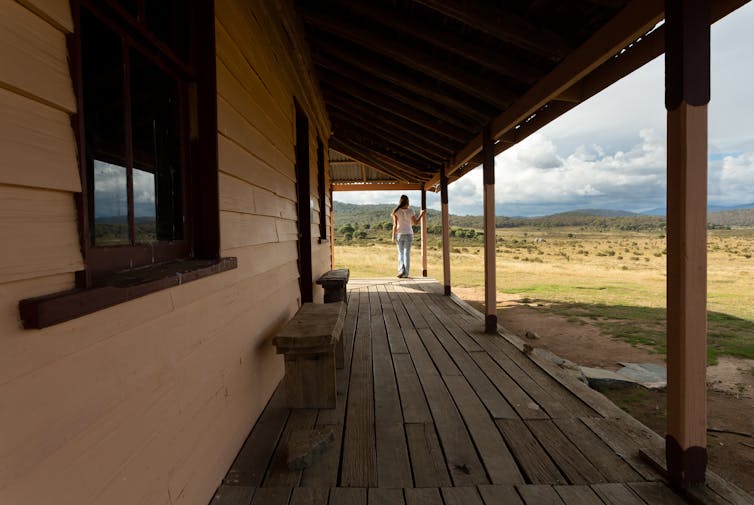
Tree-changers opting for a rural lifestyle can get a bad rap for not managing their properties well. The COVID-19 pandemic prompted thousands more city-based Australians to buy property in the regions. So will this lead to more absentee neighbours who, in the eyes of some, don’t know what they’re doing?
If you buy rural land, you are buying into a community. You’re also expected to take on certain responsibilities, such as managing weeds on the property. This helps both the environment and your neighbours.
Tensions about weeds can be especially high in areas with many tree-changers. Farmers, for example, may think new arrivals don’t care about how weeds affect agriculture, creating an “us and them” mentality. But are these perceptions warranted?
Our new paper examined this question. We found almost everyone, including absentee landowners, were concerned about weeds and spent a lot of time managing them. But their motivations for doing so were different. These insights can help communities deal with the threat of invasive plants.
Tree-Changers: Friend Or Foe?
An estimated 22-45% of landowners in Australia are absentee. They might be corporations, Indigenous groups or farmers leasing their land to others. They can also be tree-changers who are generally more interested in rural lifestyles and “getting into nature” than farming the land. This group may visit their properties only on weekends or for holidays.
Of all absentee landowners, tree-changers can readily attract complaints because of the significant changes they bring to the look and culture of rural areas. They often occupy former farmland and may cease farming, engage in conservation work, build new houses or just ride motorbikes all weekend.
Absentee landholders can own vast swathes of land. So the way they manage their properties, including managing weeds, can have big consequences.
Weeds can cause economic and environmental harm. They may lower crop productivity and damage pastures. They can also out-compete native vegetation and disrupt ecosystems.
Weed control methods include herbicides, intensive grazing with goats, or removal by hand or with machinery.
Government agencies say absentee landholders can be hard to contact and lack knowledge about weeds. They can also be time-poor and absent at times when weed spraying or removal is most effective.
But weed control requires all landowners to pull their weight. People can feel their efforts are wasted if neighbours do little.
In places such as the Southern Tablelands in New South Wales, absentee landholders have been blamed for enabling the spread of a noxious weed known as serrated tussock. The species damages pastures and is difficult for stock to digest.
The Evidence Is Mixed
So what does the research say on the matter? One literature review in the United States found absentee owners, as compared with resident owners, were less likely to actively manage their land and had less scientific knowledge.
But another US study did not identify residential status as a factor in weed management.
In Australia, research tends to note absentee owners as an issue for weed management. One small study, however, found absentee landholders in Central West NSW were engaged, interested in collaboration on weed management, and reasonably knowledgeable.
Another study found length of ownership was a greater influence on land management than residential status.
Our research aimed to better understand whether absentee land ownership in Australia makes a difference to how weeds were managed.
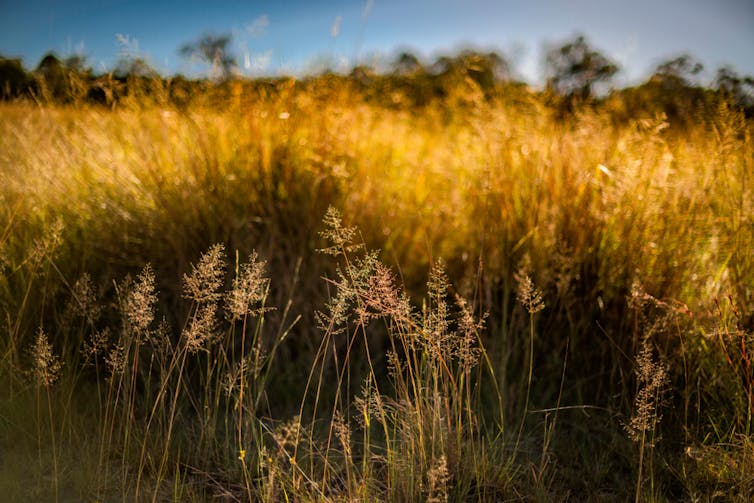
Our Results
Our research focused on the Shoalhaven and Bega Valley in southeastern NSW. These regions have experienced an influx of tree-changers in recent decades. They include towns such as Bega, Bowral, Candelo, Berry, Kangaroo Valley and Nowra.
We surveyed 439 landowners about their behaviours and attitudes toward weeds and their management. We then compared the responses of residential owners (88% of respondents) and absentee landowners (12%). We excluded responses from farmers and focused on “lifestylers”, which are themselves a significant group.
Both groups said weeds negatively affected them due to how they looked and the environmental damage they caused. Similar proportions of each group were trying to eradicate or control weeds.
Almost everyone was concerned about weeds. Both groups said weed management was a priority and said being a good neighbour was a primary motivation for taking action.
An overwhelming number of people in both groups managed weeds (and spent one to five hours per week doing so). One of the few significant differences between the groups was that residential landowners prioritised weeds that damaged agriculture, while absentee landowners prioritised weeds that threatened the environment.
This shows how values and interests, rather than indifference, shapes attitudes to weed management.
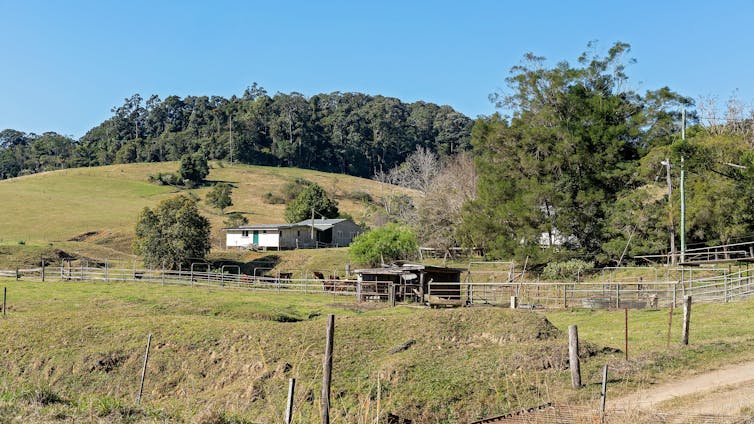
Look Beyond Where People Live
Weed management is determined by our varying social relationships with the land. This must be recognised in both research and policy.
Landowners are diverse and own land for a variety of reasons. Our approach to weed management should take account of these differences. Absenteeism is just one part of the puzzle – and perhaps not as important as we might think.
More research is needed. This should involve in-depth case studies to tease out the issues underpinning community tensions about weed management and identify common ground. Then, we can develop steps towards more effective weed management across fence lines.![]()
Nicholas Gill, Associate Professor in Geography, University of Wollongong; Anna Lewis, Research Program Manager, University of Wollongong, and Laurie Chisholm, Associate Professor in Remote Sensing, University of Wollongong
This article is republished from The Conversation under a Creative Commons license. Read the original article.
Meet the biggest and most bizarre skink ever found in Australia. It became extinct 47,000 years ago
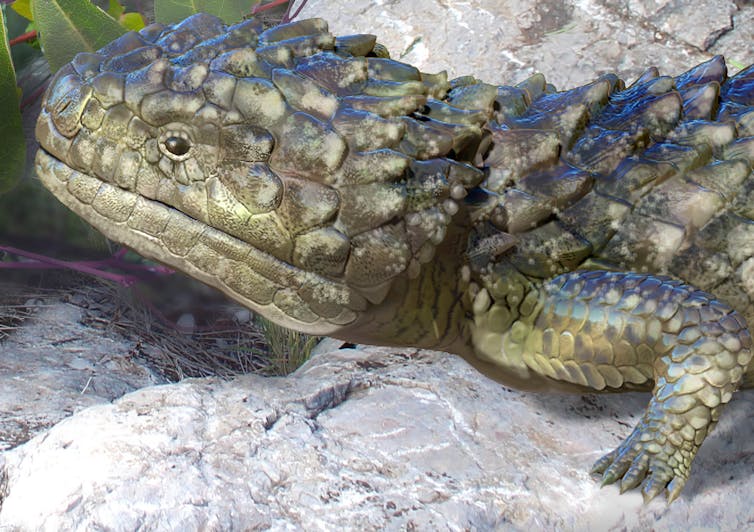
Many of the giant marsupials and birds that roamed ancient Australia had vanished by 40,000 years ago. While the duration and drivers of these extinctions remain debated, fossils clearly show the continent lost a host of creatures which would have dwarfed humans, such as short-faced kangaroos, diprotodons, “thunder birds” and giant goannas.
Our study published today in Proceedings of the Royal Society B suggests these end-Pleistocene extinctions also affected smaller creatures such as lizards. These animals comprise most of biodiversity and biomass.
A Bizarre Giant Among Tiny Lizards
The most diverse land vertebrates in modern Australia are skinks, which are typically the tiny, nondescript brown lizards that scurry among leaf litter.
There are some larger and more charismatic forms, such as blue-tongues and shinglebacks (also known as sleepy lizards or bobtails). However, even these are dwarfed by our new fossil skink, Tiliqua frangens (or Frangens), which was more than 60cm long and weighed more than 2kg. This 1,000 times heavier than your typical garden skink.
Frangens was bizarre in many ways: it was covered in very thick, spiky armour and had an extremely wide but blunt skull. Frangens was an enlarged and exaggerated version of its closest living relative, the shingleback, which has these traits but to a much lesser degree.
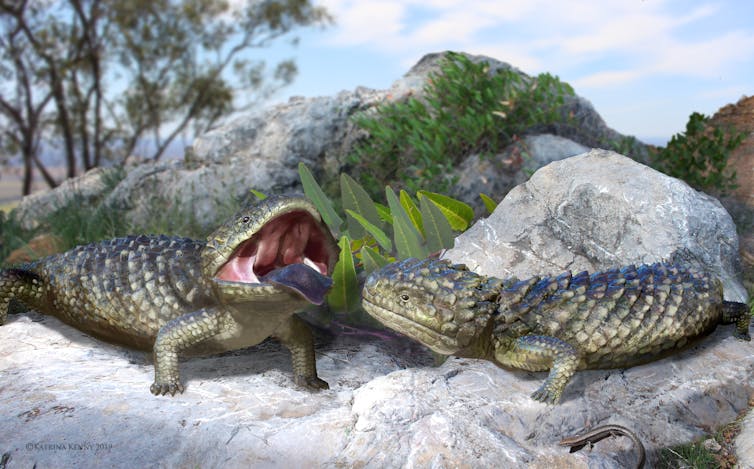
While our large mammalian and avian megafauna are well studied, smaller fossil lizards and snakes are often overlooked. Most of the fossils used to piece together this extinct critter have been sitting in museum collections for decades - some for more than a century.
A Jigsaw Puzzle With Pieces Scattered All Over Australia
The first two pieces of this creature, a partial lower jaw and skull-roof bone, were found separately in spoil heaps at Wellington Caves, about 200km west of Sydney in 1995 and 2008. These fragments were scientifically described as different species in 2009 and 2012.
Then in 2016, palaeontologists from Flinders University began finding more fossils of a large skink in Cathedral Cave at Wellington Caves. Frangens immediately stood out not just for its unusual size, but for its spikey body armour, abundant in the dig site yet oddly never reported before.
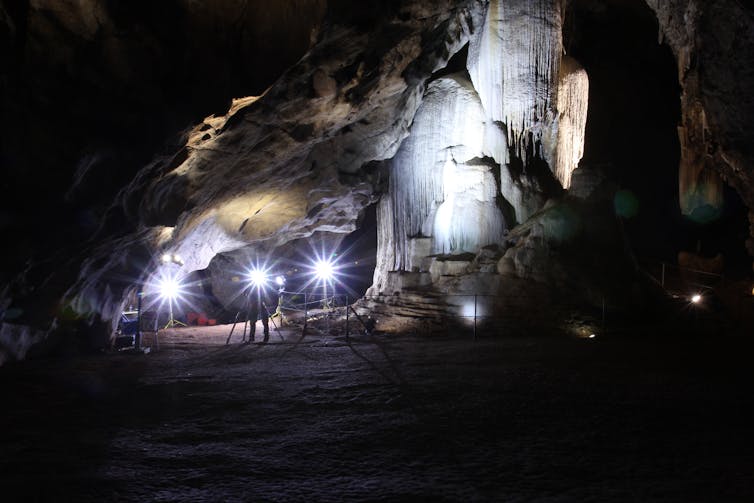
A study tour of the palaeontology sections of the Australian, South Australian and Melbourne museums brought to light the importance of their collections. Sitting in drawers of unidentified reptiles were near-complete jaws, perfectly preserved braincases, and chunks of fused armour plating from the head of Frangens.
The Queensland Museum had put aside a specimen representing most of a single individual, waiting for someone with the patience and expertise to piece it together.
It became clear the original lower jaw and skull roof, plus all the subsequent material, belonged to a single species.
This wealth of fossils also broadened our understanding of the spatial and temporal range of this highly distinct lizard. Frangens fossils have been recovered from southeastern Queensland through to the northern banks of the Murray River in New South Wales. The fossils range in age from at least 2 million years to 47,000 years old. So Frangens was part of the fauna when the First Peoples arrived.
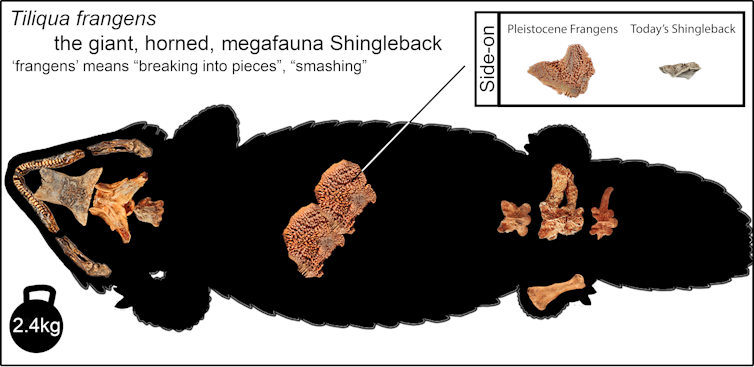
A Lost Lizard That Functioned More Like A Tortoise?
Australia has never had small land tortoises. Tortoises are completely absent in modern Australia, while the famously large meiolaniid turtles are extinct.
It is possible that in Australia, the heavily armoured, slow-moving Frangens filled the ecological niche that small tortoises occupy on other continents.
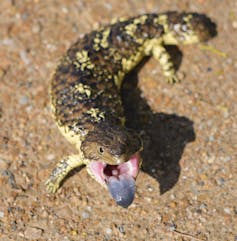
Intriguingly, in none of the fossil sites we have explored, do Frangens and the modern shingleback co-occur. Instead, only after Frangens went extinct did shinglebacks expand northward and increase in size: those ranging from the Murray to southeastern Queensland are among Australia’s largest living skinks (reaching up to 1kg).
Nature abhors a vacuum, so these shinglebacks might be growing big to fill the gap left by Frangens, which in turn previously filled the gap caused by the absence of small tortoises.
Furthermore, Frangens was not alone, but was part of a cohort of giant skinks, none of which survived past the end-Pleistocene extinctions.
These fossils show that the extinctions were not confined to “megafauna” – the largest examples of the largest groups. Rather, even some smaller animals such as skinks once had (relatively) large forms, which perished in the late Pleistocene along with giant marsupials and flightless birds.![]()
Mike Lee, Professor in Evolutionary Biology (jointly appointed with South Australian Museum), Flinders University; Diana Fusco, Casual academic, Flinders University, and Kailah Thorn, Technical Officer, Western Australian Museum
This article is republished from The Conversation under a Creative Commons license. Read the original article.
Limiting global warming to 2℃ is not enough – why the world must keep temperature rise below 1℃

The Paris Climate agreement represented a historic step towards a safer future for humanity on Earth when it was adopted in 2015. The agreement strove to keep global heating below 2℃ above pre-industrial levels with the aim of limiting the increase to 1.5℃ if possible. It was signed by 196 parties around the world, representing the overwhelming majority of humanity.
But in the intervening eight years, the Arctic region has experienced record-breaking temperatures, heatwaves have gripped many parts of Asia and Australia has faced unprecedented floods and wildfires. These events remind us of the dangers associated with climate breakdown. Our newly published research argues instead that humanity is only safe at 1℃ of global warming or below.
While one extreme event cannot be solely attributed to global heating, scientific studies have shown that such events are much more likely in a warmer world. Since the Paris agreement, our understanding of the impacts of global heating have also improved.
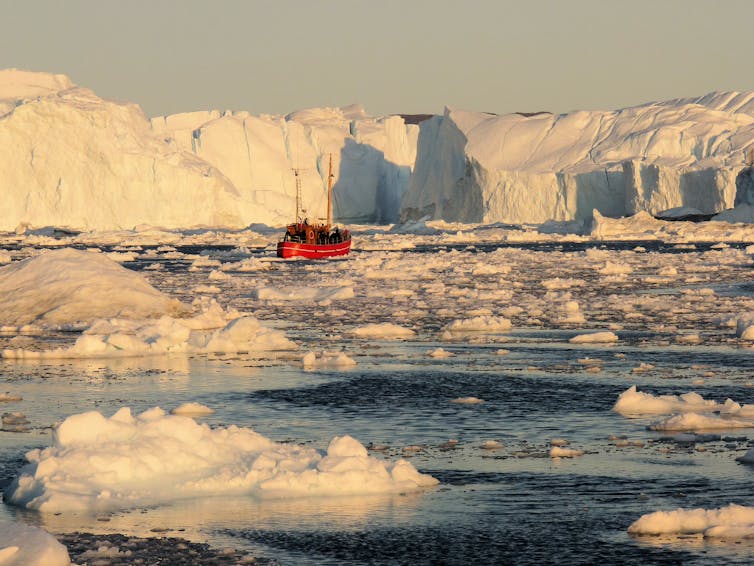
Rising sea levels are an inevitable consequence of global warming. This is due to the combination of increased land ice melting and warmer oceans, which cause the volume of ocean water to increase. Recent research shows that in order to eliminate the human-induced component of sea-level rise, we need to return to temperatures last seen in the pre-industrial era (usually taken to be around 1850).
Perhaps more worrying are tipping points in the climate system that are effectively irreversible on human timescales if passed. Two of these tipping points relate to the melting of the Greenland and West Antarctic ice sheets. Together, these sheets contain enough ice to raise the global sea level by more than ten metres.
The temperature threshold for these ice sheets is uncertain, but we know that it lies close to 1.5℃ of global heating above pre-industrial era levels. There’s even evidence that suggests the threshold may already have been passed in one part of west Antarctica.
Critical Boundaries
A temperature change of 1.5℃ might sound quite small. But it’s worth noting that the rise of modern civilisation and the agricultural revolution some 12,000 years ago took place during a period of exceptionally stable temperatures.
Our food production, global infrastructure and ecosystem services (the goods and services provided by ecosystems to humans) are all intimately tied to that stable climate. For example, historical evidence shows that a period called the little ice age (1400-1850), when glaciers grew extensively in the northern hemisphere and frost fairs were held annually on the River Thames, was caused by a much smaller temperature change of only about 0.3℃.
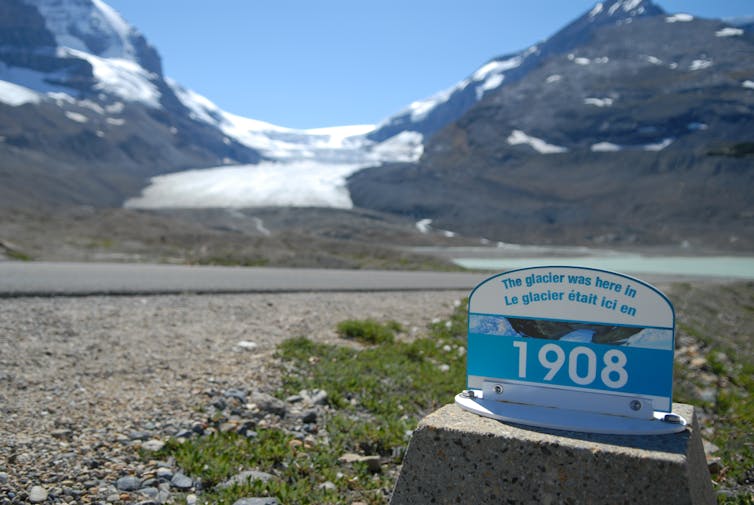
A recent review of the current research in this area introduces a concept called “Earth system boundaries”, which defines various thresholds beyond which life on our planet would suffer substantial harm. To avoid passing multiple critical boundaries, the authors stress the need to limit temperature rise to 1℃ or less.
In our new research, we also argue that warming of more than 1℃ risks unsafe and harmful outcomes. This potentially includes sea level rise of multiple metres, more intense hurricanes and more frequent weather extremes.
More Affordable Renewable Energy
Although we are already at 1.2℃ above pre-industrial temperatures, reducing global temperatures is not an impossible task. Our research presents a roadmap based on current technologies that can help us work towards achieving the 1℃ warming goal. We do not need to pull a technological “rabbit out of the hat”, but instead we need to invest and implement existing approaches, such as renewable energy, at scale.
Renewable energy sources have become increasingly affordable over time. Between 2010 and 2021, the cost of producing electricity from solar energy reduced by 88%, while wind power saw a reduction of 67% over the same period. The cost of power storage in batteries (for when the availability of wind and sunlight is low) has also decreased, by 70% between 2014 and 2020.

The cost disparity between renewable energy and alternative sources like nuclear and fossil fuels is now huge – there is a three to four-fold difference.
In addition to being affordable, renewable energy sources are abundantly available and could swiftly meet society’s energy demands. Massive capacity expansions are also currently underway across the globe, which will only further bolster the renewable energy sector. Global solar energy manufacturing capacity, for example, is expected to double in 2023 and 2024.
Removing Carbon Dioxide From The Atmosphere
Low-cost renewable energy will enable our energy systems to transition away from fossil fuels. But it also provides the means of directly removing CO₂ from the atmosphere at a large scale.
CO₂ removal is crucial for keeping warming to 1℃ or less, even though it requires a significant amount of energy. According to research, achieving a safe climate would require dedicating between 5% and 10% of total power generation demand to effective CO₂ removal. This represents a realistic and attainable policy option.
Various measures are used to remove CO₂ from the atmosphere. These include nature-based solutions like reforestation, as well as direct air carbon capture and storage. Trees absorb CO₂ from the atmosphere through photosynthesis and then lock it up for centuries.
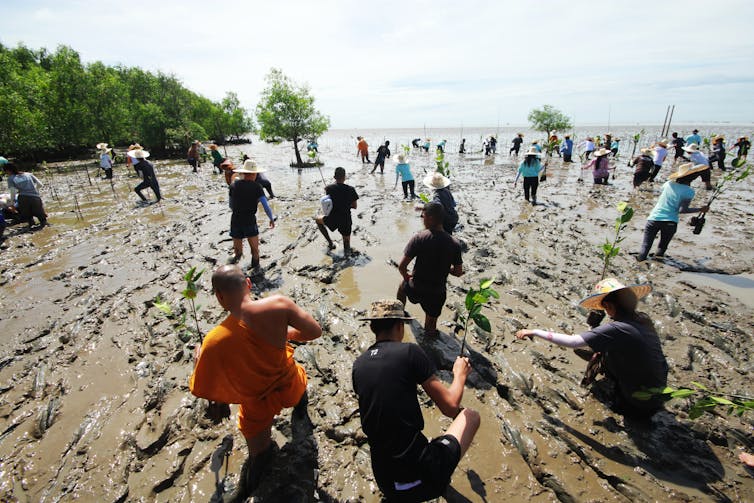
Direct air capture technology was originally developed in the 1960s for air purification on submarines and spacecrafts. But it has since been further adapted for use on land. When combined with underground storage methods, such as the process of converting CO₂ into stone, this technology provides a safe and permanent method of removing CO₂ from the atmosphere.
Our paper demonstrates that the tools and technology exist to achieve a safer, healthier and more prosperous future – and that it’s economically viable to do so. What appears to be lacking is the societal will and, as a consequence, the political conviction and commitment to achieve it.

Don’t have time to read about climate change as much as you’d like?
Get a weekly roundup in your inbox instead. Every Wednesday, The Conversation’s environment editor writes Imagine, a short email that goes a little deeper into just one climate issue. Join the 20,000+ readers who’ve subscribed so far.![]()
Jonathan Bamber, Professor of Glaciology and Earth Observation, University of Bristol and Christian Breyer, Professor of Solar Economy, Lappeenranta University of Technology
This article is republished from The Conversation under a Creative Commons license. Read the original article.
Bees and hoverflies are key to growing more fruit and veg in cities – new research
Elizabeth Nicholls, University of SussexAccessing affordable fruit and vegetables is a significant challenge for the 1.2 million UK residents living in what are known as “food deserts”.
People in these neighbourhoods are unable to purchase fresh food within walking distance or via a quick trip on public transport. Instead, they have to choose between shopping at convenience stores with scarce fresh food in stock or spending some of their food budget on transportation.
But there is a solution. Growing fruit and vegetables in cities is an effective and sustainable way of improving many urban residents’ access to fresh produce. In newly published research on urban UK allotments, my colleagues and I found that maintaining a diversity of insects in our cities is an important part of this.
Urban farms, which account for around 6% of all farmland worldwide, have the potential to supply a significant amount of fresh food. Several studies, including those based on data collected by urban growers themselves, have demonstrated that small urban farms (typically allotments or community and market gardens that are less than two hectares in size) can match the productivity of conventional rural farms in terms of food production per unit area.
But even in cities, humans rely on animals pollinating their food crops. In fact, approximately three-quarters of the world’s leading food crops depend on insects for pollination.
Yet our understanding of which insects pollinate specific crops in urban areas, and whether there are even enough insects in our cities to sustain fruit and vegetable production, remains limited.
Most research on crop pollination has focused on rural areas, leaving us with limited information about urban settings. While the role of insect groups like flies and wasps in crop pollination has only gained recognition relatively recently.
We found that most crops are visited by a broad range of insects. Bumblebees and hoverflies emerged as two of the most important pollinators. But we also found that some crops, such as strawberries, struggle to attract enough pollinating insects to produce a quality crop.

Top Of The Crops
Pollinating insects, such as bees, beetles, flies, butterflies and wasps visit flowers to collect pollen and nectar as a source of food. Through this process, they fertilise the flower, enabling development of seeds and growth of fruit or vegetables.
Our study involved conducting over 1,000 surveys in allotments across the city of Brighton & Hove in the south of England. During our surveys, we recorded the number of pollinators visiting crop flowers.
We found that fruit trees, including apples, and bushes like raspberries and blackberries, were most popular with insect visitors, receiving the most visits per flower.
Bumblebees visited the widest range of crops, including fruit trees, beans, pumpkins and tomatoes. This shouldn’t come as a surprise. Bees are typically considered the most important pollinators in fruit orchards.
But in our study, hoverflies were the main visitor to fruit trees. This finding aligns with research from 2020 that ranked flies as the second-most important crop pollinator after bees, visiting 72% of crop plants worldwide.

With the data we collected, we created a visual representation resembling a “social network” of the interactions between different crops and insects. Our findings revealed that many of the crops that are cultivated in urban areas attract a diverse array of insect groups.
Apple flowers, for example, were visited by every type of pollinator except wasps. By contrast, cucumbers were visited by every group expect butterflies. These results suggest that maintaining a diversity of insects may be key for crop pollination in cities.
Strawberries Need A Helping Hand
We also conducted an experiment with strawberries to test whether there are enough insects in urban allotments to effectively pollinate these crops. We assigned two similar sized plants to either a supplemental pollination treatment – where we transferred pollen between flowers by hand with a paintbrush – or open pollination where we relied on the insects to pollinate the plants.
The strawberry plants that were pollinated naturally by insects produced lower quality fruit than those receiving supplemental pollination by hand. This finding suggests that we need to improve the quality of insect pollination that some crops receive in cities.
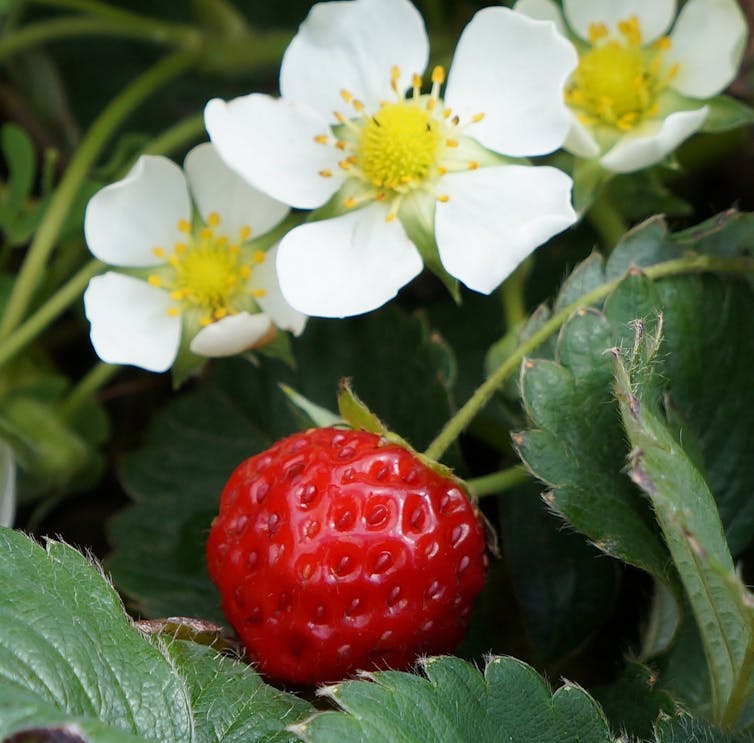
Food For Cities
Improving crop pollination in cities could be achieved by increasing the availability of food and nesting habitat for insects. A separate study that I co-authored in 2020 demonstrated that planting flowers that produce lots of pollen and nectar, such as borage, alongside crops in allotments and gardens can increase the amount of food that is harvested.
We found that strawberry plants grown near borage plants produced a greater quantity of fruits that were larger and of superior quality compared to strawberry plants located further away from other flowering plants.
Our new study offers an insight into which specific pollinators we need to encourage to support and expand urban fruit and vegetable production. For instance, hoverflies are effective pollinators of strawberries.
So providing nesting habitat like hoverfly lagoons for these insects could increase their abundance in urban areas, ensuring more effective pollination and better strawberry harvests in the future.
Growing more food in cities has the potential to improve people’s access to fresh produce. But maintaining a diverse range of insects to pollinate those crops is an important factor in this. Only then will we be able to sustain and expand urban food production for the benefit of city dwellers.![]()
Elizabeth Nicholls, Research Fellow in Ecology, University of Sussex
This article is republished from The Conversation under a Creative Commons license. Read the original article.
Hotter Sand From Microplastics Could Affect Sea Turtle Development
June 13, 2023
New research from Florida State University published in Frontiers in Marine Science found that extreme concentrations of microplastics could increase the temperature of beach sand enough to threaten the development of incubating sea turtles.
Sea turtles play a vital role in the marine ecosystem, and for these oceangoing reptiles to thrive, they need healthy beaches where their eggs can incubate successfully.
"Sea turtle sex, fitness and hatchling success is influenced by temperature," said lead author Mariana Fuentes, an associate professor in FSU's Department of Earth, Ocean and Atmospheric Science. "Not much is known on how the presence of microplastic affects the thermal profile of sand. Understanding how changes to the environment could affect the temperature of nesting grounds is important for monitoring the future of these keystone species."
Researchers mixed sand from beaches at the FSU Coastal and Marine Laboratory with black and white microplastic. Concentrations of microplastic ranged from 5% to 30% of the total volume of the sediment sample. Then they recorded temperatures from July through September 2018 by burying digital thermometers at the same depth at which loggerhead sea turtles typically lay their eggs.
They found that samples with higher microplastic concentrations had greater increases in temperature, with the sample containing 30% black microplastic pieces having the highest mean difference in temperature. Those samples were 0.58 degrees Celsius warmer than the control group, an increase that could potentially significantly alter sea turtle hatchling sex ratios, physiological performance, and mortality of embryos.
The good news from the study is that the 30% concentration of microplastics in those samples equates to about 9.8 million pieces per cubic meter, a higher concentration than has been currently found on beaches worldwide. Current research has found the highest reported concentrations collected from beaches is about 1.8 million pieces per cubic meter.
But the amount of microplastics at nesting sites has only recently been explored. It could be higher in locations that haven't been studied yet, and demand for plastic is forecast to increase in the future.
At nesting grounds where incubating eggs are near a 29-degree Celsius boundary -- below which most hatchlings are male, and above which most hatchlings are female -- smaller concentrations of plastic could be enough to push the temperature beyond a crucial threshold.
"Sea turtle eggs are sensitive to temperature, and microplastics are another factor adding to the heat they face," Fuentes said. "This study gives us a baseline for future research on how they are affecting the nesting environment."
The research was supported by FSU's Garnet and Gold Scholar Society. Researchers with the University of Florida and the University of North Carolina Wilmington were co-authors on this study.
Mariana M. P. B. Fuentes, Valencia Beckwidth, Matthew Ware. The effects of microplastic on the thermal profile of sand: implications for marine turtle nesting grounds. Frontiers in Marine Science, 2023; 10 DOI: 10.3389/fmars.2023.1146556
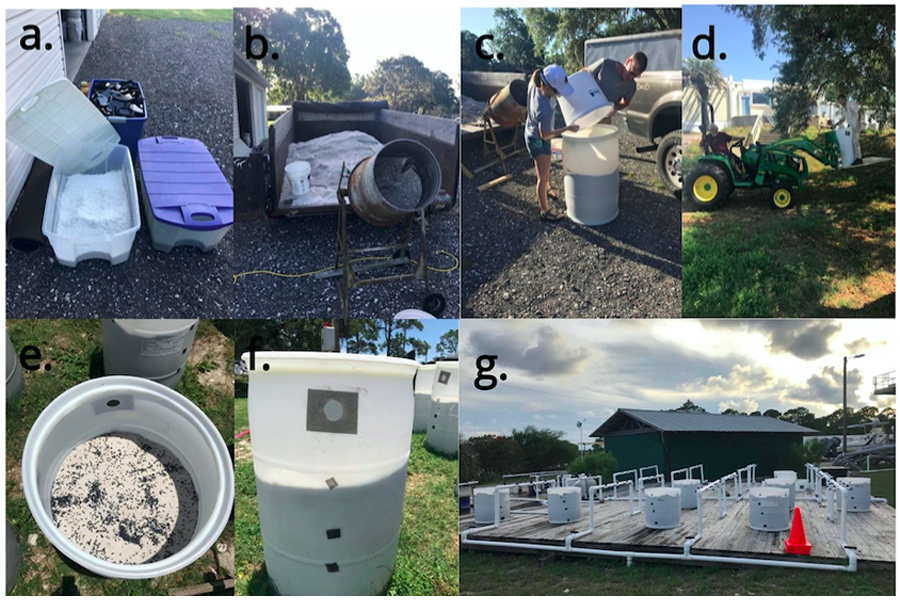
An overview of the experimental process showing: a) White and black microplastic, b) sand and a mixing tool, c) pouring sand and microplastics into a container, d) transporting containers at the FSU Coastal and Marine Laboratory, e) top view of container, f) another view showing a mesh screen over holes, and g) the experiment site. (Courtesy of Mariana Fuentes)
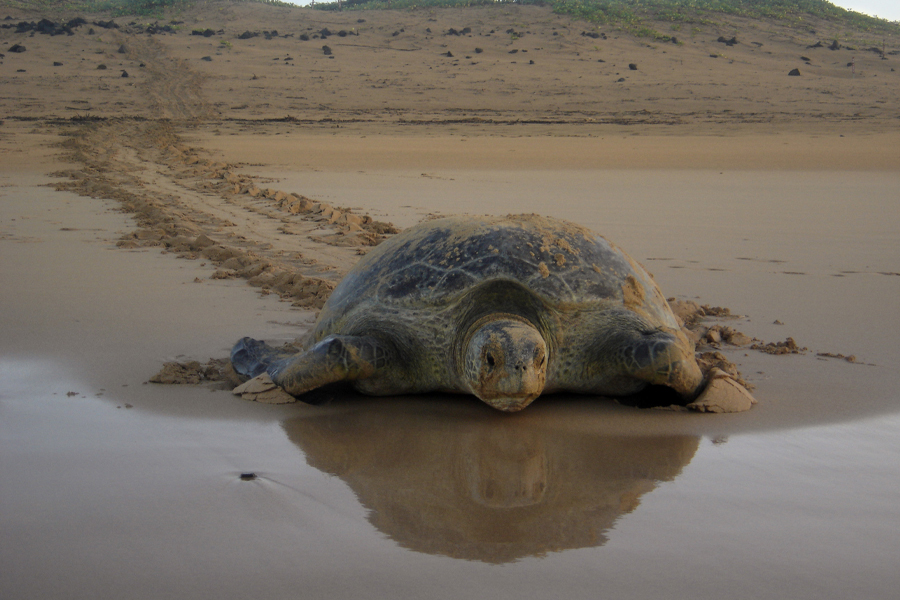
A green turtle (Chelonia mydas) crawling toward the ocean. (Photo courtesy of Fundação Projeto TAMAR)
Pittwater Reserves: Histories + Notes + Pictorial Walks
A History Of The Campaign For Preservation Of The Warriewood Escarpment by David Palmer OAM and Angus Gordon OAM
A Stroll Through Warriewood Wetlands by Joe Mills February 2023
A Walk Around The Cromer Side Of Narrabeen Lake by Joe Mills
America Bay Track Walk - photos by Joe Mills
An Aquatic June: North Narrabeen - Turimetta - Collaroy photos by Joe Mills
Angophora Reserve Angophora Reserve Flowers Grand Old Tree Of Angophora Reserve Falls Back To The Earth - History page
Annie Wyatt Reserve - A Pictorial
Avalon's Village Green: Avalon Park Becomes Dunbar Park - Some History + Toongari Reserve and Catalpa Reserve
Bairne Walking Track Ku-Ring-Gai Chase NP by Kevin Murray
Bangalley Headland Bangalley Mid Winter
Banksias of Pittwater
Barrenjoey Boathouse In Governor Phillip Park Part Of Our Community For 75 Years: Photos From The Collection Of Russell Walton, Son Of Victor Walton
Barrenjoey Headland: Spring flowers
Barrenjoey Headland after fire
Bayview Baths
Bayview Wetlands
Beeby Park
Bilgola Beach
Botham Beach by Barbara Davies
Bungan Beach Bush Care
Careel Bay Saltmarsh plants
Careel Bay Birds
Careel Bay Clean Up day
Careel Bay Playing Fields History and Current
Careel Creek
Careel Creek - If you rebuild it they will come
Centre trail in Ku-ring-gai Chase National Park
Chiltern Track- Ingleside by Marita Macrae
Clareville Beach
Clareville/Long Beach Reserve + some History
Coastal Stability Series: Cabbage Tree Bay To Barrenjoey To Observation Point by John Illingsworth, Pittwater Pathways, and Dr. Peter Mitchell OAM
Cowan Track by Kevin Murray
Curl Curl To Freshwater Walk: October 2021 by Kevin Murray and Joe Mills
Currawong and Palm Beach Views - Winter 2018
Currawong-Mackerel-The Basin A Stroll In Early November 2021 - photos by Selena Griffith
Currawong State Park Currawong Beach + Currawong Creek
Deep Creek To Warriewood Walk photos by Joe Mills
Drone Gives A New View On Coastal Stability; Bungan: Bungan Headland To Newport Beach + Bilgola: North Newport Beach To Avalon + Bangalley: Avalon Headland To Palm Beach
Duck Holes: McCarrs Creek by Joe Mills
Dunbar Park - Some History + Toongari Reserve and Catalpa Reserve
Dundundra Falls Reserve: August 2020 photos by Selena Griffith - Listed in 1935
Elsie Track, Scotland Island
Elvina Track in Late Winter 2019 by Penny Gleen
Elvina Bay Walking Track: Spring 2020 photos by Joe Mills
Elvina Bay-Lovett Bay Loop Spring 2020 by Kevin Murray and Joe Mills
Fern Creek - Ingleside Escarpment To Warriewood Walk + Some History photos by Joe Mills
Iluka Park, Woorak Park, Pittwater Park, Sand Point Reserve, Snapperman Beach Reserve - Palm Beach: Some History
Ingleside
Ingleside Wildflowers August 2013
Irrawong - Ingleside Escarpment Trail Walk Spring 2020 photos by Joe Mills
Irrawong - Mullet Creek Restoration
Katandra Bushland Sanctuary - Ingleside
Lucinda Park, Palm Beach: Some History + 2022 Pictures
McCarrs Creek
McCarr's Creek to Church Point to Bayview Waterfront Path
McKay Reserve
Mona Vale Beach - A Stroll Along, Spring 2021 by Kevin Murray
Mona Vale Headland, Basin and Beach Restoration
Mona Vale Woolworths Front Entrance Gets Garden Upgrade: A Few Notes On The Site's History
Mount Murray Anderson Walking Track by Kevin Murray and Joe Mills
Mullet Creek
Narrabeen Creek
Narrabeen Lagoon Catchment: Past Notes Present Photos by Margaret Woods
Narrabeen Lagoon State Park
Narrabeen Lagoon State Park Expansion
Narrabeen Rockshelf Aquatic Reserve
Nerang Track, Terrey Hills by Bea Pierce
Newport Bushlink - the Crown of the Hill Linked Reserves
Newport Community Garden - Woolcott Reserve
Newport to Bilgola Bushlink 'From The Crown To The Sea' Paths: Founded In 1956 - A Tip and Quarry Becomes Green Space For People and Wildlife
Pittwater Reserves: The Green Ways; Bungan Beach and Bungan Head Reserves: A Headland Garden
Pittwater Reserves, The Green Ways: Clareville Wharf and Taylor's Point Jetty
Pittwater Reserves: The Green Ways; Hordern, Wilshire Parks, McKay Reserve: From Beach to Estuary
Pittwater Reserves - The Green Ways: Mona Vale's Village Greens a Map of the Historic Crown Lands Ethos Realised in The Village, Kitchener and Beeby Parks
Pittwater Reserves: The Green Ways Bilgola Beach - The Cabbage Tree Gardens and Camping Grounds - Includes Bilgola - The Story Of A Politician, A Pilot and An Epicure by Tony Dawson and Anne Spencer
Pittwater spring: waterbirds return to Wetlands
Pittwater's Lone Rangers - 120 Years of Ku-Ring-Gai Chase and the Men of Flowers Inspired by Eccleston Du Faur
Pittwater's Parallel Estuary - The Cowan 'Creek
Resolute Track at West Head by Kevin Murray
Resolute Track Stroll by Joe Mills
Riddle Reserve, Bayview
Salvation Loop Trail, Ku-Ring-Gai Chase National Park- Spring 2020 - by Selena Griffith
Seagull Pair At Turimetta Beach: Spring Is In The Air!
Stapleton Reserve
Stapleton Park Reserve In Spring 2020: An Urban Ark Of Plants Found Nowhere Else
Stony Range Regional Botanical Garden: Some History On How A Reserve Became An Australian Plant Park
The Chiltern Track
The Resolute Beach Loop Track At West Head In Ku-Ring-Gai Chase National Park by Kevin Murray
Topham Track Ku-Ring-Gai Chase NP, August 2022 by Joe Mills and Kevin Murray
Towlers Bay Walking Track by Joe Mills
Trafalgar Square, Newport: A 'Commons' Park Dedicated By Private Landholders - The Green Heart Of This Community
Tranquil Turimetta Beach, April 2022 by Joe Mills
Turimetta Beach Reserve by Joe Mills, Bea Pierce and Lesley
Turimetta Beach Reserve: Old & New Images (by Kevin Murray) + Some History
Turimetta Headland
Warriewood Wetlands - Creeks Deteriorating: How To Report Construction Site Breaches, Weed Infestations + The Long Campaign To Save The Warriewood Wetlands & Ingleside Escarpment March 2023
Warriewood Wetlands and Irrawong Reserve
Whale Beach Ocean Reserve: 'The Strand' - Some History On Another Great Protected Pittwater Reserve
Wilshire Park Palm Beach: Some History + Photos From May 2022
Winji Jimmi - Water Maze

Pittwater's Birds
Australian Predators of the Sky by Penny Olsen - published by National Library of Australia
Australian Raven Australian Wood Duck Family at Newport
A Week In Pittwater Issue 128 A Week In Pittwater - June 2014 Issue 168
Baby Birds Spring 2015 - Rainbow Lorikeets in our Yard - for Children Baby Birds by Lynleigh Greig, Southern Cross Wildlife Care - what do if being chased by a nesting magpie or if you find a baby bird on the ground
Baby Kookaburras in our Backyard: Aussie Bird Count 2016 - October
Balloons Are The Number 1 Marine Debris Risk Of Mortality For Our Seabirds - Feb 2019 Study
Bangalley Mid-Winter Barrenjoey Birds Bird Antics This Week: December 2016
Bird of the Month February 2019 by Michael Mannington
Birdland Above the Estuary - October 2012 Birds At Our Window Birds at our Window - Winter 2014 Birdland June 2016
Birdsong Is a Lovesong at This time of The Year - Brown Falcon, Little Wattle Bird, Australian Pied cormorant, Mangrove or Striated Heron, Great Egret, Grey Butcherbird, White-faced Heron
Bird Songs – poems about our birds by youngsters from yesterdays - for children Bird Week 2015: 19-25 October
Bird Songs For Spring 2016 For Children by Joanne Seve
Birds at Careel Creek this Week - November 2017: includes Bird Count 2017 for Local Birds - BirdLife Australia by postcode
Black Cockatoo photographed in the Narrabeen Catchment Reserves this week by Margaret G Woods - July 2019
Black-Necked Stork, Mycteria Australis, Now Endangered In NSW, Once Visited Pittwater: Breeding Pair shot in 1855
Black Swans on Narrabeen Lagoon - April 2013 Black Swans Pictorial
Endangered Little Tern Fishing at Mona Vale Beach
‘Feather Map of Australia’: Citizen scientists can support the future of Australia's wetland birds: for Birdwatchers, school students and everyone who loves our estuarine and lagoon and wetland birds
Fledgling Common Koel Adopted by Red Wattlebird -Summer Bird fest 2013 Flegdlings of Summer - January 2012
Flocks of Colour by Penny Olsen - beautiful new Bird Book Celebrates the 'Land of the Parrots'
Friendly Goose at Palm Beach Wharf - Pittwater's Own Mother Goose
Front Page Issue 177 Front Page Issue 185 Front Page Issue 193 - Discarded Fishing Tackle killing shorebirds Front Page Issue 203 - Juvenile Brush Turkey Front Page Issue 208 - Lyrebird by Marita Macrae Front Page Issue 219 Superb Fairy Wren Female Front Page Issue 234: National Bird Week October 19-25 and the 2015 the Aussie Back Yard Bird Count: Australia's First Bird Counts - a 115 Year Legacy - with a small insight into our first zoos Front Page Issue 236: Bird Week 2015 Front Page Issue 244: watebirds Front Page Issue 260: White-face Heron at Careel Creek Front Page Issue 283: Pittwater + more birds for Bird Week/Aussie Bird Count Front Page Issue 284: Pittwater + more birds for Bird Week/Aussie Bird Count Front Page Issue 285: Bird Week 2016 Front Page Issue 331: Spring Visitor Birds Return
G . E. Archer Russell (1881-1960) and His Passion For Avifauna From Narrabeen To Newport
Glossy Black-Cockatoo Returns To Pittwater by Paul Wheeler Glossy Cockatoos - 6 spotted at Careel Bay February 2018
Grey Butcher Birds of Pittwater
INGLESIDE LAND RELEASE ON AGAIN BUT MANY CHALLENGES AHEAD by David Palmer
Issue 60 May 2012 Birdland - Smiles- Beamings -Early -Winter - Blooms
Jayden Walsh’s Northern Beaches Big Year - courtesy Pittwater Natural Heritage Association
John Gould's Extinct and Endangered Mammals of Australia by Dr. Fred Ford - Between 1850 and 1950 as many mammals disappeared from the Australian continent as had disappeared from the rest of the world between 1600 and 2000! Zoologist Fred Ford provides fascinating, and often poignant, stories of European attitudes and behaviour towards Australia's native fauna and connects these to the animal's fate today in this beautiful new book - our interview with the author
July 2012 Pittwater Environment Snippets; Birds, Sea and Flowerings
Juvenile Sea Eagle at Church Point - for children
King Parrots in Our Front Yard
Kookaburra Turf Kookaburra Fledglings Summer 2013 Kookaburra Nesting Season by Ray Chappelow Kookaburra Nest – Babies at 1.5 and 2.5 weeks old by Ray Chappelow Kookaburra Nest – Babies at 3 and 4 weeks old by Ray Chappelow Kookaburra Nest – Babies at 5 weeks old by Ray Chappelow Kookaburra and Pittwater Fledglings February 2020 to April 2020
Lion Island's Little Penguins (Fairy Penguins) Get Fireproof Homes - thanks to NSW National Parks and Wildlife Service and the Fix it Sisters Shed
Lyre Bird Sings in Local National Park - Flock of Black Cockatoos spotted - June 2019
Magpie's Melodic Melodies - For Children (includes 'The Magpie's Song' by F S Williamson)
Masked Lapwing (Plover) - Reflected
May 2012 Birdland Smiles Beamings Early Winter Blooms
Musk Lorikeets In Pittwater: Pittwater Spotted Gum Flower Feast - May 2020
Nankeen Kestrel Feasting at Newport: May 2016
National Bird Week 2014 - Get Involved in the Aussie Backyard Bird Count: National Bird Week 2014 will take place between Monday 20 October and Sunday 26 October, 2014. BirdLife Australia and the Birds in Backyards team have come together to launch this year’s national Bird Week event the Aussie Backyard Bird Count! This is one the whole family can do together and become citizen scientists...
National Bird Week October 19-25 and the 2015 the Aussie Back Yard Bird Count: Australia's First Bird Counts - a 115 Year Legacy - with a small insight into our first zoos
Nature 2015 Review Earth Air Water Stone
New Family of Barking Owls Seen in Bayview - Church Point by Pittwater Council
Noisy Visitors by Marita Macrae of PNHA
Odes to Australia's Fairy-wrens by Douglas Brooke Wheelton Sladen and Constance Le Plastrier 1884 and 1926
Oystercatcher and Dollarbird Families - Summer visitors
Painted Button-Quail Rescued By Locals - Elanora-Ingleside escarpment-Warriewood wetlands birds
Palm Beach Protection Group Launch, Supporters Invited: Saturday Feb.16th - Residents Are Saying 'NO' To Off-Leash Dogs In Station Beach Eco-System - reports over 50 dogs a day on Station Beach throughout December-January (a No Dogs Beach) small children being jumped on, Native birds chased, dog faeces being left, families with toddlers leaving beach to get away from uncontrolled dogs and 'Failure of Process' in council 'consultation' open to February 28th
Pardalote, Scrub Wren and a Thornbill of Pittwater
Pecking Order by Robyn McWilliam
Pelican Lamps at Narrabeen Pelican Dreamsong - A Legend of the Great Flood - dreamtime legend for children
Pittwater Becalmed Pittwater Birds in Careel Creek Spring 2018 Pittwater Waterbirds Spring 2011 Pittwater Waterbirds - A Celebration for World Oceans Day 2015
Pittwater's Mother Nature for Mother's Day 2019
Plastic in 99 percent of seabirds by 2050 by CSIRO
Plover Appreciation Day September 16th 2015
Powerful and Precious by Lynleigh Grieg
Red Wattlebird Song - November 2012
Restoring The Diamond: every single drop. A Reason to Keep Dogs and Cats in at Night.
Sea Birds off the Pittwater Coast: Albatross, Gannet, Skau + Australian Poets 1849, 1898 and 1930, 1932
Sea Eagle Juvenile at Church Point
Seen but Not Heard: Lilian Medland's Birds - Christobel Mattingley - one of Australia's premier Ornithological illustrators was a Queenscliff lady - 53 of her previously unpublished works have now been made available through the auspices of the National Library of Australia in a beautiful new book
7 Little Ducklings: Just Keep Paddling - Australian Wood Duck family take over local pool by Peta Wise
Shag on a North Avalon Rock - Seabirds for World Oceans Day 2012
Short-tailed Shearwaters Spring Migration 2013
South-West North-East Issue 176 Pictorial
Spring 2012 - Birds are Splashing - Bees are Buzzing
Spring Becomes Summer 2014- Royal Spoonbill Pair at Careel Creek
Spring Notes 2018 - Royal Spoonbill in Careel Creek
Station Beach Off Leash Dog Area Proposal Ignores Current Uses Of Area, Environment, Long-Term Fauna Residents, Lack Of Safe Parking and Clearly Stated Intentions Of Proponents have your say until February 28, 2019
Summer 2013 BirdFest - Brown Thornbill Summer 2013 BirdFest- Canoodlers and getting Wet to Cool off Summer 2013 Bird Fest - Little Black Cormorant Summer 2013 BirdFest - Magpie Lark
New Shorebirds WingThing For Youngsters Available To Download
A Shorebirds WingThing educational brochure for kids (A5) helps children learn about shorebirds, their life and journey. The 2021 revised brochure version was published in February 2021 and is available now. You can download a file copy here.
If you would like a free print copy of this brochure, please send a self-addressed envelope with A$1.10 postage (or larger if you would like it unfolded) affixed to: BirdLife Australia, Shorebird WingThing Request, 2-05Shorebird WingThing/60 Leicester St, Carlton VIC 3053.

 Shorebird Identification Booklet
Shorebird Identification Booklet
The Migratory Shorebird Program has just released the third edition of its hugely popular Shorebird Identification Booklet. The team has thoroughly revised and updated this pocket-sized companion for all shorebird counters and interested birders, with lots of useful information on our most common shorebirds, key identification features, sighting distribution maps and short articles on some of BirdLife’s shorebird activities.
The booklet can be downloaded here in PDF file format: http://www.birdlife.org.au/documents/Shorebird_ID_Booklet_V3.pdf
Paper copies can be ordered as well, see http://www.birdlife.org.au/projects/shorebirds-2020/counter-resources for details.
Download BirdLife Australia's children’s education kit to help them learn more about our wading birdlife
Shorebirds are a group of wading birds that can be found feeding on swamps, tidal mudflats, estuaries, beaches and open country. For many people, shorebirds are just those brown birds feeding a long way out on the mud but they are actually a remarkably diverse collection of birds including stilts, sandpipers, snipe, curlews, godwits, plovers and oystercatchers. Each species is superbly adapted to suit its preferred habitat. The Red-necked Stint is as small as a sparrow, with relatively short legs and bill that it pecks food from the surface of the mud with, whereas the Eastern Curlew is over two feet long with a exceptionally long legs and a massively curved beak that it thrusts deep down into the mud to pull out crabs, worms and other creatures hidden below the surface.
Some shorebirds are fairly drab in plumage, especially when they are visiting Australia in their non-breeding season, but when they migrate to their Arctic nesting grounds, they develop a vibrant flush of bright colours to attract a mate. We have 37 types of shorebirds that annually migrate to Australia on some of the most lengthy and arduous journeys in the animal kingdom, but there are also 18 shorebirds that call Australia home all year round.
What all our shorebirds have in common—be they large or small, seasoned traveller or homebody, brightly coloured or in muted tones—is that each species needs adequate safe areas where they can successfully feed and breed.
The National Shorebird Monitoring Program is managed and supported by BirdLife Australia.
This project is supported by Glenelg Hopkins Catchment Management Authority and Hunter Local Land Services through funding from the Australian Government’s National Landcare Program. Funding from Helen Macpherson Smith Trust and Port Phillip Bay Fund is acknowledged.
The National Shorebird Monitoring Program is made possible with the help of over 1,600 volunteers working in coastal and inland habitats all over Australia.
The National Shorebird Monitoring program (started as the Shorebirds 2020 project initiated to re-invigorate monitoring around Australia) is raising awareness of how incredible shorebirds are, and actively engaging the community to participate in gathering information needed to conserve shorebirds.
In the short term, the destruction of tidal ecosystems will need to be stopped, and our program is designed to strengthen the case for protecting these important habitats.
In the long term, there will be a need to mitigate against the likely effects of climate change on a species that travels across the entire range of latitudes where impacts are likely.
The identification and protection of critical areas for shorebirds will need to continue in order to guard against the potential threats associated with habitats in close proximity to nearly half the human population.
Here in Australia, the place where these birds grow up and spend most of their lives, continued monitoring is necessary to inform the best management practice to maintain shorebird populations.
BirdLife Australia believe that we can help secure a brighter future for these remarkable birds by educating stakeholders, gathering information on how and why shorebird populations are changing, and working to grow the community of people who care about shorebirds.
To find out more visit: http://www.birdlife.org.au/projects/shorebirds-2020/shorebirds-2020-program
Aussie Bread Tags Collection Points

Avalon Beach Ladies Probus Club: July 2023 Speaker
 Avalon Beach Ladies Probus Club meets on 1st Tuesday of each month at Club Palm Beach at 10am, followed by a delicious lunch!
Avalon Beach Ladies Probus Club meets on 1st Tuesday of each month at Club Palm Beach at 10am, followed by a delicious lunch!The Old Gold Coast
Strengthening Super Advice Important For Older Australians
Lack Of Investment And Innovative Thinking Creates A ‘Sickcare’ System: AMA
We need more than a 15% pay rise to beat the 3 stigmas turning people off aged care jobs

Aged care workers will see their award wages increase by 15% at the end of this month. It’s recognition that their work has been undervalued, and that something needs to be done to solve the looming critical shortage of aged care workers as the population ages.
Higher wages was a key recommendation of the aged care royal commission. But how much money is enough to compensate for the stigma associated with aged care work?
Our research shows that aged care work is burdened by three types of stigma – physical, social and moral.
Physical stigma refers to work performed under particularly dangerous conditions, or being exposed to dirt, bodily fluids and death. Examples of jobs with high physical stigma include firefighting, working with sewage and being an undertaker.
Social stigma is associated with work seen as low-status, because it involves being in a servile relationship and working with people belonging to marginalised group – in this case, older people.
Moral stigma involves work that is viewed as deceptive or unethical. Examples include used car salespeople and loan sharks. Our findings point to a moral stigma around aged care work, which is reinforced by media coverage of elder abuse and neglect.
All three stigmas put aged care work in a select group of maligned occupations. Higher wages may ameliorate some of these stigmas, but more will be needed to address them all.
Physical, Social And Moral Stigmas
Our research is based on surveying 159 health professionals who do not currently work in aged care about their perceptions of the sector and the work.
Many occupations are stigmatised. For example, being a miner carries a high physical stigma, a welfare worker a social stigma, and a real estate agent a moral stigma.

Some occupations have two strong stigmas, such as being a prison guard (physical and social stigma), being in the military (physical and moral stigma), or being a debt collector (social and moral stigma). The following graph shows how US researchers Blake Ashforth and Glen Kreiner categorised different occupations in their 2014 study, “Dirty work and dirtier work: Differences in countering physical, social and moral stigma”.
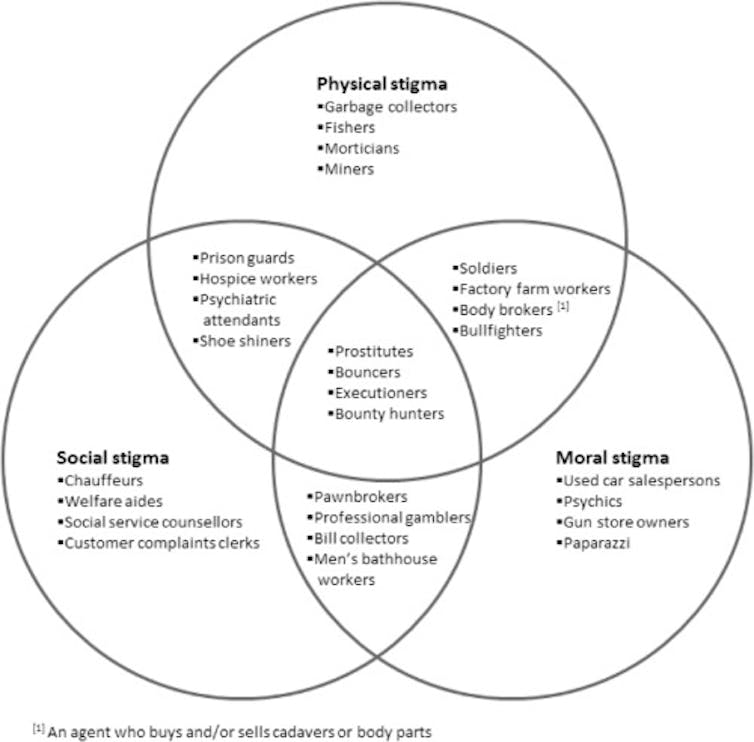
Our research shows that aged care work carries the burden of all three stigmas.
How Can Higher Wages Help?
Attracting more people to aged care work requires challenging all three of these stigmas. The question is to what extent higher wages can do this.
It’s generally the case that higher pay means higher occupational prestige.
Higher pay can’t reduce physical stigma, but it can compensate for it – just as high salaries compensate people willing to do mining work.
It can certainly help to diminish the social stigma, by signalling that society values this work more than it has done in the past. But the relatively small wage increase will not overcome the fact that society puts greater value on occupations that focus on “curing” rather than “caring”.
Higher pay may reduce the moral stigma, but only if other royal commission recommendations regarding better training and management are also implemented. The cases of abuse and neglect highlighted in media stories aren’t just about “bad apples”, but broader systemic issues such as staffing ratios and time allocated to direct care.
More fundamentally, the stigmatisation of aged care work reflects a structural deficiency of the economy, which fails to celebrate and remunerate caring work.
The federal government has taken a number of steps to address this, including giving the Fair Work Commission greater powers to address systemic low payment of female-dominated work, and expanding the potential for multi-enterprise enterprise bargaining.
But much more will need be done before all care work is valued the way it needs to be.![]()
Asmita Manchha, Research fellow, The University of Queensland
This article is republished from The Conversation under a Creative Commons license. Read the original article.
Reports Of Elder Abuse By Their Own Adult Children Increase In NSW
- 67 per cent of reports about abuse related to older women.
- Regional NSW accounted for just over half of reports, with the Hunter, Illawarra Shoalhaven, and Central Coast the most common areas.
- Adult children (29 per cent) and paid workers (28 per cent) were the main reporters.
Should The Pension Age Be Changed To 70?
Appointment Of New Secretary Of The Department Of Health And Aged Care
Sore joints now it’s getting cold? It’s tempting to be less active – but doing more could help you feel better

One in three Australians has a musculoskeletal condition involving joint pain, and the most common cause is arthritis. Around 3.6 million Australians have arthritis and this is projected to rise to 5.4 million by 2030.
For some people with joint pain, cold weather seems to make it worse. But temperature is just one factor impacting perceptions of greater pain during winter. Other factors include those we have some level of influence over, including sleep, behavioural patterns, mood and physical activity. Emerging research suggests greater pain levels in winter may also be related to a person’s perception of the weather, lack of vitamin D and fluctuations in their disease.
Physical activity is one of the best treatments to increase function, strength and mobility – and improve quality of life. It also promotes mental and physical health and reduces the risk of other chronic diseases.
But pain can be a barrier to exercise and activities you’d usually do. So what can you do about it?
Our Brain Tries To Protect Us
When it comes to pain, our brain is very protective: it’s like an inbuilt alarm system and can warn us about impending danger or harm that has occurred so we can respond.
But it’s not always a reliable indicator of actual damage or trauma to the skin, muscle or bone, even when it feels like it is. In some instances, this warning system can become unhelpful by setting off “false alarms”.
Joint pain and stiffness can also appear to worsen during colder weather, prompting fears we could make it worse if we undertake or overdo movement. This can result in people avoiding physical activity – even when it would be beneficial – which can worsen the pain.
We Tend To Exercise Less When It’s Cold
Seasons affect how much physical activity we get. Summer months bring warmer weather, longer daylight hours and people get outdoors more. Warmer weather also tends to elicit a positive outlook, a lift in mood and burst of physical activity to fulfil New Year’s resolutions.
Cooler months can mean a decline in physical activity and more time being cosy indoors. A reduction in movement and less exposure to light may evoke higher levels of joint pain and can be associated with a reduction in our overall sense of well-being and mood.
This can create a cycle where symptoms worsen over time.

But with the right knowledge and support, people can remain engaged in an active lifestyle especially when it’s aligned to personal values and goals. Health professionals such as physiotherapists and GPs can assess any concerns and provide strategies that are right for you.
How To Motivate Yourself To Stay Active In Winter
When looking for an approach to help you stay active during the cooler months and beyond, it can be helpful to become aware of the many interconnected factors that impact you. They include:
- biological (your genes, other illnesses you have)
- psychological (how you think, feel and behave)
- social (your relationships and social support).
Starting with the end goal in mind can be beneficial, but this can feel overwhelming. Try creating smaller, achievable steps to help get you there, like climbing a ladder. For example, park a short distance from the shops and increase this incrementally to increase your exercise tolerance.
A little bit each day can often be less tolling on your body than a big effort once a week.
Create goals that are personally meaningful and encourage you to celebrate success along the way (for example, catching up with friends or a healthy snack). Then, as you climb your “ladder”, one rung at a time, you will likely feel more motivated to continue.
If you’re not sure where to start, talk to a friend or health provider to help you determine what is realistic and right for your situation. That way you can work towards your goals in a safe, non-threatening environment and avoid developing fear and avoidance. They can also help you establish goals that align with your aspirations and pain experience.![]()
Charlotte Ganderton, Senior Lecturer (Physiotherapy), RMIT University; Inge Gnatt, Lecturer (Psychology), Provisional Psychologist, Swinburne University of Technology, and Matthew King, Lecturer, Research Fellow, and Physiotherapist, La Trobe University
This article is republished from The Conversation under a Creative Commons license. Read the original article.
Why does my back get so sore when I’m sick? The connection between immunity and pain

Have you ever wondered why your back aches when you’re down with the flu or a cold? Or COVID?
This discomfort, common during many illnesses, is not just a random symptom. It’s a result of complex interactions between your immune system and your brain called the “neuroimmune synapse”.
A fascinating and yet-to-be-understood consequence of this conversation between the immune and brain systems during sickness is that it is particularly noticeable in the lower back. This is thought to be one of the body’s most sensitive regions to neuroimmune threats.
Immunology Basics
Our immune system is a double-edged sword. Yes, it fights off infections for us – but it also makes us acutely aware of the job it is doing.
When our body detects an infection, our immune system releases molecules including signalling proteins called cytokines. These proteins coordinate our immune system to fight off the infection and talk to our brain and spinal cord to change our behaviour and physiology.
This can result in symptoms like fatigue, loss of appetite, fever and increased sensitivity to pain. Classically, we think of this as a beneficial behavioural change to help us conserve energy to fight off the infection. It’s why we often feel the need to rest and withdraw from our usual activities when we’re sick – and also why we are grumpier than usual.
Invisibly Small Changes
Part of this self-protective response is a change in how we perceive threats, including sensory stimuli.
When we are sick, touch can become painful and muscles can ache. Many changes in behaviour and sensory systems are believed to have origins at the nanoscale. When molecular changes occur in part of the brain linked to cognition or mood, we think and feel differently. If these neuroimmune synapse changes happen in the sensory processing regions of the brain and spinal cord, we feel more pain.
Such sensory changes, known as allodynia and hyperalgesia, can lead to heightened pain sensitivity, even in areas not directly affected by the infection – such as the lower back.

Immune Memories
This immune response happens with a range of bacterial infections and viruses like COVID or the flu. In fact, the sick feeling we sometimes get after a vaccination is the good work our immune system is doing to contribute to a protective immune memory.
Some of that immune-cellular conversation also alerts our brains that we are sick, or makes us think we are.
After some viral infections, the sick feeling persists longer than the virus. We are seeing a long-term response to COVID in some people, termed long COVID.
Women, who generally have a stronger immune response than men, may be more likely to experience pain symptoms. Their heightened immune response (while beneficial in resisting infections) also predisposes women to a higher risk of inflammatory conditions like autoimmune diseases.
When To Worry And What To Do
If the pain is severe, persistent, or accompanied by other concerning symptoms, seek medical attention. Mild to moderate pain is a common symptom during illness and we often notice this in the lower back. The good news is it usually subsides as the infection clears and the sickness resolves.
While treating the underlying infection is crucial, there are also ways to dial down sickness-induced neuroimmune pain.
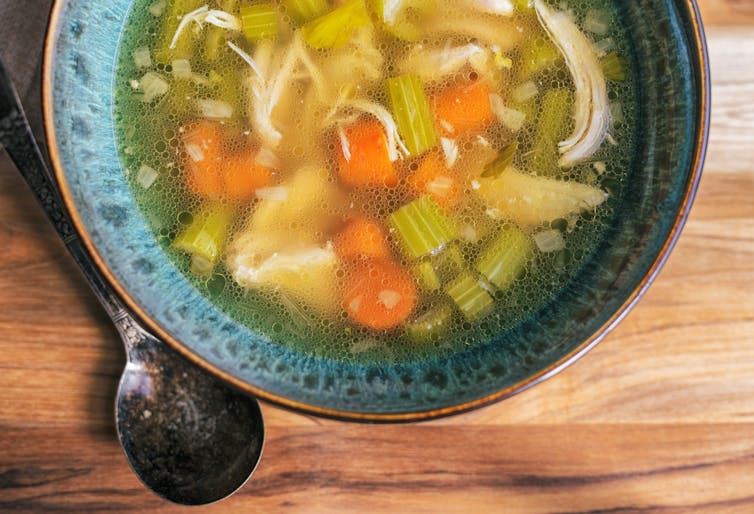
Maintaining a diverse microbiome (the collection of microorganisms living in and on your body) by eating well and getting outside can help. Getting quality sleep, staying hydrated and minimising inflammation helps too.
Amazingly, there is research suggesting your grandmother’s traditional chicken broth recipe decreases the immune signals at the neuroimmune synapse.
Scientists are also showing mindfulness meditation, cold water therapy and controlled breathing can drive profound cellular and molecular changes to help activate bodily systems like the autonomic nervous system and alter the immune response. These practices might not only help manage pain but also add an anti-inflammatory component to the immune response, reducing the severity and duration of sickness.
Heat treatment (with a pack or hot water bottle) might provide some relief due to increased circulation. Over-the-counter pain relief maybe also be helpful but seek advice if you are taking other medications.
All In The Mind?
Is this all mind over matter? A little of yes and a lot of no.
The little of yes comes from research supporting the idea that if you expect your breathing, meditation and cold bath therapy to work, it may well make a difference at the cellular and molecular level.
But by understanding the mechanisms of back pain during illness and by using some simple strategies, there is hope to manage this pain effectively. Always remember to seek medical help if your symptoms are severe or persist longer than expected. Your health and comfort are paramount.![]()
Joshua Pate, Senior Lecturer in Physiotherapy, University of Technology Sydney and Mark Hutchinson, Professor, University of Adelaide
This article is republished from The Conversation under a Creative Commons license. Read the original article.
TAFE NSW Graduate - Local Female Tradie Awarded Apprentice Of The Year + Student Of The Year

June 14 2023
TAFE NSW graduate and local Leila de Young has been named Apprentice of the Year and Student of the Year at the TAFE NSW Excellence Awards.
The 22-year-old Freshwater local completed her Certificate III in Electrotechnology at TAFE NSW Northern Beaches in 2018, while undertaking an apprenticeship as part of her HSC.
She chose a vocational qualification as an alternative pathway to university after having a chat with her dad, who is in the construction industry.
“I had no idea what career path I wanted to follow and couldn’t see the logic in choosing an expensive degree that I was not 100% sure I would stick with.
“The course runs for three years, with a mix of theory and practical units covering all essential electrical concepts, such as complex wiring rules calculations, testing electrical installations to ensure compliance, and workplace safety.
“A couple of integral conversations I had with both my father, a builder, and an electrician at a high school careers expo, introduced me to the construction world and I realised that there were other options apart from the traditional university route,” Ms de Young said.
She worked as an apprentice for Dvine Smart Homes, headquartered in Curl Curl for over two years and believes the company was integral to “exemplifying her confidence and abilities.”
“I started my apprenticeship two weeks out of high school and attained a nationally recognised trade qualification at the age of 21.
“They nurtured me at every stage of my learning and never made me feel silly if I had questions,” Ms de Young said.
According to data uncovered in The Productivity Commission White Paper released in 2021, women make-up only 2% of qualified trade workers. Nationwide, there is a massive demand in industries such as building, and construction, and women are an untapped market.
To encourage women to get into trades, the NSW Government launched the Women in Trades program which is aimed at tackling skills shortages in trades areas and offers women employment security in high demand industries. For Ms de Young, studying at TAFE NSW has enabled her to be highly employable in an essential, booming industry.
“This qualification will keep me highly employable for the rest of my working life in a forever-growing, essential industry with endless room for growth,” Ms de Young said.
This year, Ms de Young decided to further explore the design-oriented aspect of the profession and has now been accepted into Sydney University’s Architecture degree. Due to her passion firmly rooted in construction, she continues to be a strong advocate for the value of vocational training.
“I have grown into a confident, practical, independent young woman as a result of studying this [TAFE NSW Certificate III in Electrotechnology] qualification.
“I do not regret my decision to undertake an electrical apprenticeship for an instant and am forever grateful to my teachers, employers, and colleagues for helping me to achieve what I have,” Ms de Young said.

NSW Health Mental Health Youth Advisory Group: Members Wanted - Paid Opportunity
NSW Health is establishing its first Mental Health Youth Advisory Group to give young people a say on child and youth mental services and help shape its work.
NSW Health want to hear from a diverse range of voices aged 16 – 24 years old who live in NSW, particularly if they have lived experience of mental health issues and feel passionate about improving the mental health and wellbeing of young people.
People are especially encouraged to apply if they are an Aboriginal young person, live with a disability or identify as LGBTIQA+.
To apply to be a part of the Advisory Group please complete the online application form.
What is the NSW Health – Mental Health Youth Advisory Group?
The NSW Health – Mental Health Youth Advisory Group will play an important role in advising NSW Health on the real-life experiences of young people living with mental health issues.
The Advisory Group is a paid opportunity for 12 diverse young people aged 16 – 24 across NSW.
We're looking for young people who have a lived experience of mental health issues and a strong interest in improving the mental health and wellbeing of young people.
The 12 member Advisory Group will provide a direct avenue of communication between young people and NSW Health on issues that are relevant to young people accessing child and youth mental health services across the state.
The Advisory Group will meet at least six times throughout the year with a mix of in-person and online meetings. In-person meetings will be held in Sydney and we will support you with travel if needed.
Who is eligible to apply for the Mental Health Youth Advisory Group?
Young people aged between 16 – 24 years of age living in NSW;
- With a lived experience of mental health issues OR
- Have struggled with social or emotional wellbeing OR
- Have accessed any child and youth Mental Health Services
About you:
- Passionate about improving mental health outcomes for young people
- Prepared to contribute to meeting discussions and communications
- Can relate, identify and connect with youth/peers
- Enjoy working in a team
- Capable of working with culturally and diverse groups
- Adhere to NSW Health values of Collaboration, Openness, Respect and Empowerment
Key dates
- 13th June 2023 – Applications Open
- 16th July 2023 – Applications Close
- Mid-July 2023 shortlisted and unsuccessful applicants notified
- 9th August 2023 – online recruitment event for shortlisted applicants. This is mandatory for all shortlisted applicants
- Late August 2023 – successful applicants from online recruitment event notified
- Early September 2023 – Unsuccessful round 1 applicants notified
- 15th & 16th September 2023 – First face to face meeting
Applications close Sunday 16th July 2023.
If you need any assistance with completing the application, please phone Josephine Ivancsik on (02) 9859 5236 or email MOH-MHYAG@health.nsw.gov.au

The STAEDTLER Secondary School Artists Of The Year Competition Is Back!
Open to all year 7 to 12 students, it’s a chance for all up and coming artists to share their work for the opportunity to win 1 of 11 prizes. Entries close 20th June.
With the help of our panel of 3 talented judges, we are searching for the STAEDTLER Senior (years 10-12) and Junior (years 7-9) Artist of the Year 2023.
Both first place winners will receive a $1,000 VISA gift card!
For more information on prizes, please click here.
How to enter
Create
Using your favourite STAEDTLER products, show us your creativity and produce a masterpiece you’d like to submit.
You can get your inspiration from anywhere; a favourite place, a person, animal or school art project – we can’t wait to see your work of art!
Enter
Upload a photo of your artwork here and follow the prompts. If you are a Teacher, you can enter for your students and upload multiple entries at once. You will need to include artwork title, your name, school and year group.
Please ensure we can see the surface the artwork has been produced on eg. canvas or paper.
Note: digitally created or digitally enhanced artwork will not be accepted.
Win
Entries close on Tuesday 20th June and the judging and voting will then take pace.
You can vote for the People’s Choice Award from 21st -28th June – just come back to this page.
Winners will be announced 7th July.
Enter here: https://au.competitions.staedtler.com/

Applications Open For 150 Apprentice Scholarships
 Apprentices facing financial or personal hardship will be supported to undertake their trade and study through a $2.25 million NSW Government scholarship program.
Apprentices facing financial or personal hardship will be supported to undertake their trade and study through a $2.25 million NSW Government scholarship program.
Applications are now open until 21 July for the 2023 Bert Evans Apprentice Scholarships program that will support 150 people with $15,000 each to complete their training and further their career.
The scholarships support apprentices who are experiencing financial or personal hardship, demonstrate a high aptitude for vocational education and training, and are committed to their on- and off-the-job training in metropolitan and regional NSW.
The scholarship program is named in honour of the late Bert Evans AO, a passionate advocate of vocational education for more than 30 years. A total of 751 Bert Evans Apprentice Scholarships have been awarded since 2014.
These scholarships greatly assist first year apprentices to undertake their trade and study to achieve their career goals.
The NSW Government-run program offers grants of $5000 annually over 3 years to help people overcome personal barriers to finish their apprenticeships and go onto rewarding careers.
The scholarships are awarded to apprentices in NSW who have demonstrated:
- financial hardship and/or personal hardship
- capability for vocational education and training, and
- a positive attitude and application in the workplace and in off-the-job training.
Minister for Skills, TAFE and Tertiary Education Tim Crakanthorp said, “With demand for vocational education high, this year we have increased the number of Bert Evans scholarships on offer to help more apprentices through their training.
“Whether you need to purchase new tools, cover fuel or car maintenance costs, or pay for additional training courses, these scholarships have helped people overcome personal barriers to finish their apprenticeships and go onto rewarding careers.
“Apprenticeships are vital in ensuring NSW has a pipeline of skilled workers, and we want to give our apprentices a helping hand to complete their training, so they can make a strong contribution in their jobs and in the lives of their families and communities.”
Visit Bert Evans Apprentice Scholarships or phone 13 28 11 for more information and to apply.
Dorothea Mackellar Poetry Awards 2023: Optional Theme This Year 'The Winding Road'
HOW TO ENTER: https://dorothea.com.au/how-to-enter/
PLEASE SEE HERE FOR A DETAILED PDF ON ENTRY INSTRUCTIONS FOR TEACHERS AND PARENTS.
ONLINE SUBMISSION
Primary school and secondary school entries can be submitted anytime during the competition period.
1. Teacher/parent register account online *If you have already created an account, skip to step 3 and log in*
2. Check email for link to verify account and create password
3. Log in to your account
4. Purchase tier of entries *Please note we’re only able to accept credit card payments at this time*
5. Enter student details and submit poem(s) (cut and paste or type in poem content direct to the webpage)
6. Repeat step 5 for every student/individual poem.
*PLEASE NOTE: If you’re registering as an individual student, put your HOME address in your personal details and not your SCHOOL’S address! The address you list is where your participation certificate will be posted!*
Please read our Conditions of Entry here before registering for the competition.
USEFUL TIPS
Have a read of the judges’ reports from the previous year. They contain some very helpful advice for teachers and parents alike!
It is recommended for schools to appoint a coordinator for the competition.
Only a teacher/parent can complete the registration form on behalf of the student/child.
Log-in details: username is the email address and a password of your choice.
Log-in details can be given to other teachers/students for poem submission in class/at home.
Log-in as many times as necessary during the competition period.
Teachers can view progress by monitoring the number and content of entries.
Individual entries are accepted if the school is not participating or a child is home schooled. Parent needs to complete the registration form with their contact details. Please indicate ‘individual entry’ under school name and home postal address under school address.
Invoice for the entry fee will be sent to the registered email address within 2 weeks.
‘Participation certificate only’ option available for schools where pre-selection of entries has been carried out. Poems under this option will not be sent to judges, students will still receive participation certificate for their efforts.
Please read the Conditions of Entry before entering. Entries accepted: March 1 to June 30, results announced during early September.
NEED SOME INSPIRATION?
Check out our learning resources or browse the previous years’ themes and winning entries.
For more information contact our Project Officer on 02 6742 1200 or email dorothea.mackellar@outlook.com.
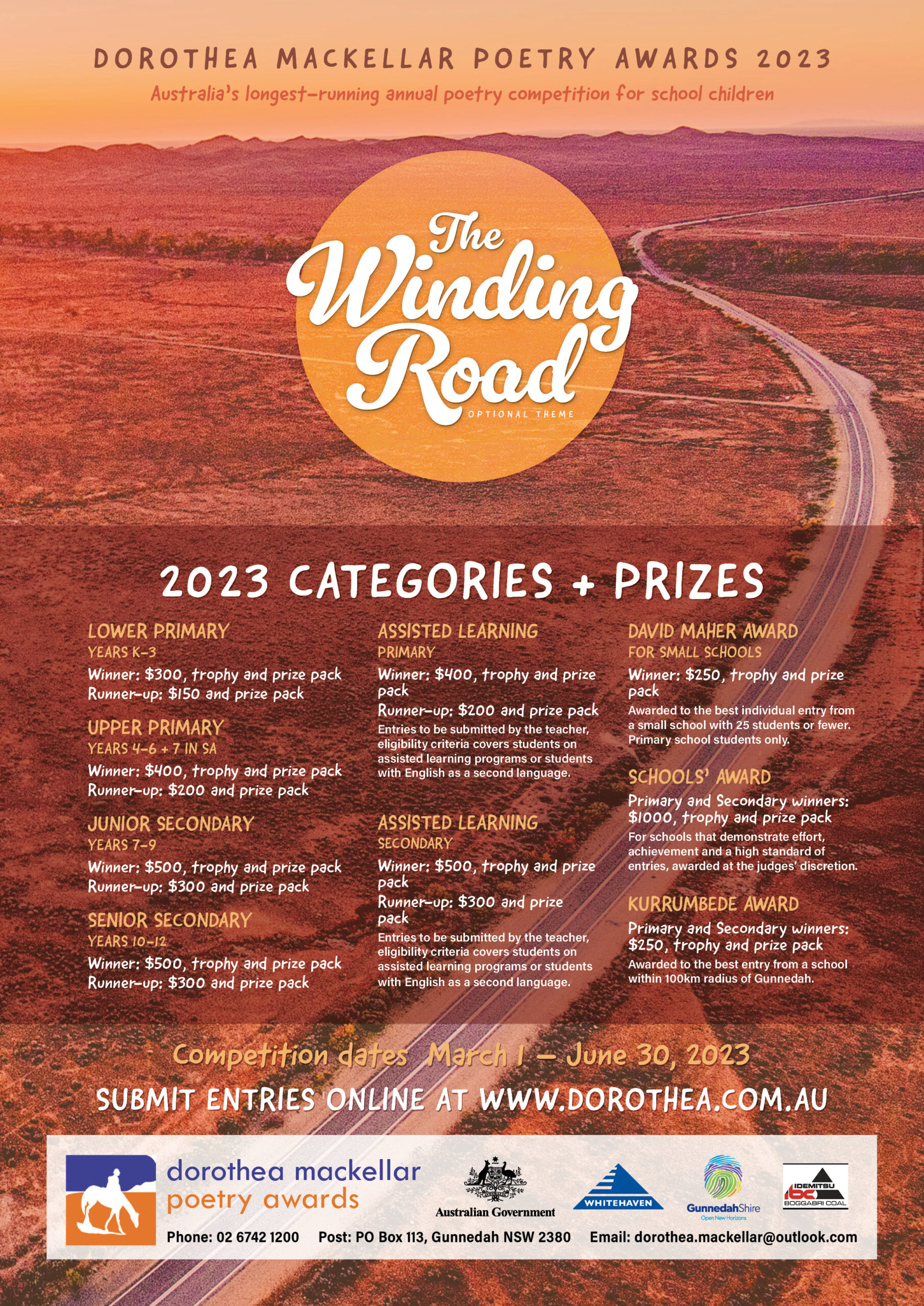
Young Hands
by NFSA
From The Film Australia Collection. Made by the National Film Board in 1954. Directed by William H. Shepherd. A dramatised story which illustrates the activities of Junior Farmers Clubs in Australia where young people interested in farming learn new methods and solutions to agricultural problems.
School Leavers Support
- Download or explore the SLIK here to help guide Your Career.
- School Leavers Information Kit (PDF 5.2MB).
- School Leavers Information Kit (DOCX 0.9MB).
- The SLIK has also been translated into additional languages.
- Download our information booklets if you are rural, regional and remote, Aboriginal or Torres Strait Islander, or living with disability.
- Support for Regional, Rural and Remote School Leavers (PDF 2MB).
- Support for Regional, Rural and Remote School Leavers (DOCX 0.9MB).
- Support for Aboriginal and/or Torres Strait Islander School Leavers (PDF 2MB).
- Support for Aboriginal and/or Torres Strait Islander School Leavers (DOCX 1.1MB).
- Support for School Leavers with Disability (PDF 2MB).
- Support for School Leavers with Disability (DOCX 0.9MB).
- Download the Parents and Guardian’s Guide for School Leavers, which summarises the resources and information available to help you explore all the education, training, and work options available to your young person.
School Leavers Information Service
- navigate the School Leavers Information Kit (SLIK),
- access and use the Your Career website and tools; and
- find relevant support services if needed.
Word Of The Week: Illuminate
verb
1. make (something) visible or bright by shining light on it; light up. 2. help to clarify or explain. 3. decorate (a page or letter in a manuscript) by hand with gold, silver, or coloured designs - an illuminated manuscript.
From Middle English illuminaten, borrowed from Latin illūminātum, supine of illūminō (“lighten, light up, show off”), from in + lūminō (“light up”), from lūmen (“light”). Cognate with Old English lȳman (“to glow, shine”) - From Middle English lemen, from Old English lȳman, from Proto-West Germanic *liuhmijan, from Proto-Indo-European *lewk- (“light, bright”)..
From c. 1500, "to light up, shine on," a back-formation from illumination or else from Latin illuminatus, past participle of illuminare "light up, make light, illuminate." Earlier was enlumyen (late 14c.) "decorate written material by hand with gold, silver, or bright colours," from Old French enluminer, from Late Latin inluminare; also illumine (late 14c.).
noun
From late 14c., "spiritual enlightenment," from Late Latin illuminationem (nominative illuminatio), noun of action from past participle stem of Latin illuminare "to throw into light, make bright, light up;" figuratively, in rhetoric, "to set off, illustrate," from assimilated form of in- "in, into" (from PIE root *en "in") + lumen (genitive luminis) "light," from suffixed form of PIE root *leuk- "light, brightness." Meaning "action of lighting" in English is from 1560s; sense of "intellectual enlightenment" is from 1630s.
illumine (v.)
late 14c., "to enlighten spiritually;" mid-15c., "to light up, shine light on," from Old French illuminer (13c.), from Latin illuminare "make bright, light up" . Related: illumined.
luminate (v.)
"to light up, illuminate," 1620s (obsolete), from *luminatus, past participle of Late Latin luminare "to shine," from Latin lumen (genitive luminis) "light," from suffixed form of root *leuk- "light, brightness."
An illuminated manuscript is a formally prepared document where the text is decorated with flourishes such as borders and miniature illustrations. Often used in the Roman Catholic Church for prayers, liturgical services and psalms, the practice continued into secular texts from the 13th century onward and typically include proclamations, enrolled bills, laws, charters, inventories and deeds.
The earliest extant illuminated manuscripte come from the Kingdom of the Ostrogoths and the Eastern Roman Empire and date from between 400 and 600 CE. Examples include the Codex Argenteus and the Rossano Gospels, both of which are from the 6th century. The majority of extant manuscripts are from the Middle Ages, although many survive from the Renaissance, along with a very limited number from late antiquity. While Islamic manuscripts can also be called illuminated and use essentially the same techniques, comparable Far Eastern and Mesoamerican works are described as painted.
Most medieval manuscripts, illuminated or not, were written on parchment or vellum. These pages were then bound into books, called codices (singular: codex). A very few illuminated fragments also survive on papyrus. Books ranged in size from ones smaller than a modern paperback, such as the pocket gospel, to very large ones such as choirbooks for choirs to sing from, and "Atlantic" bibles, requiring more than one person to lift them.
Paper manuscripts appeared during the Late Middle Ages. Very early printed books left spaces for red text, known as rubrics, miniature illustrations and illuminated initials, all of which would have been added later by hand. Drawings in the margins (known as marginalia) would also allow scribes to add their own notes, diagrams, translations, and even comic flourishes.
The introduction of printing rapidly led to the decline of illumination. Illuminated manuscripts continued to be produced in the early 16th century but in much smaller numbers, mostly for the very wealthy. They are among the most common items to survive from the Middle Ages; many thousands survive. They are also the best surviving specimens of medieval painting, and the best preserved.

Miniature of the book’s author, Vincent of Beauvais, within a border containing the arms of Edward IV, to whom this manuscript belonged. Miroir historial, vol. 1 (Vincent of Beauvais, Speculum historiale, trans. into French by Jean de Vignay), Bruges, c. 1478-1480, Royal 14 E. i, vol. 1, f. 3r
How cricket helped Windrush arrivals build a sense of ‘home’ in Britain
Michael Collins, UCLCricket was played extensively in Britain in the 1950s, in towns, villages and cities, both in workplaces and as a social activity. And the sport had also become a ubiquitous cultural pastime in the English-speaking Caribbean.
Indeed, cricket was a key part of Britain’s cultural imperialism, with the game helping to convey ideas about social order – in the colonial Caribbean, cricket clubs were segregated on the basis both of class and “race”. An emphasis on respecting the rules, “fair play” and sporting behaviour all enhanced this sense of white English prestige.
After the second world war, racism forced many new Windrush arrivals – predominantly black Caribbean men looking for employment in manual jobs – to set up their own cricket clubs. One such club is the still-active Carnegie CC, created in 1955 to cater for Caribbean cricketers in and around the Brixton area.

This article is part of our Windrush 75 series, which marks the 75th anniversary of the HMT Empire Windrush arriving in Britain. The stories in this series explore the history and impact of the hundreds of passengers who disembarked to help rebuild after the second world war.
For the Windrush generation, the sport held a particular importance, as my forthcoming book, Windrush Cricket: Caribbean Migration and The Remaking of Post-War England documents. Speaking of cricket in his 1963 memoir Beyond a Boundary, the great Trinidadian writer C.L.R. James claimed that:
There is a whole generation of us, and perhaps two generations, who have been formed by it not only in social attitudes but in our most intimate personal lives, in fact there more than anywhere else.
Despite widespread racism, some Caribbean cricket celebrities were feted by and ultimately found favour with the political establishment. Learie Constantine, for example, became the first black person to sit in the House of Lords in 1969.
Cricketers such as Bertie Clarke, who had played for the West Indies before the war, were integral to glamorous social networks of cricket at the BBC. There, he worked with Una Marson (the radio host and first black woman hired by the BBC) and other new arrivals from the Caribbean on the London Calling radio programme.
By the late 1960s and into the 1970s, there was a rich ecosystem of Caribbean cricket across Britain. Black cricket clubs were widely formed across English cities, starting with Leeds Caribbean (set up in 1948) and swiftly followed by others such as Sheffield Caribbeans, Bristol West Indians and the West Indian Cricket and Sports Club in Manchester.
The clubs and competitions were created by black people themselves, and were a significant bridge between England and “home” in the Caribbean – making cricket an important part of the black Atlantic cultural exchange.
London Transport And Cricket
London Transport was a major employer in post-war London, and often emphasised sport and recreation facilities in its recruitment materials. Pamphlets circulated in Barbados informed prospective applicants that, alongside their day jobs on the buses and London Underground, migrant workers would have ample opportunity to play cricket in the capital. By the later 1950s, London Transport had become a big focus for the development of Caribbean cricket in England.
Some of those who arrived saw themselves as temporary visitors, yet travelled back to the Caribbean to play cricket as Londoners. One example is the highly successful Central Road Services (CRS) team, named after a bus garage in south London.
According to Chris Hope, a bus conductor recruited in Barbados:
Most Barbadians were into cricket and Central Road Services cricket team had three or four venues such as Langley Park and Osterley. That’s how we passed our time … The Caribbean islanders used to mix and you were glad to see other black people, to be honest.
In 1975, the CRS team jetted back to Barbados for a cricket tour in an example of the trajectories of migration and return which created layers of identity and belonging for this generation. For many, the idea of home would shift according to context, and cricket could provide a cultural and social link between their two worlds.
Lorenzo Daniels, another bus conductor recruited in Barbados, recalled:
I came over so young and settled down here. I made this my life. This is my home. Barbados is the place where I was born.
Through self-organisation and sheer hard work, some of them, such as Devon Malcolm, Phillip DeFreitas and David Lawrence, rose to represent the England national cricket team. However, their successes frequently provoked a racist backlash, which pointed to deep faultlines opening up in terms of what it meant to be English in a postcolonial world.
Other Windrush cricket-lovers worked at the community level, providing opportunities for young people and spaces for black Caribbean people across generations to interact with each other, in ways that paralleled and intersected with the church and social clubs.
Part of a story of black British history that goes far beyond protest, policing and “resistance”, this remarkable generation of Windrush cricketers were pioneers of community building in England. In so doing, they helped transform what it means to be British.![]()
Michael Collins, Associate Professor of Modern and Contemporary British History, UCL
This article is republished from The Conversation under a Creative Commons license. Read the original article.
Cranogwen: statue unveiled for pioneering Welsh sailor, poet and gender equality campaigner
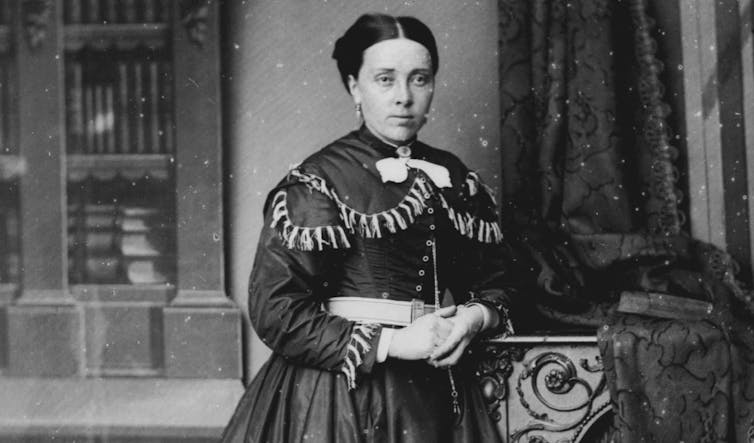
You can read this article in Welsh.
A statue has been unveiled in the small seaside village of Llangrannog in Ceredigion, to honour a pioneer in the development of gender equality in Wales. It pays tribute to Cranogwen, the bardic name of Sarah Jane Rees (1839-1916).
Sarah was a sea-captain’s daughter, who followed various careers, as a sailor, teacher, poet, lecturer, journal editor, preacher and temperance movement leader.
She rose to sudden fame in September 1865, when she won a National Eisteddfod prize for which the most highly-esteemed Welsh language bards of the age, Islwyn and Ceiriog, had also competed. The audience’s shock was immense: no one had expected a woman to emerge as winner, understandably enough as most of Ceredigion’s women were still illiterate at this time, signing their marriage certificates with a cross.
But well before 1865 her life had already followed different paths from those expected of women in her era. Sarah was born in Dolgoy-fach, a cottage high up on the hillside above Llangrannog’s shore. As soon as she was in her teens, she was required to start contributing to the family’s income: the choice was domestic service or needlework. She was apprenticed to a needlewoman in the nearby town of Cardigan, but returned home after a few months announcing her utter distaste for that work.
Instead she persuaded her father to take her on board his two-masted ketch, the Betsy, as a crew member. So started her three year stint as a sailor, at that time an unusual occupation for a woman. But with that experience, she was enabled in 1860, at 21 years of age, to take up the schoolteacher’s post at Llangrannog, teaching young sailors as well as the local children.
Her triumph on the national stage changed her prospects: it made her an instant celebrity. The whole of Wales wanted to see and hear the young woman who had beaten Islwyn and Ceiriog at their own game.
The mid-19th century was the age of the public lecture, particularly among the Welsh Nonconformists. If a chapel managed to secure the services of a popular lecturer, they could make a substantial profit from the ticket price, a sum often much needed to pay off chapel building debts. Cranogwen, as she became known, was persuaded, against her initial inclination because it meant giving up her hard-won teaching post, to become a public lecturer.

She started on her lecture tours in the winter of 1865. In packed chapels up and down the country she addressed congregations who had never previously seen a woman in the pulpit or the deacons’ pew. Between 1869 and 1871, she visited the United States and lectured to every emigrant Welsh-speaking settlement across the continent, from New York to San Francisco.
Unfortunately, Cranogwen never published her lectures, but according to the many descriptions of them in the contemporary press, they focused on the need for all those among her audience who aspired to live fully to recognise their own abilities, to cultivate them through acquiring education, and then to put them to work for the benefit of their communities. Only thus could they hope to find true happiness and fulfilment. And this message was for girls as much as boys, for women as well as men.
It was a message she went on to repeat in her new role, after her return to Wales, as the first Welsh woman to become a journal editor. In each of her careers Cranogwen challenged her era’s narrow conception of gender roles which confined women to the domestic sphere. Her primary aim was always to take other women with her, “out of their caves”, as she puts it, and into the public world as writers, speakers and leaders.
She considered the patriarchal system’s refusal to allow women access to professional roles a lamentable waste of female talents and abilities. As editor of Y Frythones journal, she disseminated these ideas widely, particularly in her responses to readers’ queries in her Questions and Answers column.
“Gender difference”, she says, “is nothing”. She saw the gender system of her mid-Victorian era as a man-made fabrication, which had no grounding in any real difference between the two categories male/female in terms of their intellectual, cultural and professional potential.
Her influence was profound. Sir O. M. Edwards, a leading figure in Welsh fin-de-siècle culture, said of her in 1916:
“Cranogwen had a mission and a noble aim. And she succeeded. No woman in our history to date has done as much to increase the intellectual confidence, the self-respect and the usefulness of the women of Wales as Cranogwen.”
It is indeed fitting that a statue be raised in her honour. It is part of a wider campaign - Monumental Welsh Women - dedicated to marking the contribution of women to the history of Wales. The statue, by sculptor Sebastien Boyesen, stands in the village in which Cranogwen lived throughout her life, first with her parents and subsequently, after their death, with her partner Jane Thomas.![]()
Jane Aaron, Emeritus professor of English, University of South Wales
This article is republished from The Conversation under a Creative Commons license. Read the original article.
How we collaborated in creating The First Inventors to celebrate extraordinary Indigenous peoples’ knowledges and technologies
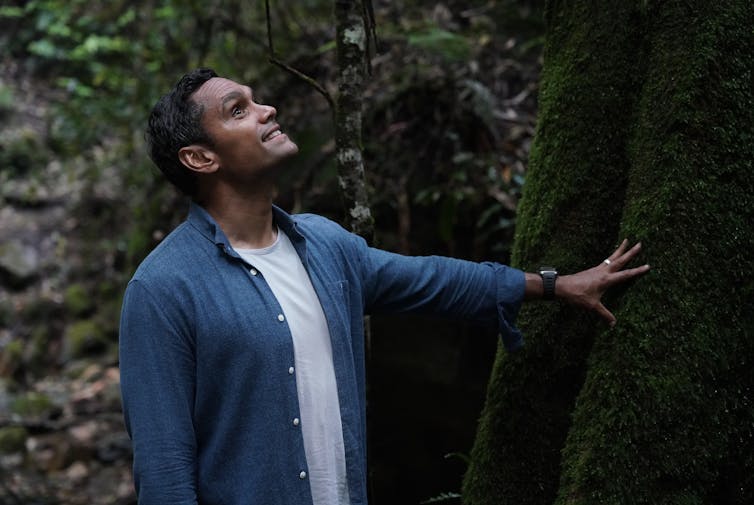
First Nations cultures and languages are being revitalised around the country. More non-Indigenous Australians are becoming interested in what Indigenous knowledges can teach us today.
The First Inventors is a new documentary series bringing Indigenous knowledges and technologies from communities across the continent to audiences. The series premieres on NITV and Network 10 on Thursday 15 June.
The three of us became involved in The First Inventors in early 2020 (Behrendt as a writer and then director; Ulm as deputy director and McNiven as a chief investigator of the Australian Research Council Centre of Excellence for Australian Biodiversity and Heritage, the principal research partner for the series).
The series follows story lines across the continent and across the skies. It explores how people transformed the continent through management and story. It covers navigation, aeronautics, kinship, memory, trade, communication and much more.
Historically, First Nations peoples in Australia have been falsely represented as simple, uninventive, and isolated. This view has been thoroughly discredited by decades of partnership research between First Nations peoples and non-Indigenous researchers.
There are many ways Indigenous and Western ways of knowing can work together collaboratively and respectfully to better understand Australia’s past and future needs.
Indigenous Technologies And Knowledges
Aboriginal and Torres Strait Islander peoples have diverse knowledges, languages, social systems, technologies, cultures and histories spanning over more than 65,000 years.
This includes the exploration of practices such as using fire technologies to maintain open grasslands to increase animal stocks in northern Tasmania and digging canals and constructing weirs across lava fields to farm eels in southwest Victoria.
There have also been new archaeological discoveries of pottery made on Jiigurru (Lizard Island) in north Queensland which reveals connections between First Nations peoples and New Guinea Melanesians for at least 2,000-3,000 years.
Such revelations are not new to Torres Strait Islanders who know their ancestors used huge ocean-going canoes to travel hundreds of kilometres to share objects and ideas between the mainlands of Australia and New Guinea long before James Cook arrived.
Some First Nations peoples are using traditional fire technologies to protect biodiversity and in carbon abatement programs, and using knowledge of the medicinal properties of plants to develop new health products.
Cultural flexibility, inventiveness, and adaptability saw First Nations people in Australia thrive through periods of major environmental change in the past. This includes an Ice Age that ended with flooding of 2 million square kilometres of the continental shelf. This required people to move hundreds of kilometres inland sometimes over only a few generations and adapt to entirely different environments.
The First Inventors
Much of the content of The First Inventors focuses on knowledges and sciences in Indigenous knowledge systems, so the content is very strongly cultural. Listening to First Nations voices brings forth great reservoirs of ancestral knowledge and experience.
The series provided a space and platform where Indigenous people reclaimed the storytelling authority for their own stories, histories, and perspectives.
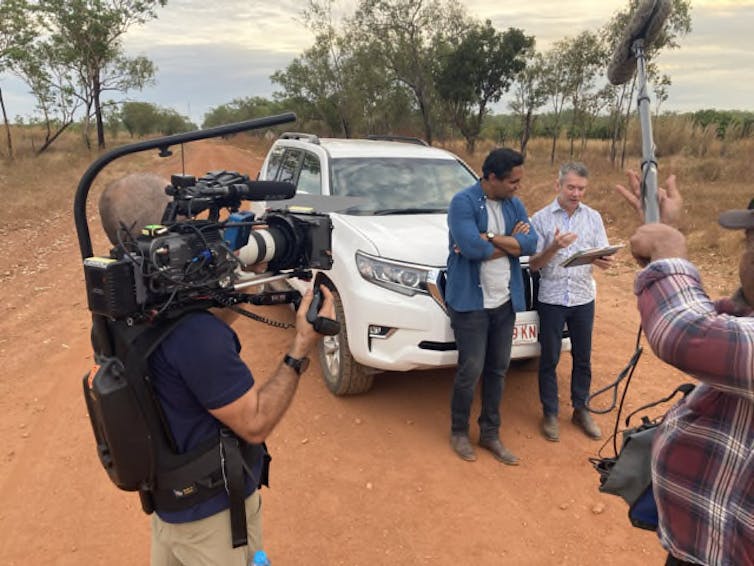
The series was a challenging project, because we had to produce content for two different audiences.
For a First Nations audience, it is a celebration of the resilience and wisdom of our cultures.
For a broader audience, it is a unique glimpse into the technology and science that sits in First Nations knowledge systems.
The themes of the series look toward the future, exploring how Indigenous knowledges are as relevant today as they have been in the past – and how they might help us navigate the future.
This project requires Australians to understand how sophisticated Aboriginal and Torres Strait Islander cultures are. This is crucial as Australia engages in big national conversations about voice, truth, and treaty.
The First Inventors tackles head on the importance of reconciliation and truth-telling. In breaking the shackles of our colonial past to reveal the extraordinary complexity, inventiveness and resilience of First Nations peoples in Australia.
The First Inventors premieres NITV and Network 10 on Thursday 15 June.![]()
Larissa Behrendt, Professor of Law and Director of Research, Jumbunna Indigenous House of Learning, University of Technology Sydney; Ian J. McNiven, Professor of Indigenous Archaeology, Monash University, and Sean Ulm, Director, ARC Centre of Excellence for Indigenous and Environmental Histories and Futures, James Cook University
This article is republished from The Conversation under a Creative Commons license. Read the original article.
Twitter is refusing to pay Google for cloud services. Here’s why it matters, and what the fallout could be for users

Amid an ongoing cost-cutting effort, Twitter has now refused to pay the bills to renew its multi-year contract with Google Cloud, Platformer has reported.
We’ve all heard of “the cloud” – but what does it have to do with Twitter? And more to the point, what will the consequences be for Twitter users if Google Cloud pulls the plug on the platform?
What Are Cloud Computing Services?
To put it simply, “the cloud” is an assembly of computing resources that are remotely accessible over the internet. These resources are leased out to internet-connected organisations so they don’t have to buy and maintain their own.
In Twitter’s case, these resources include storage space for very large quantities of data, as well as a suite of programs that perform various operations on these data, as agreed upon in the contract. All of this takes place across a global network of physical servers.
Cloud computing is a convenient and cost-effective business model, which has gained much favour from enterprises large and small.
Currently, a handful of players dominate this market. In the lead is Amazon Web Services (AWS) which holds about 32% of the market. Amazon became the first cloud provider in 2006 and has since established a comfortable lead over its rivals, Microsoft Azure (23%) and Google Cloud (10%).
Reliability and scalability are perhaps the most important requirements a company will have of its cloud service provider. And when it comes to reliability, “redundancy” is key.
Redundancy means that if one data centre goes down, there are multiple others with duplicate data that can seamlessly step into service. And if the quantity of user data is high in one particular data centre, the extra load can be farmed out to another. In this way, peak traffic periods can be managed without loss of performance.
What Might Happen If Google Pulls The Plug?
It seems Twitter is at loggerheads with its cloud provider, Google Cloud. The company is reportedly disputing its Google Cloud bill as it seeks to renegotiate its contract with Google.
The issue appears to be rooted in a disagreement over service quality and performance. Twitter doesn’t think it’s getting value for money, and is withholding the latest payment in its US$1 billion contract with Google Cloud.
Under the contract, Google Cloud hosts many of Twitter’s trust and safety services. If the disagreement isn’t resolved by the end of the month, and if Twitter severs ties with Google Cloud, this could seriously threaten its ability to fight spam, remove child sexual abuse material and generally protect accounts.
Google also currently allows Twitter users to sign up with their Google account. And Twitter profiles are highly ranked in Google searches, by virtue of Twitter’s close ties with Google. This favoured status could be in jeopardy if the two companies can’t come to terms.
Apart from Google Cloud, Twitter also has a multi-year cloud computing contract with AWS to offer a host of functions. According to reports, it has also withheld payments from Amazon in the past and owed some US$70 million in bills as of March. Amazon responded by threatening to withhold payments for advertising it runs on the platform.
Why Is Twitter Refusing To Pay?
The dispute can perhaps be understood as yet another attempt by Twitter to radically reduce operating costs. It’s a a trend that began late last year when Elon Musk acquired the company for US$44 billion.
Musk, who just appointed former NBC Universal advertising executive Linda Yaccarino as Twitter CEO, has implemented a suite of cost-cutting measures since the takeover – among these, the firing of more than half of the company’s 7,500 employees.
Looking at the big picture, we see Musk in the throes of trying to make Twitter a leaner, more efficient business.
Cracking Down On Malicious Misuse
At stake in this dispute are services that help keep Twitter free of malicious, dangerous and offensive content. Twitter’s battle against this content, as well as against spam and bots, has been ongoing. While it’s difficult to predict the outcome of the dispute with Google, it’s likely Twitter will take whatever course of action helps the company save money.
That could mean moving those services to a different provider, or retaining Google Cloud’s services but on more favourable terms. Another possibility (although less likely) is for Twitter to migrate those particular services in-house where it will have more control. But this would also require spending and human resources to manage the data.
In a worst-case scenario, Twitter may collapse or destabilise if certain elements within it go offline. Aside from Twitter trolls, this outcome would be in nobody’s best interest. So it’s more likely Twitter and Google Cloud will find a mutually agreeable way forward. ![]()
David Tuffley, Senior Lecturer in Applied Ethics & CyberSecurity, Griffith University
This article is republished from The Conversation under a Creative Commons license. Read the original article.
For the first time, astronomers have found life-supporting molecules called phosphates on Enceladus

The search for habitable conditions beyond Earth has just become more interesting with the discovery of biologically available phosphorus from one of Saturn’s moons. Phosphorus is the most elusive of the six crucial elements needed for life.
In research published today in Nature, data from the Cassini spacecraft were used to find phosphorus compounds called phosphates in Saturn’s E ring – one of the fainter outer rings of the planet.
These compounds likely came from the ice volcano (cryovolcano) plumes from the sub-surface liquid water ocean on Saturn’s moon Enceladus.
A Famous Moon
Enceladus seemed like a typical moon of Saturn until the Cassini spacecraft came to take a closer look. Arriving at Saturn in 2005, Cassini has been making discovery after discovery that have catapulted Enceladus to one of the top places to look for life beyond Earth.
In particular, we learned Enceladus has a liquid water ocean beneath its icy surface, heated by gravitational tidal forcing – the kind of forcing that produces ocean tides on Earth.

This environment is tantalisingly similar to the hydrothermal vents thought by some to be the place where life may have originated on Earth. Such vents certainly host life on Earth today.
Most life on Earth ultimately relies on photosynthesis – generating energy from sunlight. Meanwhile, the ultimate energy source for any life on Enceladus would be the gravity of Saturn producing tides far stronger than the Moon produces on Earth, allowing a liquid water ocean despite the very cold -200℃ ice crust surface.
Easy Sampling
The Enceladus plumes have been called a “gimme” for efforts to sample the oceans of alien worlds. One wouldn’t need to land to collect a sample, nor to then launch to return it for analysis.
An obvious approach to sampling an ice volcano is to simply fly through it. However, this is difficult because the speed at which a space probe would encounter the plume would likely kill most organics.
Instead, the easiest approach is to examine the accumulation of ejected material from Enceladus in Saturn’s E ring, which is what the team did in this latest study.
Using this approach, researchers have previously discovered complex organic molecules coming from Enceladus. These findings confirmed that the watery environment on Enceladus supports complex chemistry involving nitrogen and oxygen.
However, until now we didn’t know about the availability of phosphorus on Enceladus; in many environments this element is locked in rocks.
A Crucial Element
The discovery of phosphates in Saturn’s E ring suggests phosphates could be available within the oceans of Enceladus at a concentration 100 times higher than in Earth’s oceans.
Phosphorus is crucial for life as we know it, partly because it is a key building block of DNA and RNA, molecules essential to all life on Earth. Phosphate is also vital for a number of other metabolic processes in all life.
Many of the essential components necessary for the emergence of life as we know it have thus been discovered on Enceladus. This puts it at or near the top of lists of places to search for life beyond Earth in our Solar System.
Nevertheless, this discovery is only the start of the story. For phosphate to form bonds with carbon – this type of bond is found in the backbone of DNA – we need specialised chemistry that’s very dependent on the environment.
We’ll need further study of the chemistry in and under the crust of Enceladus. But a future detection of organic phosphate compounds would be particularly interesting for the potential for life in the moon’s oceans.
No ‘Smoking Gun’
This research is reminiscent of the reported detection of phosphine on Venus in September 2020, which was cast into doubt by later evidence.
However, the detection method is quite different. On Venus the presence of phosphine was proposed by observing the atmosphere from Earth. The phosphates in this study were detected using an instrument orbiting Saturn called a mass spectrometer, which measured the mass of individual compounds found in the ice of the E ring.
To verify the analysis, the authors created a water solution on Earth very similar to the predicted Enceladus ocean.
That said, both detection methods carry a risk of misidentification, where a different molecule that’s not phosphine is actually responsible for the result.
It would be great to have a “smoking gun” for life beyond Earth, but realistically it will instead be a trickle of evidence that grows as we discover more about these environments.
The study published today is one more piece of evidence supporting the fact that Enceladus may be a great location in our search for extraterrestrial life.
Acknowledgements: We thank Prof Steve Benner from The Foundation For Applied Molecular Evolution for his insight and contributions to this article.![]()
Laura McKemmish, Lecturer, UNSW Sydney; Albert Fahrenbach, Senior Lecturer, UNSW Sydney, and Martin Van Kranendonk, Professor and Director of the Australian Centre for Astrobiology, UNSW Sydney
This article is republished from The Conversation under a Creative Commons license. Read the original article.
Why more than two-thirds of Australians think no news is good news (at least some of the time)

Over the past 12 months, the news has been full of serious and negative news such as the war in the Ukraine, the surge in the cost of living, interest rate rises, and the climate crisis.
It’s not surprising, then, that more than two-thirds of Australians say they are actively avoiding news some of the time. What is surprising is that Australians avoid news more than consumers in many other countries.
The findings are contained in the latest Digital News Report: Australia 2023 released by the University of Canberra.
The online survey of 2,025 Australians finds 69% say they avoid the news, occasionally, sometimes or often. This is higher than the global average of 63%, which is slightly declining. It also marks a 12 percentage point increase in news avoidance among Australians since 2017.
Not only do we avoid news more in Australia than other countries, we also avoid different news topics. In the majority of countries surveyed, news avoiders are more likely to steer clear of news about the war in the Ukraine, especially people in European countries. In Australia, we are most likely to eschew news about social justice issues such as race and gender inequality and LGBTQ+ rights.
When it comes to avoiding social justice issues, there are strong differences based on people’s political orientation. Australian news avoiders who identify as right-wing are more than twice as likely to say they evade news about social justice issues (56%) than those who say they are left-wing (22%). This highlights the big challenge facing government and advocacy organisations seeking to promote the “yes” and “no” campaigns for the Voice referendum to a news audience that is polarised around particular issues.
There are also big differences in news topics they avoid between Australian men and women. Women are much more likely to avoid news about sport and politics, whereas men will more readily keep away from stories about social justice issues, climate change and culture.
Because women are more likely to get their news from social media platforms than men, they are also more likely to scroll past the news to avoid it; men are more likely to consciously cut news out at particular times of the day.
Women Are Turning Their Backs On News
These differences in avoidance behaviour point to a growing gender division in news consumption in Australia. Women are increasingly losing interest in news and consuming less of it, particularly Gen Z women. Over the past six years, the proportion of Australian women in our annual study who say they are very or highly interested in news has fallen 16 percentage points to 43%, compared to a much smaller drop – only 6 percentage points – among men.
Australian women are also among the lightest news consumers globally. Only 41% of Australian women say they access news more than once a day, compared to 59% of men. There are other indicators that point to the widening gender gap. Thirty-nine per cent of women say they trust the news most of the time, compared to 48% of men. The proportion of women paying for news is also declining.
The gendered decline in news interest and consumption this year can be partly explained by the types of stories that have dominated the news cycle, such as the war and federal politics, which women are less interested in than men.
Overall, the longitudinal decline among women points to be a much bigger issue facing the news industry that needs to be addressed if they want to stem the exodus of the female news audience.
But It’s Not All Bad News
Our Digital News Report for 2023 also finds:
- The proportion of Australians who pay for online news has increased to 22% (+4pp from 2022).
- More than half of Australians (56%) say they are interested in positive news stories, and 50% say they are interested in news that suggests solutions, report on the latest development, and investigates wrong-doing.
- 60% of Australians surveyed say public service media, such as the ABC and SBS is important to society, and 52% say it is important to their lives.
- More than one third of Australian’s surveyed said they were highly interested in politics (35%), a 3 percentage point increase from 2022.
- Trust in news has risen slightly to 43%, higher than the global average.
Digital News Report: Australia is produced by the News & Media Research Centre (N&MRC) at the University of Canberra and is part of a global annual survey of digital news consumption in 46 countries, commissioned by the Reuters Institute for the Study of Journalism at the University of Oxford. The survey was conducted by YouGov at the end of January/beginning of February 2023. The data are weighted for age, gender, and region. Education and political quotas were applied. In Australia, this is the ninth annual survey of its kind produced by the N&MRC.![]()
Caroline Fisher, Associate Professor of Communication, University of Canberra; Kieran McGuinness, Postdoctoral Fellow, News & Media Research Centre, University of Canberra, and Sora Park, Professor of Communication, News & Media Research Centre, University of Canberra
This article is republished from The Conversation under a Creative Commons license. Read the original article.
Rooting for the anti-hero: how fans turned Taylor Swift’s short relationship with Matty Healy into a political statement
Simone Driessen, Erasmus University Rotterdam and Annelot Prins, Freie Universität Berlin“It must be exhausting, always rooting for the anti-hero”, sings Taylor Swift on her latest album Midnights. Yet, the stadiums of her Eras super tour are filled with a crowd that feels anything but exhausted: social media overflows with footage of both Swift and her fans having a great time.
Until the Nashville shows. When the 1975’s lead singer, Matty Healy, attended all three concerts of the newly single Swift, her fans started to vocally worry that the two were dating.
Problematic Matty Healy
A romance between Swift and Healy felt unpalatable to many of her fans. Healy’s messy, amoral rock stardom, and frequent instances of public controversy, collided with Swift’s carefully crafted good girl image.
Swift’s fans took offence at what they believed was Healy’s sexist, racist and antisemitic behaviour. In an episode of The Adam Friedland Show podcast, for instance, Healy was recorded laughing along with racist jokes ridiculing rapper Ice Spice. On stage, he was seen doing what looked like an offhand Nazi salute while giving Kanye West a shout-out.
Healy perhaps assumes his fans understand him to be joking, but also does not seem to care much. If politics have become a joke – so Healy seems to think – you might as well joke about them. In the New Yorker, Jia Tolentino describes Healy as a post-woke celebrity, a persona switching between tenderness and trollishness.
His attitude irked Swift’s fans. Their rumoured relationship felt like a political oxymoron to them: how could a progressive, feminist celebrity like Swift fall for someone so problematic? Some fans accused Swift of performative activism: perhaps she, herself, had really not cared all along.
Social media filled with tweets from fans urging Swift to break up with Healy, followed by articles in Forbes, Rolling Stone, Buzzfeed and the Guardian, in which journalists, too, argued about Swift’s relationship with Healy.
In every iteration, their relationship was decidedly framed in political terms: by dating Healy, Swift condoned his hurtful statements and actions.
Breaking Her Silence
American celebrity has become an increasingly politicised institution in the last decade. When Donald Trump announced his run for the presidency in 2015, many celebrities opposed him. Swift stayed quiet at the time, which led to confusion about her political viewpoints. It facilitated the hijacking of Swift’s persona by the alt-right, who believed she had an “Aryan spirit”.
In 2018, Swift broke her silence and spoke out in support of progressive values. Swift’s statements were more explicit than the political flirtations of other celebrities: she named specific conservative politicians she opposed in a 2018 Instagram post, urging her audiences to not vote for them.
In an interview with Vogue from 2019, she said “rights are being stripped from basically everyone who isn’t a straight white cisgender male.”
The song You Need To Calm Down added a catchy sound to Swift’s newfound political voice. Through her politicisation, Swift gained new fans. Although not everybody believed her sudden change of heart, most applauded her for it.
Swift emphasised the importance of developing a political and social consciousness, potentially offering white women a blueprint out of political passivity and into action.
The Politics Of Cultural Consumption
When Swift’s audiences fight over the meaning of her stardom, and in extension debate the political values of her fandom, they are confronting the question of what a “good” pop star really looks like.
To those critical of Swift’s associations with Healy, this has to be a socially engaged, politically responsible celebrity who leads by example. The anti-Healy sentiment signals a craving for a star who legitimises rather than forecloses our desire for a better, more just and fair world.
Though celebrities can form an important source of joy, there are dangers in outsourcing our politics onto their individual, albeit, charming shoulders.
A framework in which Healy symbolises all things bad, with Swift personifying all things good, obstructs a more structural engagement with the issues at stake here. It falls into a trap of individualisation: presenting sexism, racism and antisemitism as individual character traits rather than historically anchored structures of violence.
In this narrative, getting rid of Healy would somehow allow Swift’s audiences to see Swift as whole again – as morally and politically pure, somehow not implicated in these structures of oppression Healy so carelessly embeds in his persona.
To focus solely on political evaluations of individual celebrities like Swift and Healy paves the way for a situation shaped by anti-politics, in which policymakers and political institutions get a free pass.
If individual celebrities are framed as the rotten apples causing moral and political chaos, it would mean that inequality and oppression could be solved by simply tossing those individuals out rather than focusing on the crucial need to fight misogyny, racism and antisemitism in structural, sustainable manners.
A month after the concerts in Nashville, Swift released a song with Ice Spice. On her Instagram and Twitter, she expressed her love for the young, talented rapper.
Not long after, Healy was seen kissing a security guard at his own concert. The internet let out a collective sigh of relief. Some fans celebrated the break-up as a victory; the fruit of their digital labor. Entertainment Weekly reported the two had come to realise they are not compatible. A day later, The Daily Mail wrote the two had actually never really dated.
But none of this seemed to matter much to those who had been arguing about the two for weeks now. Their relief and happiness about Swift being politically virtuous remained. Now that this issue had been resolved, the internet could finally go back to being a gathering place for uplifting concert videos from Swift’s Eras tour.![]()
Simone Driessen, Assistant Professor in Media & Popular Culture, Erasmus University Rotterdam and Annelot Prins, PhD candidate in American studies, Freie Universität Berlin
This article is republished from The Conversation under a Creative Commons license. Read the original article.
How Jurassic Park changed film-making and our view of dinosaurs
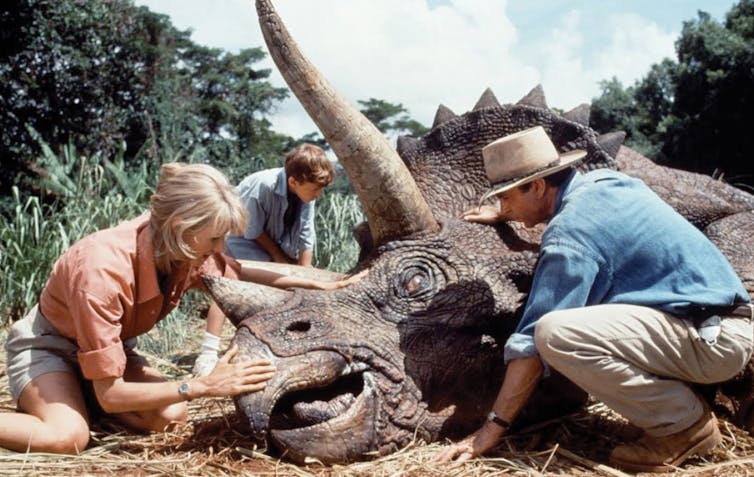
In June 1993, director Steven Spielberg released a film that unleashed a wave of technological change in film-making and simultaneously helped to revive popular interest in dinosaurs.
Jurassic Park, based on Michael Crichton’s novel, spawned five blockbuster sequels as well as a multitude of spin-off games, toys, novels, and multiple animated television shows. It features a theme park housing de-extincted dinosaurs that break out of their confines and cause havoc.
Underpinning the plot is clever genetic engineering that has allowed the Park’s scientists to assume they could control all aspects of the dinosaurs’ development, including their sex, much to their later horror when it becomes apparent such control was never possible.
The film franchise has taken an average of over $1 billion dollars at the box office, according to Variety.
From Puppets To CGI
According to industry legend and multiple documentaries, Spielberg had planned to use only practical effects, including stop-motion Velociraptors and an animatronic Tyrannosaurus Rex. However, well into the filming schedule, he was convinced to also include wholly digital dinosaurs after viewing test footage produced by staff at special effects house Industrial Light & Magic.
In a critical history of Industrial Light & Magic, Julie Turnock observes that the film “relied on a canny mix of large-scale mechanical effects cut together with a few digitally generated shots”. After its success, ILM embraced digital composition technology more fully and integrated it into many later films.
As it stands, Jurassic Park features about 50 shots of digital-only prehistoric creatures, including the first full-body scene of a dinosaur – the sauropod Brachiosaurus - flocking Gallimumus, and the T. rex chasing a Jeep.
Industrial Light & Magic now claims on their website that “Suddenly, directors could imagine making films in which realistic animals, fantasy creatures, even digital people could perform without restraint.”
Nowadays, films and television productions are replete with photoreal computer-generated animals and people and the next revolution in screen production has them projected live behind actors on a series of large screens known as “the volume”.
Palaeontologists Aren’t Extinct
Shortly after seeing their first dinosaur, on-screen palaeontologist Alan Grant (Sam Neill) suggests to his palaeobotanist partner Ellie Sattler (Laura Dern) that the de-extinction success of Jurassic Park might make their profession redundant. Their colleague Ian Malcolm (Jeff Goldblum) responds, “Don’t you mean extinct?”
But far from extinction, palaeontology and associated sciences have seen an extensive rebound in public interest in the thirty years since Jurassic Park was released.
In 1975, palaeontologist Robert Bakker popularised the term “dinosaur renaissance” to describe a spate of developing research findings which argued the creatures were endothermic (warm-blooded), active, and related to the birds rather than cold-blooded, slow and wholly extinct as had been the public perception for much of the previous century. This renaissance lasted from about the 1960s into the 1980s and Jurassic Park reflected many of these new orthodoxies.
Bakker himself consulted for the film and was referenced by the character Tim Murphy. A Bakker lookalike also appeared in the sequel The Lost World, further reinforcing its role in reflecting these new perspectives.
But the film also arrived at the dawn of yet another new age of dinosaur discoveries which Steve Brusatte, in his 2018 book The Rise and Fall of the Dinosaurs, described as “the golden age of discovery”. Brusatte referred to the cohort of scientists making these newer discoveries as “men and women from many backgrounds who came of age in the era of Jurassic Park.” Among their findings are new understandings that many dinosaurs were feathered like their modern avian cousins.
Elizabeth Jones recently chronicled the history of the field of “ancient DNA” science, noting the “Jurassic Park effect” playing out on this fascinating area of research:
Even as scientists rejected the conclusions or the implications of the Jurassic Park narrative, they drew on the popularity of the book and movie to emphasise the importance of the technical enterprise in which they were engaged.
And a recent review of the last 60 years of dinosaur research by celebrated palaeontologist Philip J. Currie suggested “public interest continues to be stimulated by a multibillion-dollar movie, media, and toy industry founded on our interest in dinosaurs.”
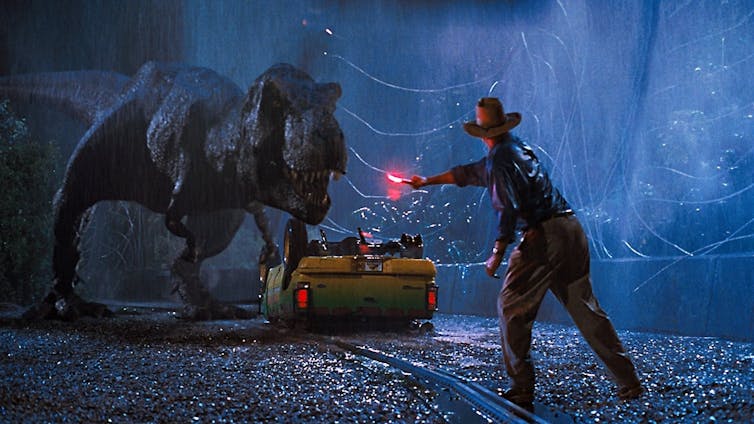
The Jurassic Park Legacy
Dinosaurs have long featured in popular media such as films and television. The first animated dinosaur, Gertie, debuted as part of a vaudeville performance in 1914. Dinosaurs, including a fearsome Tyrannosaurus featured in Disney’s groundbreaking and famed 1940 film Fantasia. But it was Jurassic Park which truly presented them as believable living creatures for the first time.
Though the science of the film has been widely criticised since its release, Jurassic Park succeeded in revolutionising film-making and reigniting a public fascination with dinosaurs even as palaeontology itself underwent a boom in new research efforts. In his recent memoir, actor Sam Neill described the film’s visuals as “a perfect collision of coming-of-age computer generated imagery… with state of the art puppetry”.
The sequels sequels and spin-offs have continued to adapt to changing social expectations, featuring strong female and queer characters, and even feathered dinosaurs in response to changing scientific understandings.
Perhaps the next Jurassic film will feature a full-lipped Tyrannosaurus?![]()
Travis Holland, Senior Lecturer in Communication, Charles Sturt University
This article is republished from The Conversation under a Creative Commons license. Read the original article.
‘When my thoughts would stray over the sea’: reading the 19th century diaries of girls migrating to Australia
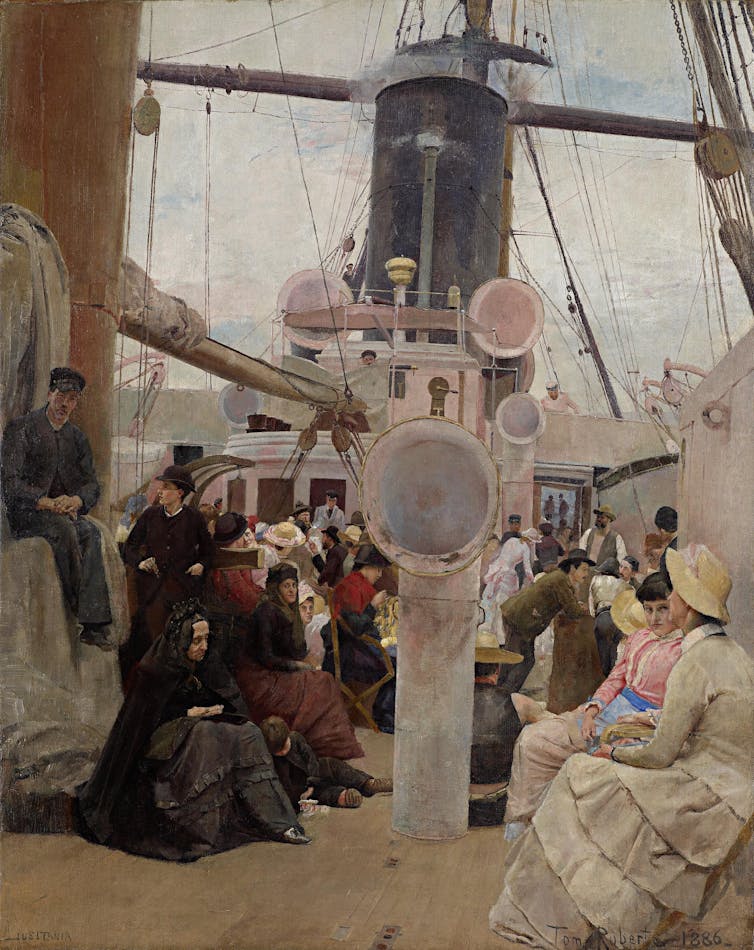
In the digital age our lives are constantly being recorded. Yet, the deliberate act of recording – what we want to remember and how we want to remember – remains popular. Diaries allow us to journal our thoughts and feelings, to work through the challenges we face every day.
This practice is older than you may think. As I write in my recent journal article, some British and Irish girls and young women who migrated to Australia in the mid-1800s used diaries to record their day-to-day lives, document their travel experiences and navigate their emotions.
In the 19th century, around 1.5 million people migrated to Australia, including large numbers of girls who were defined as under the age of 15, and young women in their late teens and early 20s.
Unless she was married, a girl had little other option than to accompany her family to the colonies.
Though few diaries from this demographic survive (I examine only 13 extant sources of about 850 known to survive), they divulge the intricate emotions of migration.
Today, a 24-hour flight from Britain to Australia feels like an eternity, but in the 19th century it took around three months to sail to the continent. Removed from the demands of everyday life, passengers had a lot of time on their hands. Some wrote journals to while away the long days.

A Difficult Experience
Migration could be a difficult experience. Passengers endured months at sea in cramped conditions, often fearing for their safety and health, missed those left behind and worried about their futures in a new land.
It is such thoughts and emotions that can be found in surviving migrant girls’ diaries.
Aboard the Great Victoria in 1864, 22-year-old Isabella Adcock had to share cramped cabins with strangers and complained about it in her journal. She had “feelings repugnance to the sleeping accommodations and indeed almost everything in the ship”.
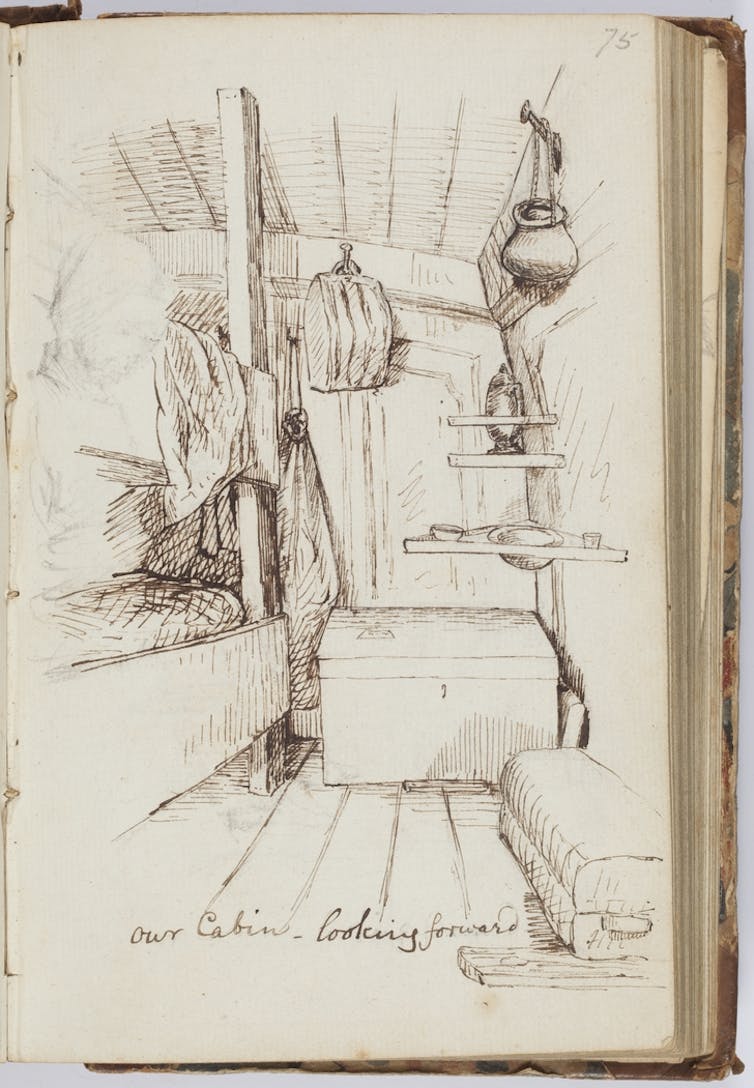
Diaries were sometimes a mechanism to cope with boredom and frustration. Jane Swan, 13, was impatient to reach Australia in 1853. She was sick of the “very long voyage” and felt “to see the same things, and the same faces, becomes very tiresome”.
Working-class girls were subject to strict conditions. On her voyage to Brisbane in 1863, 14-year-old Welsh girl Maria Steley noted in her diary the “young women are put Down every night at six O clock” and “are not Allowed to speak to the young men”.

As a working-class teenager, Maria was separated from her family and housed with the single women. Wealthier girls would stay with their families in private cabins.
Among such shared conditions, girls could also make friends. Maria wrote she and her new pals “have many bits of fun more than i thought we would” by “singing and Dancing and playing eney thing we like untill 10 O clock then we go to bed we Play four howrs after we are Loch Down”.
But shipboard travel generated loneliness for many girls. Working-class Scottish woman Mary Maclean, who was 22 when she voyaged to Sydney in 1865, experienced homesickness, often “Sheding a tear and often Wonder if thay miss one at Home”.
Joy And Sadness
Girls also used diaries to record their fears. Illness could tear through the close confines of a ship.
Sarah Raws, 15 when she sailed to Melbourne in 1854, was preoccupied with the proximity of death, including that of two infant boys and the “very sudden” death of a lady in Sarah’s own cabin.
Emily Braine, ten years old when she embarked in 1854, was “frightened” by large waves and rough seas. The risk of shipwreck was low, but the possibility played on Emily’s mind.
Towards the end of their journey, some girls were excited to disembark. Sarah Raws rejoiced “"when we first saw land” from the ship’s deck. But others experienced a resurgence of homesickness and doubt.

Nearing Melbourne in 1874, 19-year-old Ally Heathcote had feelings “of a mingled character, joy and sadness”. She felt torn between her old life in England and her new life in Victoria.
Ally’s writings helped her deal with these “mingled” feelings. Her diary, she wrote,
has helped to keep me employed during the passage and many times I have turned to it when my thoughts would stray over the sea, and have written the account of the day’s proceedings when otherwise I should have begun to mope.
Most girls concluded their diaries at the end of their voyage before they started on a new life. Some made copies and sent the account “home” to Britain for family and friends to peruse.
The diary became a record and a keepsake of a life-changing journey.
Girls’ shipboard diaries reveal the complex and varied emotions of people from the past and provide insight into the human experience of migration. These sources centre girls in the migration narrative, giving a voice to an often-overlooked group.
It is a shame so few survive. ![]()
Catherine Gay, PhD Candidate in History, The University of Melbourne
This article is republished from The Conversation under a Creative Commons license. Read the original article.
Hornsby Renal Dialysis Service Means Kidney Patients Receive Care Closer To Home
- Fit out of two rehabilitation inpatient units
- Refurbishment and expansion of psychiatric emergency care centre
- Outpatient ambulatory care services, including the provision of a day chemotherapy unit
- Expansion of oral health services
- Integration of community health services
- A helipad.
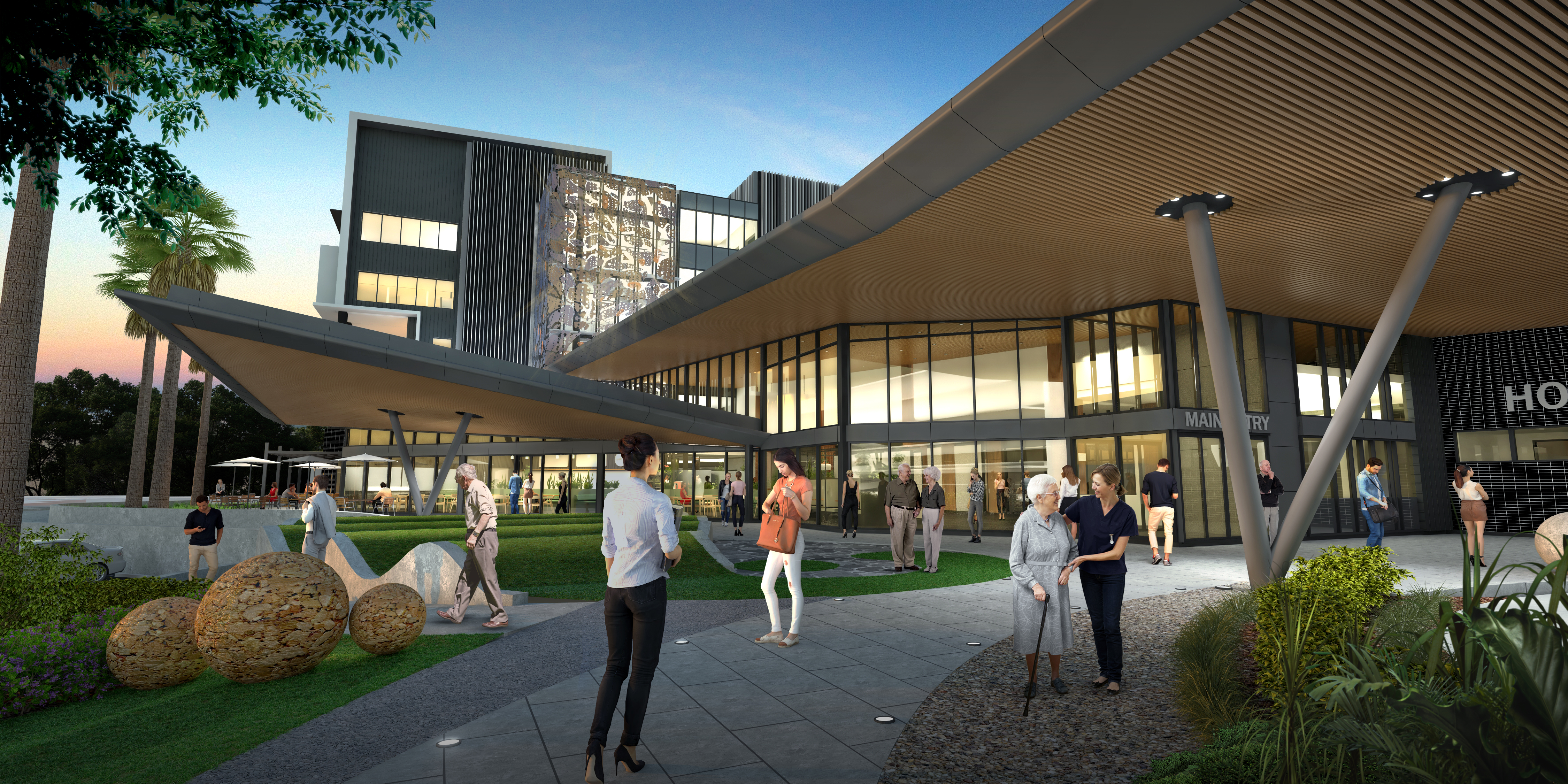
80 New Purpose Built 4WD Ambulances Will Reach Patients In Challenging Terrain
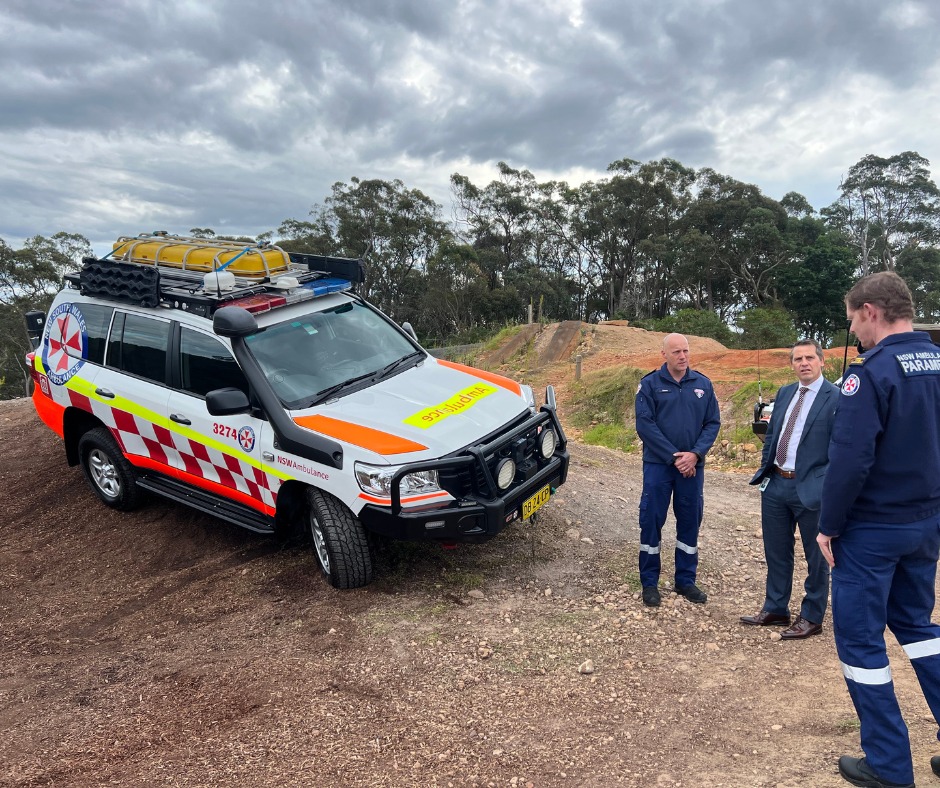
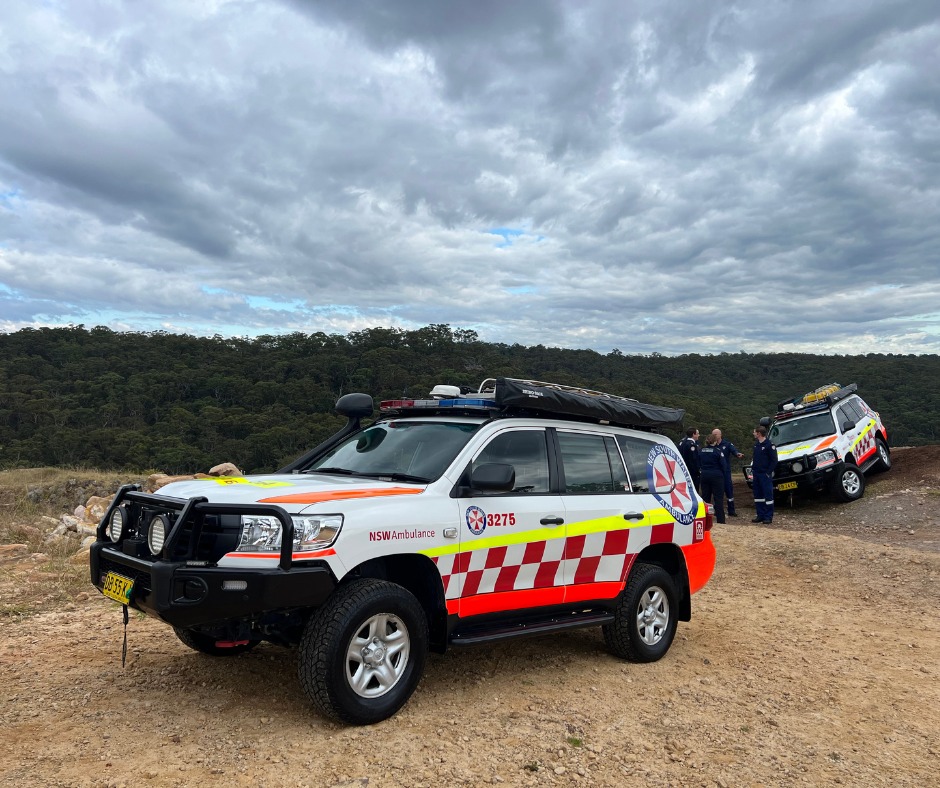
Need a mental health day but worried about admitting it? You’re not alone

There are days when it’s hard to face work, even when you aren’t physically sick. Should you take a day off for your mental health? If you do, should you be honest about it when informing your manager?
If you work for an organisation or in a team where you feel safe to discuss mental health challenges, you are fortunate.
Despite all the progress made in understanding and talking about mental health, stigma and prejudices are still prevalent enough to prevent many of us from willingly letting bosses and coworkers know when we are struggling.
Mental health challenges come in different forms. For some it will be a severe lifelong struggle. For many others the challenge will be periods of feeling overwhelmed by stress and needing a break.
Globally, the World Health Organisation estimates about 970 million people – about one in eight people – is suffering a mental disorder at any time, with anxiety-related disorders affecting about 380 million and depression about 360 million.
These numbers have jumped about 25% since 2019, a rise credited to the social isolation, economic hardship, health concerns and relationship strains associated with the pandemic.
But declining mental health is a longer-term trend, and it’s likely work demands have also played a role. Research identifies three main workplace contributors to mental ill-health: imbalanced job design when people have high job demand yet low job control, occupational uncertainty, and lack of value and respect.
This at least partly explains why depression and anxiety appear to be more prevalent in wealthy industrialised nations. In the United States, for example, it is estimated more than half of the population will experience a diagnosable mental disorder at some point during their lifetime.
Managerial Attitudes Changing Slowly
For the modern workplace, therefore, mental health is increasingly part of the landscape. But preconceptions and prejudices are hard to shift. People with these challenges are still seen as weak, unstable or lacking competence.
These attitudes make it even harder for those with diagnosed mental health disorders to find meaningful work and progress in their careers.
Business executives and managers, like the rest of the population, have limited knowledge of mental health issues, or skills to manage it in the workplace.
This blind spot is reflected in the management research literature. The best most recent study of managerial understanding of mental health issues dates from 2014. It found only about one in ten human resource professionals and managers felt very confident in supporting employees with mental health challenges.

Even when managers understand there are implicit biases against employees with mental health challenges, they may still not know what to do about it.
So it is hardly surprising many employees remain reluctant to disclose their mental challenges to colleagues and managers, fearing a lack of understanding and potential negative consequences to their careers. But keeping it secret and “soldiering on” can make mental health even worse.
Framing The Conversation
So what to do about it? Our research shows leadership is key.
For all organisations, cultural change can start with leaders and managers speaking more openly about their own mental health challenges. This empowers others to follow suit.
Language choices are important too. How we talk about mental health can change how we think about it. Australia’s National Mental Health Commission, for example, refers to “mental health challenges” instead of “mental illness”. Such framing can help others to regard a mental health day as something that may be needed by anybody, not something for some who is “sick”.
For larger organisations, one innovative idea is to have “mental health advocates” – employees with personal experience of severe mental health challenges.
Energy Queensland, a government-owned utility with about 7,600 staff who are responsible for maintaining the state’s electricity distribution infrastructure, did this in 2017. Two of its workers, James Hill and Aaron McCann, now work as full-time “mental health lived experience advocates”. Hill previously worked for the corporation as an electrician and McCann as a lineworker. Both have lived through deep depression and suicidal thoughts.
Our research – which involved surveying more than 300 psychologists, psychiatrists and others employed in mental health services – suggests “lived experience” advocates encourage more open organisational cultures, helping to break down the stigma stopping others from admitting their own mental health challenges.
And a small number of organisations globally have introduced “wellness/wellbeing days” – an allotment of “no certificate required” days off, which can be used at any time, no questions asked.
As the challenge of squeezing greater productivity out of service sectors intensifies and competition for skills and talent escalates, those workplaces that acknowledge and accommodate the mental health stresses of modern life will be the ones with the competitive advantage.![]()
Lena Wang, Associate Professor in Management, RMIT University; Louise Byrne, RMIT Fulbright Fellow, RMIT University, and Timothy Bartram, Professor of Management, RMIT University
This article is republished from The Conversation under a Creative Commons license. Read the original article.
Older Trees Accumulate More Mutations Than Their Younger Counterparts
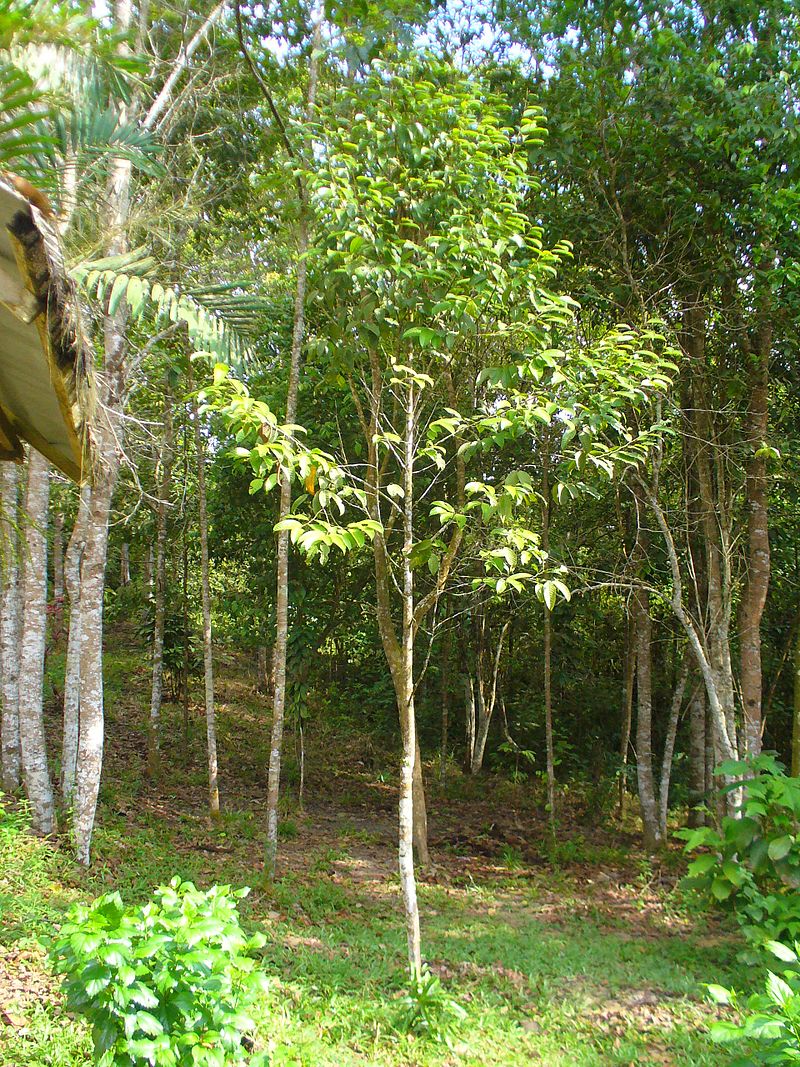
Remains Of An Extinct World Of Organisms Discovered
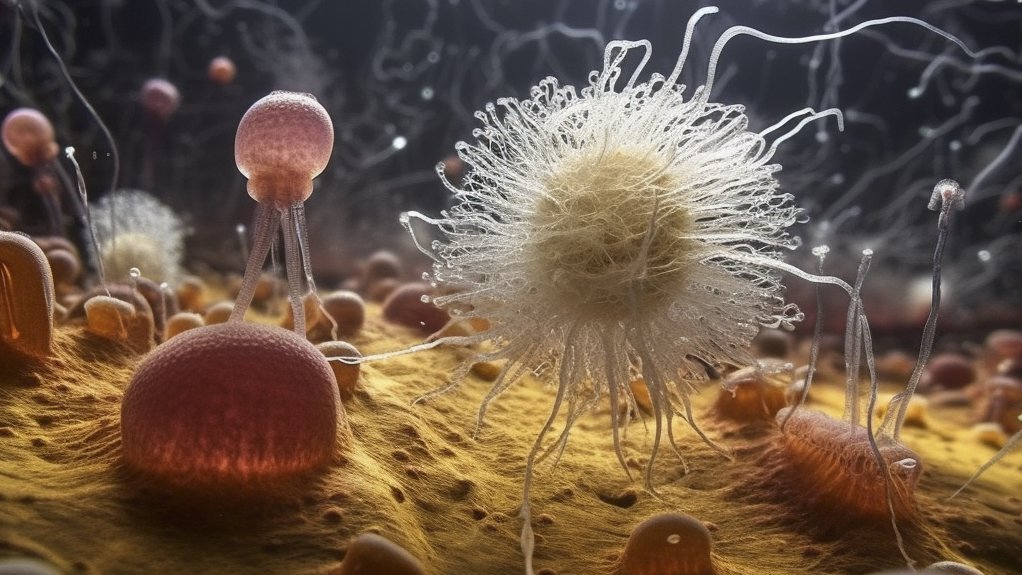
First Side-Necked Turtle Ever Discovered In UK
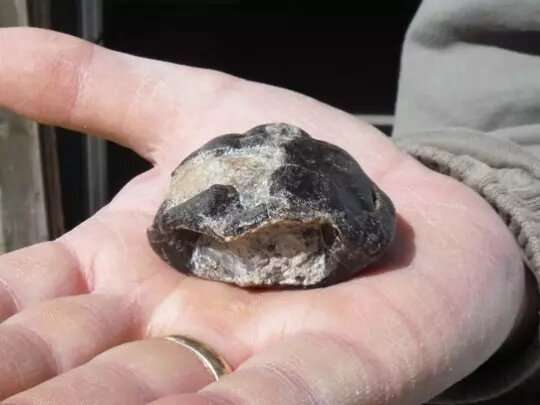
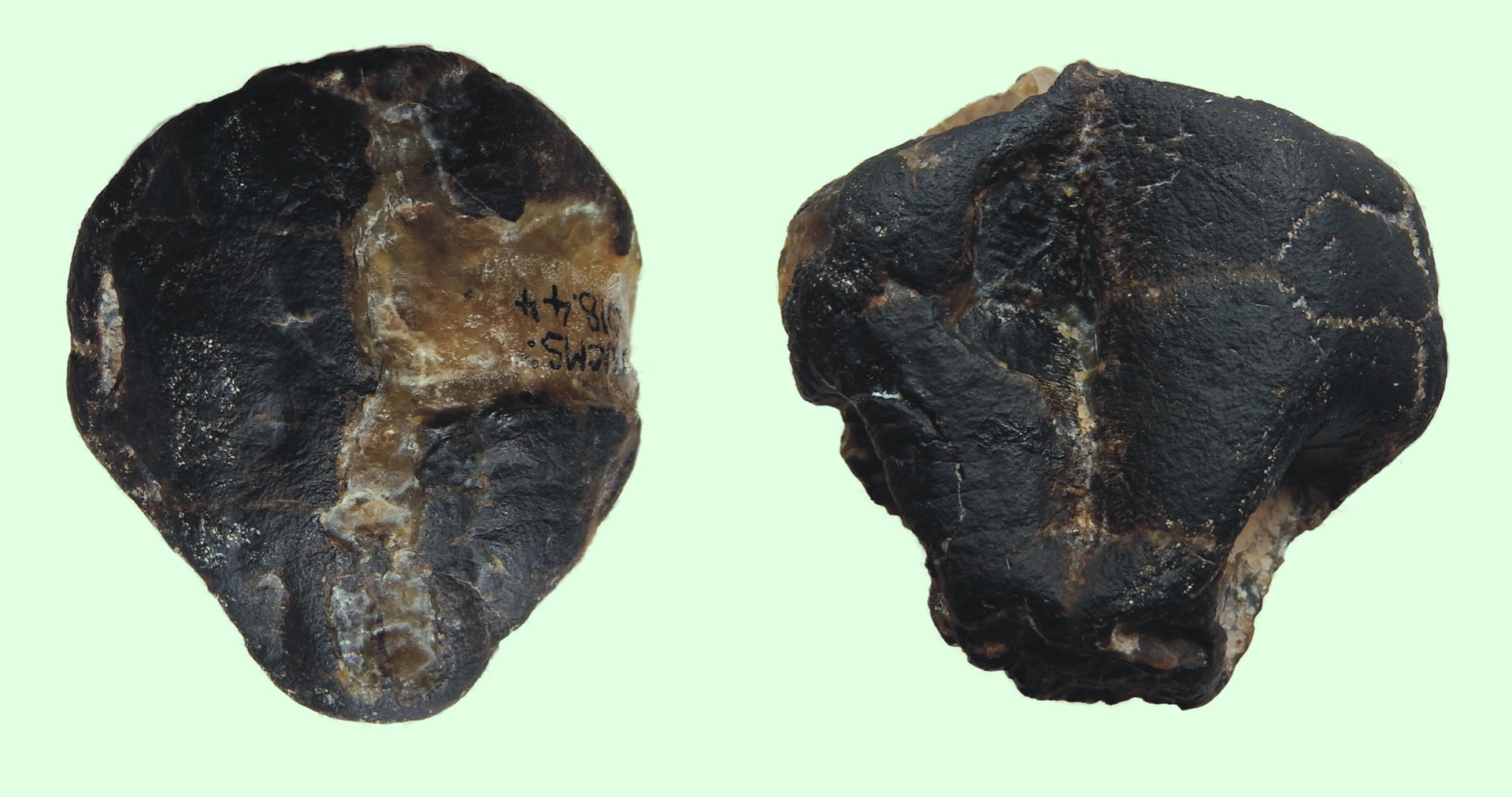
‘Help, my kids keep getting head lice!’ Here’s how to break the cycle of nits

Wrangling head lice, and the children they infest, must be up there with the most challenging duties a parent or carer has to face.
Primary school-aged children, who seem to always be in close proximity to one another, are the most susceptible to lice.
But by exploiting the screen-sharing and selfie-taking habits of tweens and teens, these little parasites are finding more ways to spread.
And they’re no easier to kill off.
What Are Head Lice And Nits?
Head lice, known by their scientific name Pediculus humanus capitis, are tiny insects that are only found among the hair on a human’s head. They’re not found anywhere else on the planet.
They scuttle up and down shafts of hair. They have perfectly designed claws, that look a little like carabiners, allowing them to move about how a rock climber uses guide ropes. They’re agile on our hair, but clumsy once they’re off.
They don’t jump or fly. They move from head to head through direct physical contact.

Our hair is their home but our blood is their food. Head lice feed on the scalp and have specially designed mouth-parts to suck out blood up to a half dozen times a day. It means child with an average sized infestation of head lice may give up less than 0.01 ml of blood per day.
When it comes time to lay eggs, that we affectionately refer to as “nits”, the lice don’t want the more than 100 or so eggs they can produce in a lifespan just rolling off our heads. They “cement” their eggs to the shafts of hair. It’s some of the best “superglue” you can find!
Once laid, the eggs will hatch within a few days. Within a week, the lice are ready to lay more eggs. The adult lice can live for up to a month if conditions are right.
My Child Has Head Lice, Should I Be Worried?
While closely related lice have been implicated in the spread of some of the most dangerous and deadly pathogens to human health, head lice are much more benign. They’re annoying but won’t make us sick.
Their bites may cause an itchy irritation to our skin. Our bodies react to the saliva they inject when they bite. In the same way we all vary in our reaction to mosquito bites, the same differences result from lice bites. Some people will hardly notice them, others will be driven wild with itchiness.

Health authorities in Australia do not consider head lice a risk of transmitting pathogens that are harmful to humans.
There is no doubt they’re annoying but perhaps the greatest health threat of head lice is to the health and well-being of parents responsible for their eradication.
Do We Really Need Chemicals?
“Just kill them all, whatever it takes” is a common refrain among those trying to rid their children of the latest round of infestation.
There is a wide range of products available at your local pharmacy to treat head lice. These products should be registered with the Therapeutic Goods Administration and be assessed as both safe and effective to use. Most of these products are insecticides that kill the lice on contact.
However, evidence seems to be mounting that some of these insecticides aren’t working as well as they once did. Resistance in head lice to commonly used products may be the result of their excessive or incorrect use. The more lice that escape a treatment, the greater the chances of them developing resistance in much the same way bacteria are developing tolerance and resistance to commonly used antibiotics.
Head lice are still susceptible to alternative approaches. Products derived from Australian plants, such as tea tree or eucalyptus, may be better than insecticides. But these are still chemicals.
All these products should be used in accordance with the directions for safe use.
A range of products are marketed as “repelling” head lice. But there is little evidence these are a reliable way to avoid picking up head lice from your friends or family.

Is There A Chemical-Free Approach?
A strong recommendation by health authorities in Australia is to skip the sprays, creams, and lotions and embrace the “conditioner and comb” or “wet comb” method and physically remove the lice.
This is not just good advice for those not wanting to avoid chemicals, it overcomes having to deal with insecticide-resistant lice.
The steps in this process are relatively straight forward.
To immobilise the lice, apply hair conditioner to the child’s damp hair. Then use a fine toothed “lice comb” to systematically work through the hair and remove adult lice. Regularly wiping the comb on tissues or paper towel will reveal the dispatched lice.
This approach works but must be repeated twice, about a week apart, to break the life cycle of the head lice.
Head lice eggs are less susceptible to treatment, no matter what treatment you choose. As all the eggs will hatch within a week or so, repeating treatments again and targeting the adult lice before a new batch of eggs is laid will provide the best results.
The secret to effective eradication of the infestations is patience and persistence. Perhaps a new practice in mindfulness?
Will Our Household Ever Be Free Of Them?
Head lice are a normal part of life for young children. It doesn’t matter how clean and tidy your house is, you’ll inevitably have to deal with an infestation.
Frequent washing of bed sheets, towels, and vacuuming floors won’t keep them away. Head lice don’t survive long out of our hair so you’re unlikely to pick them up from carpet, furniture, or even sharing hats. They don’t float around in swimming pools either.
If a child has persistent infestations and has an adverse reaction to the head lice, consult your local health professional. There are some alternative options, including some medications, that may also assist in reducing the bite reactions as well as the infestation itself.![]()
Cameron Webb, Clinical Associate Professor and Principal Hospital Scientist, University of Sydney
This article is republished from The Conversation under a Creative Commons license. Read the original article.
What is a ‘toroidal propeller’ and could it change the future of drones? An expert explains

The basic configuration of traditional propellers has not fundamentally changed since the first powered flight by the Wright brothers in 1903.
However, as engineers learn more about aerodynamics and attempt new experiments, propellers are evolving to more complex shapes. These feature multiple blades, high sweep angles, blade tip devices and other features to optimise performance in different conditions.
A recent advancement in propeller technology are “toroidal” propellers. These devices are ring-shaped, with the blades looping around each other. A few recent articles and videos have been hyping these – but how “revolutionary” are they, really?
Refining The Shape
In 2017, researchers at MIT filed a patent for toroidal propellers. Their patent claims the invention is more efficient than traditional propellers and is less noisy.
Coincidentally, already in 2012, US engineering company Sharrow Marine also developed a toroidal propeller for boats; they have demonstrated it to be more efficient and quieter than traditional marine propellers.
The reason toroidal propellers may be quieter is because of their complex shape – it minimises the strength of the vortex (a spiralling movement of air, water, or another fluid) that naturally happens over propeller blade tips.
This happens because there’s a high-pressure region under the blade, and low pressure above it. As high-pressure air from under the blade moves towards the low-pressure region above it, it travels in a spiral – a vortex.

This phenomenon is not unique to propeller blades, which are essentially rotating wings. The wing of a plane also experiences this phenomenon. Engineers have done much research on wingtip devices that can minimise this.
The use of closed-loop structures – like in a toroidal propeller – is one way of reducing tip vortices.
Even though the basic propeller shape has remained the same since its invention, many propeller blade designs have been put forward. To test these, engineers need to perform design trade-off studies. Some of these approaches have been tested to try and make helicopter blades and drones more efficient and less noisy.
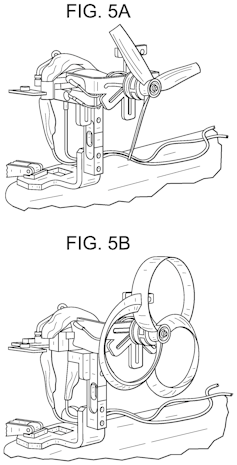
No Magic Propeller
It’s important to understand propeller geometry must be optimised for a specific “operational envelope”. This means the properties of the fluid or air it operates in, rotation speed, forward speed, and other details. Outside that envelope, the propeller will perform poorly.
So far, nobody has achieved the magical propeller geometry that will achieve low noise and high efficiency for all operating conditions and scales. Toroidal propellers are no exception – from the sparse results available so far, their advantages are not yet fully quantified.
Comparing a well-designed toroidal propeller to a poorly designed traditional propeller will show a significant improvement, but is not a fair comparison.
Well-designed toroidal propellers may have advantages in specific operating conditions, such as dense fluids or a specific range of speeds. However, the question remains as to how a toroidal propeller compares to a well-designed traditional propeller for the same conditions.
This is a challenge, since improvements are always relative to a benchmark – which may not be the most efficient design to start with.
Another aspect of a fair comparison that doesn’t seem to have been published for toroidal propellers is comparing different propellers at the same thrust force. Only then you can see the true advantages regarding noise reduction and energy required to spin the propeller.
Home Experiments Are Not Representative
An MIT announcement earlier this year about toroidal propellers winning one of MIT Lincoln Laboratory’s 2022 R&D 100 Awards generated significant excitement. There’s been widespread experimentation with 3D-printed toroidal propellers, but not all of these have delivered positive results.
This may be due to un-optimised geometry and poor scientific rigour by the general public conducting some of these experiments. This gives the scientific community a research opportunity – to truly assess and optimise toroidal and traditional propellers to enhance their performance.
Previous optimisation studies have been conducted, some of which even use machine-learning techniques to identify suitable geometries. Engineers are also trying to make propellers that sound less annoying, by considering how humans perceive sound.
Expensive And Hard To Scale
Toroidal propellers also have clear disadvantages. The main one is the difficulty to scale them to mass production due to their complex geometry, which leads to high production costs.
The complex structure also requires special care to avoid unwanted vibrations – a significant issue when rotating at high speeds. This also adds to higher manufacturing costs.
When it comes to using toroidal propellers for drones, their heavier weight will also have implications on the responsiveness and stability of the drone. This is critical when operating in windy and turbulent conditions such as windy weather.
Overall, toroidal propellers are an exciting recent development in propeller design, at least in some cases. While they can be more quiet, they won’t completely replace traditional props just yet – there’s no single propeller design that will suit all situations.![]()
Abdulghani Mohamed, Senior Lecturer in Aerospace Engineering, RMIT University
This article is republished from The Conversation under a Creative Commons license. Read the original article.
Do you need to wash rice before cooking? Here’s the science

Rice is a staple food for billions of people in Asia and Africa. It’s also a versatile ingredient for many iconic dishes from around the world, including dolmades from Greece, risottos from Italy, paella from Spain and rice puddings from the United Kingdom.
Despite its universal appeal, the question asked in every kitchen, be it a professional one or your own home, is whether you should pre-wash (or rinse) your rice before cooking.
What Do Chefs And Cooks Say?
Culinary experts claim pre-washing rice reduces the amount of starch coming from the rice grains. You can see this in the cloudy rinse water, which studies have shown to be the free starch (amylose) on the surface of the rice grain produced by the milling process.
In culinary circles, washing is advocated for some dishes when a separated grain is sought after. Yet for other dishes such as risottos, paella and rice puddings (where you need a sticky, creamy effect), washing is avoided.
Other factors, such as the type of rice, family tradition, local health warnings and even the perceived time and effort required will influence whether people pre-wash their rice.

Is There Evidence That Washing Rice Makes It Less Sticky?
A recent study compared the effect of washing on the stickiness and hardness of three different types of rice from the same supplier. The three types were glutinous rice, medium grain rice and jasmine rice. These different rices were either not washed at all, washed three times with water, or washed ten times with water.
Contrary to what chefs will tell you, this study showed the washing process had no effect on the stickiness (or hardness) of the rice.
Instead, the researchers demonstrated the stickiness was not due to the surface starch (amylose), but rather a different starch called amylopectin that is leached out of the rice grain during the cooking process. The amount leached differed between the types of rice grains.
So, it’s the variety of rice – rather than washing – that’s critical to the stickiness. In this study, glutinous rice was the stickiest, while medium grain rice and jasmine rice were less sticky, and also harder as tested in the laboratory. (Hardness is representative of the textures associated with biting and chewing.)

You May Still Want To Wash Your Rice, Though
Traditionally rice was washed to rinse off dust, insects, little stones and bits of husk left from the rice hulling process. This may still be important for some regions of the world where the processing is not as meticulous, and may provide peace of mind for others.
More recently, with the heavy use of plastics in the food supply chain, microplastics have been found in our foods, including rice. The washing process has been shown to rinse up to 20% of the plastics from uncooked rice.
This same study found that irrespective of the packaging (plastic or paper bags) you buy rice in, it contains the same level of microplastics. The researchers also showed plastics in (pre-cooked) instant rice have been found to be fourfold higher than in uncooked rice. If you pre-rinse instant rice, you could reduce plastics by 40%.
Rice is also known to contain relatively high levels of arsenic, due to the crop absorbing more arsenic as it grows. Washing rice has been shown to remove about 90% of bio-accessible arsenic, but it also rinses out a large amount of other nutrients important for our health, including copper, iron, zinc and vanadium.
For some people, rice offers a small percentage of their daily intake of these nutrients and hence will have a small impact on their health. But for populations that consume large amounts of heavily washed rice daily, it could impact their overall nutrition.
Another study looked at other heavy metals, lead and cadmium, in addition to arsenic; it found that pre-washing decreased levels of all these from between 7–20%. The World Health Organization has warned of the risk of arsenic exposure from water and food.
Arsenic levels in rice vary depending on where it’s grown, the cultivars of rice and the ways it is cooked. The best advice remains to pre-wash your rice and ensure you consume a variety of grains. The most recent study in 2005 found that the highest level of arsenic was in the United States. However it is important to keep in mind that arsenic is present in other foods including products made from rice (cakes, crackers, biscuits and cereals), seaweed, seafood and vegetables.
Can Washing Rice Prevent Bacteria?
In short, no. Washing rice will have no effect on the bacterial content of the cooked rice, as high cooking temperatures will kill all bacteria present.
What is more concerning is how long you store cooked rice or washed rice at room temperature. Cooking rice does not kill the bacterial spores from a pathogen called Bacillus cereus.
If wet rice or cooked rice is kept at room temperature, this can activate the bacterial spores and they begin to grow. These bacteria then produce toxins which can not be deactivated by cooking or re-heating; these toxins can cause severe gastrointestinal disease. So, make sure you avoid keeping washed or cooked rice at room temperature for too long.![]()
Evangeline Mantzioris, Program Director of Nutrition and Food Sciences, Accredited Practising Dietitian, University of South Australia
This article is republished from The Conversation under a Creative Commons license. Read the original article.
Bones, the ‘Cave of the Monkeys’ and 86,000 years of history: new evidence pushes back the timing of human arrival in Southeast Asia
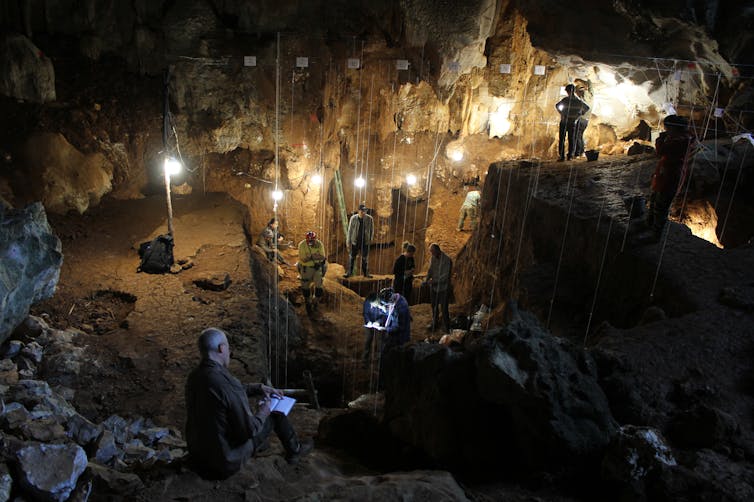
In 2009, when our team first found a human skull and jaw bone in Tam Pà Ling Cave in northern Laos, some were sceptical of its origin and true age.
When we published a timeline in 2012 for the arrival of modern humans in mainland Asia around 46,000 years ago based on the Tam Pà Ling evidence, the sceptics remained.
In short, the site was given a bad rap. One of the most interesting caves in mainland Southeast Asia was frequently overlooked as a possible route on the accepted path of human dispersal in the region.
However, in new research published today in Nature Communications, we report more human remains found in Tam Pà Ling – and a more detailed and robust timeline for the site. This shows humans reached the region at least 68,000 years ago, and possibly as long as 86,000 years ago.
Plenty Of Evidence, But Hard To Date
Our team of Laotian, French, US and Australian researchers has been excavating at Tam Pà Ling for many years. You can see a detailed, interactive 3D scan of the site here.
As we dug, we found more and more evidence of Homo sapiens at earlier and earlier times.
First there was a finger bone, then roughly 2.5 metres deeper, a chin bone, then part of a rib. In total, eight pieces were found in only 4.5 metres of sediment – which may not sound like a lot, but is huge in archaeological terms.

Surely, we thought, this would be enough for Tam Pà Ling to take its place among the early human arrival sites in Southeast Asia.
But a hurdle remained: the cave is hard to date. This has prevented its significance being recognised, and without a convincing timeline the cave’s evidence will not be included in the debate over early human movements.
Many Common Dating Methods Can’t Be Used
There are a few difficulties with dating Tam Pà Ling.
First, the human fossils cannot be directly dated as the site is a world heritage area and the fossils are protected by Laotian laws.
Second, there are very few animal bones and no suitable cave decorations, either of which might be used for dating.
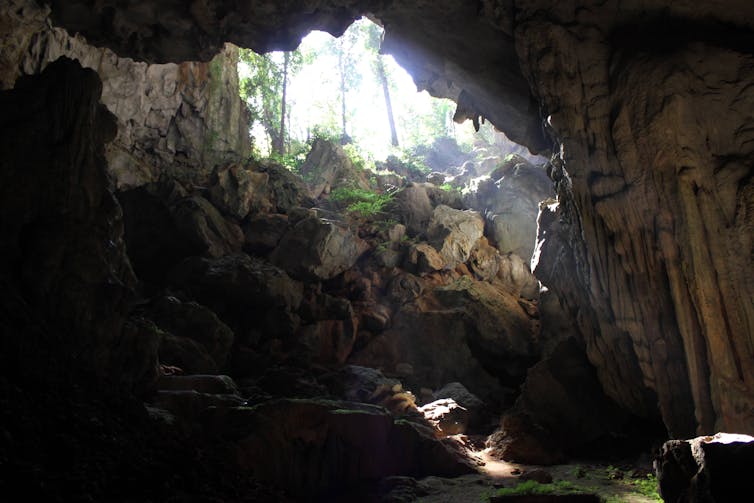
And third, the entrance of the site is wide and steep. This means any charcoal found in the cave, which is useful for dating, may well have come from outside – so it has little relation to the age of the sediment inside.
This means the backbone of the timeline must be established by the dating of the sediment itself, using techniques such as luminescence dating.
Signals In Buried Minerals
Luminescence dating relies on a light-sensitive signal that builds up in buried sediment, resetting to zero when it is exposed to light.
This technique mainly uses two minerals: quartz and feldspar.
Quartz can only be used in the younger levels as it is limited by how much signal it can hold. In the deeper layers it can often underestimate the age, so in Tam Pà Ling we only used quartz to date the top three metres of the sediment.
For the lower levels (four to seven metres), we had to switch to dating using feldspar to fill in the gap in the age profile. Below six metres the feldspar grains started to weather and we had to resort to fine-grain dating, using tiny mineral grains all mixed together.
Dating Teeth
Tam Pà Ling is relatively poor in animal evidence. Yet, eventually two teeth from a cow-like animal were unearthed at 6.5 metres deep that could be dated using two distinct techniques.
Uranium series dating works by measuring uranium, and the elements into which it transforms via radioactive decay, within the tooth. Electron spin resonance dating relies on measuring the number of electrons in tooth enamel.
Each technique offers an individual numerical age for the fossil. By combining the two, we obtained robust direct dates, which can complement the luminescence chronology.
A Closer Look At Sediment
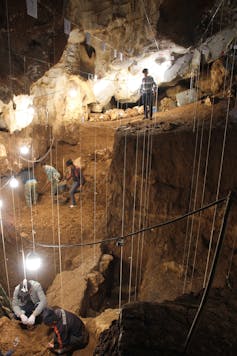
To make the dating as strong as possible, we used every technique we could, such as applying uranium series dating to a stalactite tip that had been buried in sediment.
We also began to support all our dating evidence with a very detailed analysis of the sediments to assess the origin of the fossils.
Micromorphology is a technique that examines sediments under a microscope to establish the integrity of the layers that buried the fossils.
This is a key component of the new chronology, as it helped establish that there was a fairly consistent accumulation of sediment layers over a long period.
By 2022, we had amassed an array of dating evidence that could be modelled to determine the exact age of each layer and the fossils they buried.
A Stop On The Route Of Human Dispersal
Our updated chronology revealed humans were present in the vicinity of Tam Pà Ling Cave for roughly 56,000 years. It also confirmed that, far from reflecting a rapid dump of sediments, the site contains sediments that accumulated steadily over some 86,000 years.
The age of the lowest fossil, a fragment of a leg bone found seven metres deep, suggests modern humans arrived in this region between 86,000 and 68,000 years ago.
The evidence from Tam Pà Ling has pushed back the timing of Homo sapiens arrival in Southeast Asia. This suggests the mainland, along with the coastal and island locations, may have also been a viable dispersal route.
Tam Pà Ling is just a stone’s throw from Cobra Cave, where we found a tooth some 150,000 years old belonging to a Denisovan, the now-extinct human relatives otherwise known only from remains found in Siberia and Tibet. This suggests the site may lie on a previously used dispersal route among hominins.
Tam Pà Ling continues to reveal pieces of the puzzle of the ancient human journey across the world. Only time will tell how many more it has in store.![]()
Kira Westaway, Associate Professor, School of Natural Sciences, Macquarie University; Meghan McAllister-Hayward, PhD Candidate; Mike W Morley, Associate Professor, Flinders University; Renaud Joannes-Boyau, Associate Professor, Southern Cross University, and Vito C. Hernandez, PhD Candidate
This article is republished from The Conversation under a Creative Commons license. Read the original article.
Disclaimer: These articles are not intended to provide medical advice, diagnosis or treatment. Views expressed here do not necessarily reflect those of Pittwater Online News or its staff.